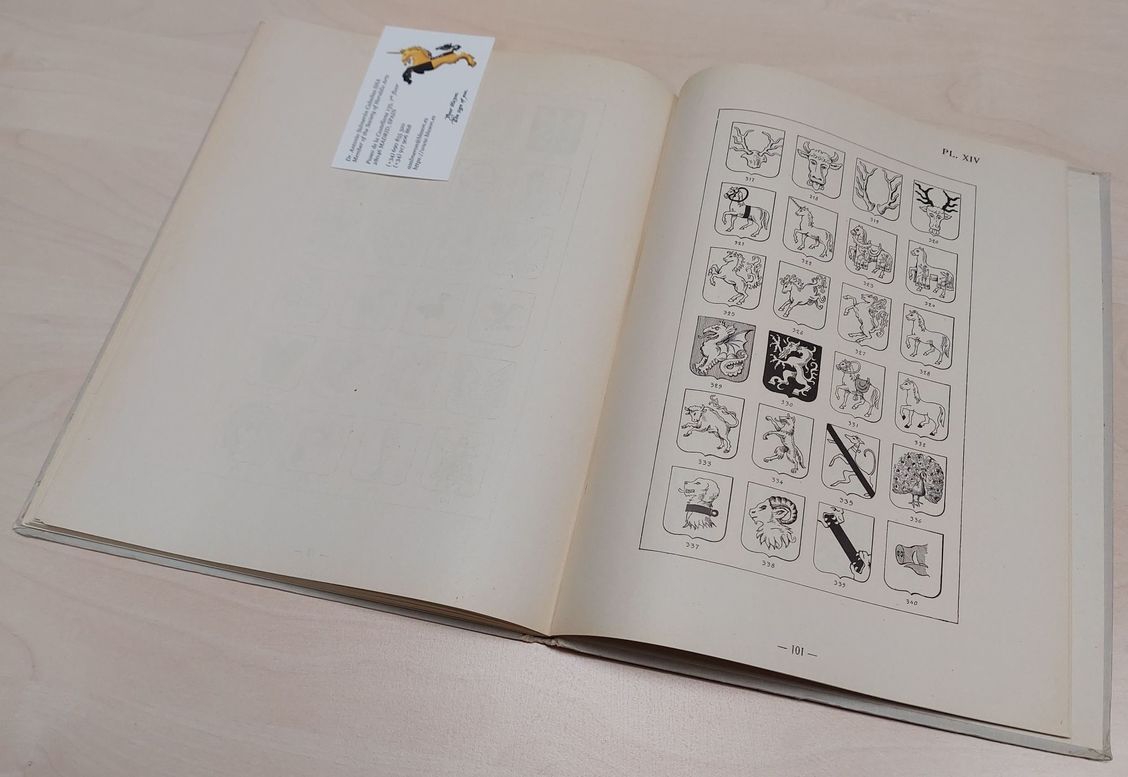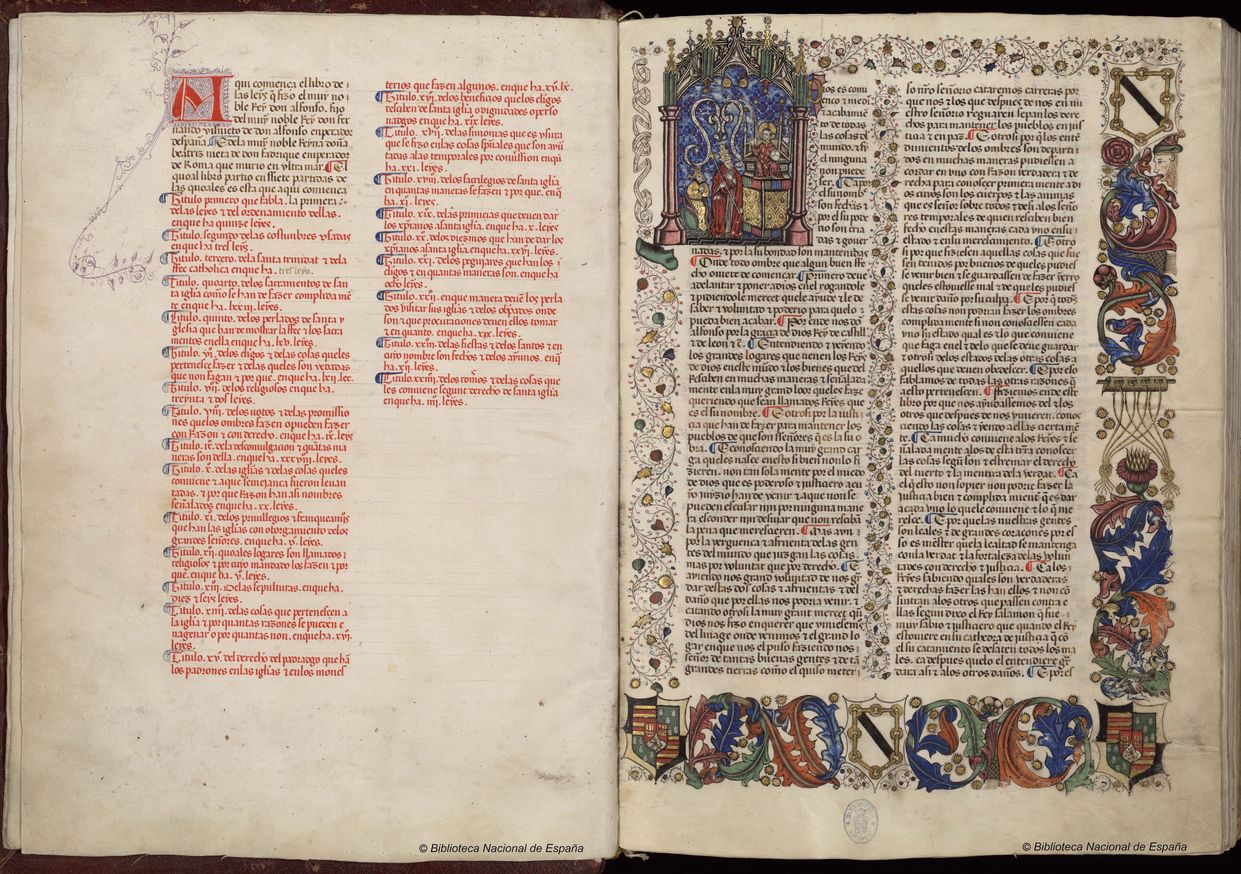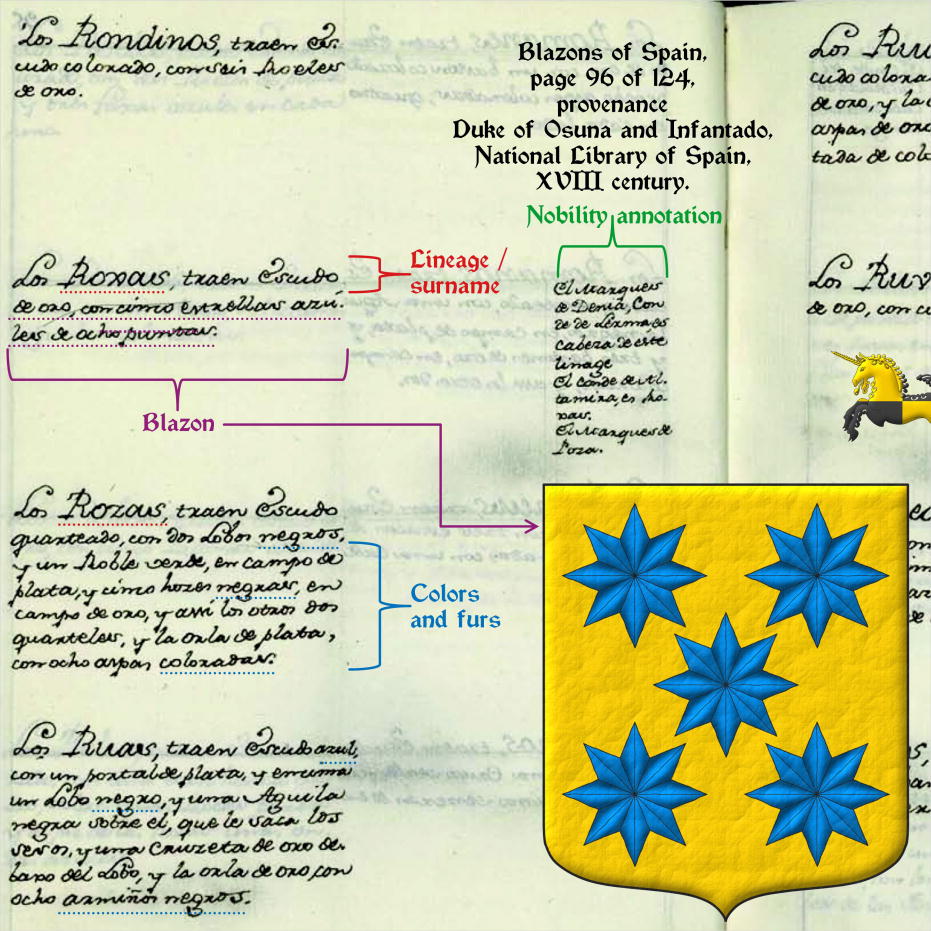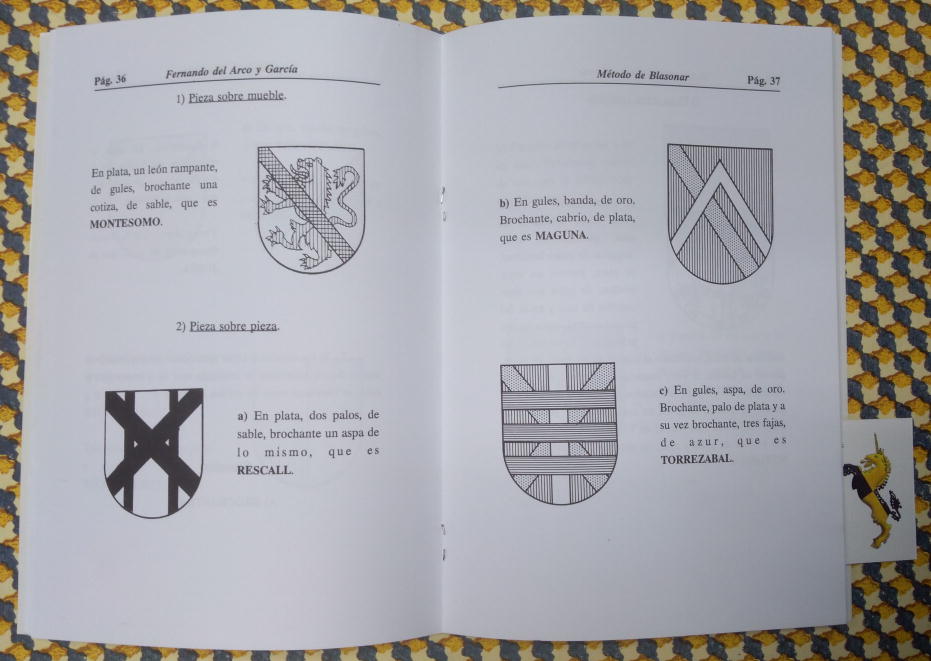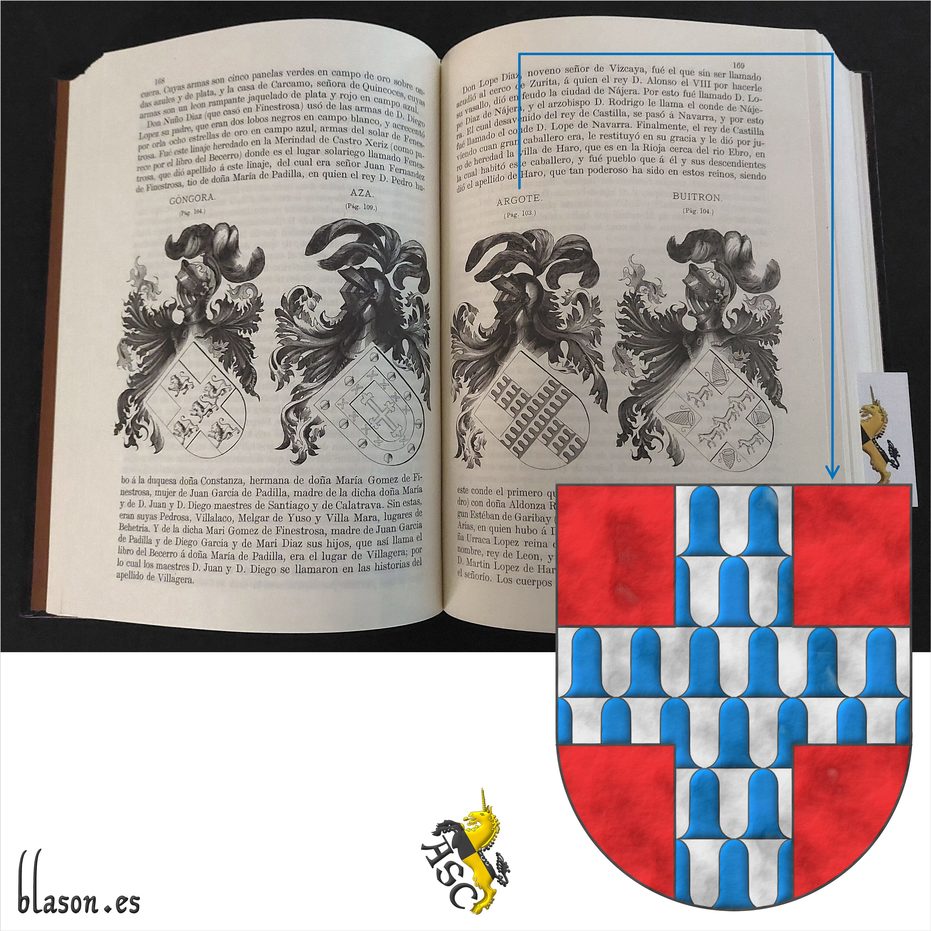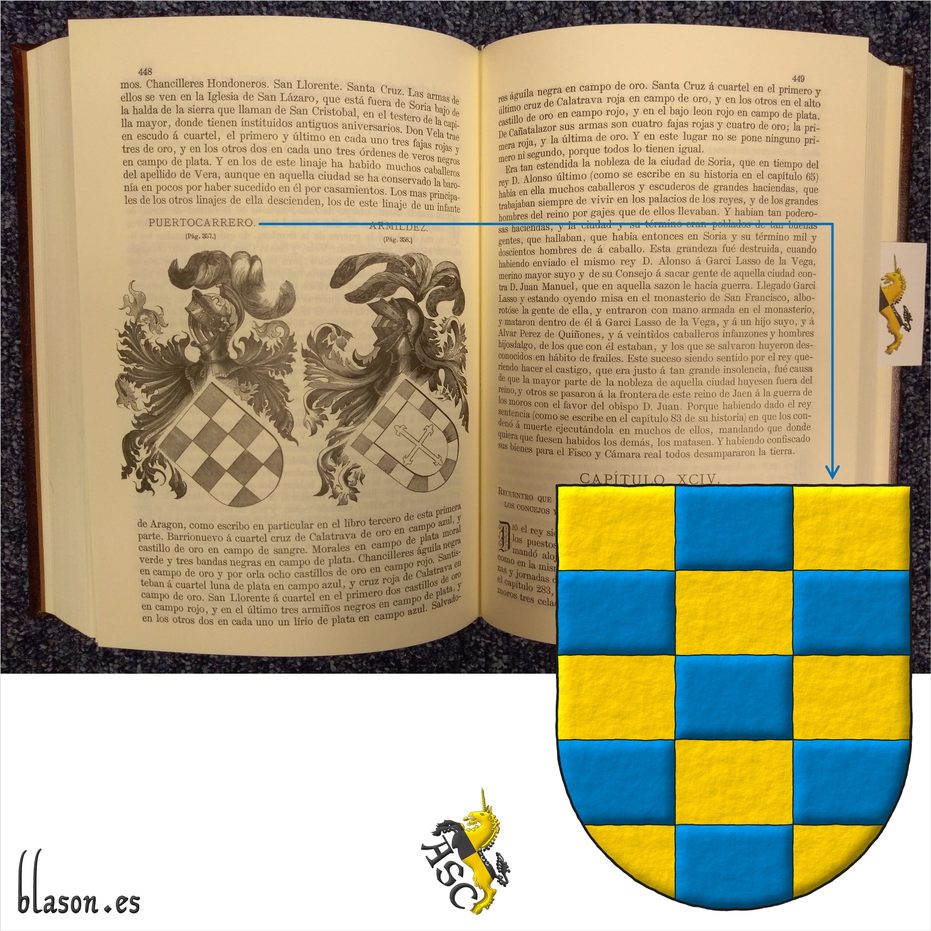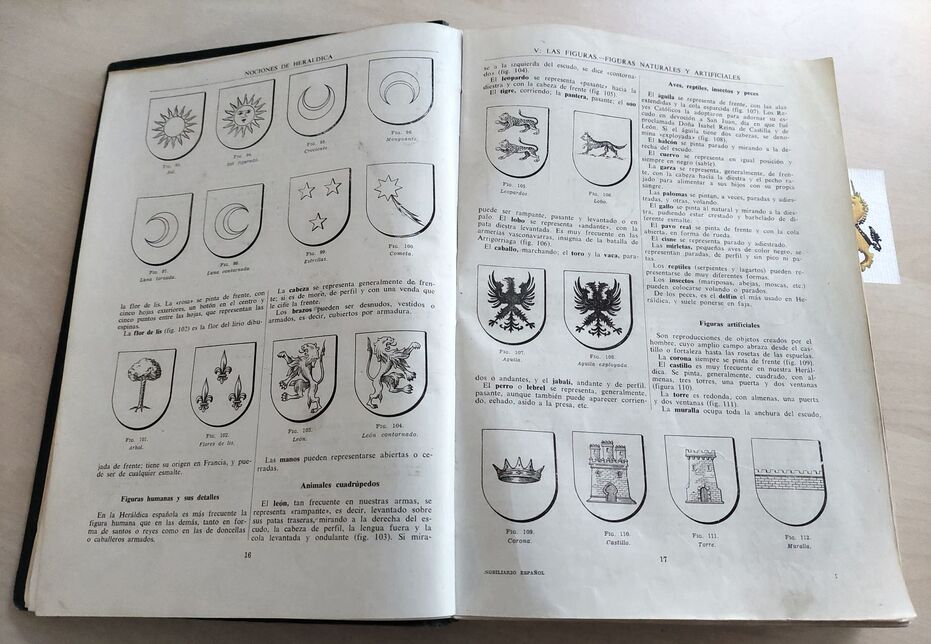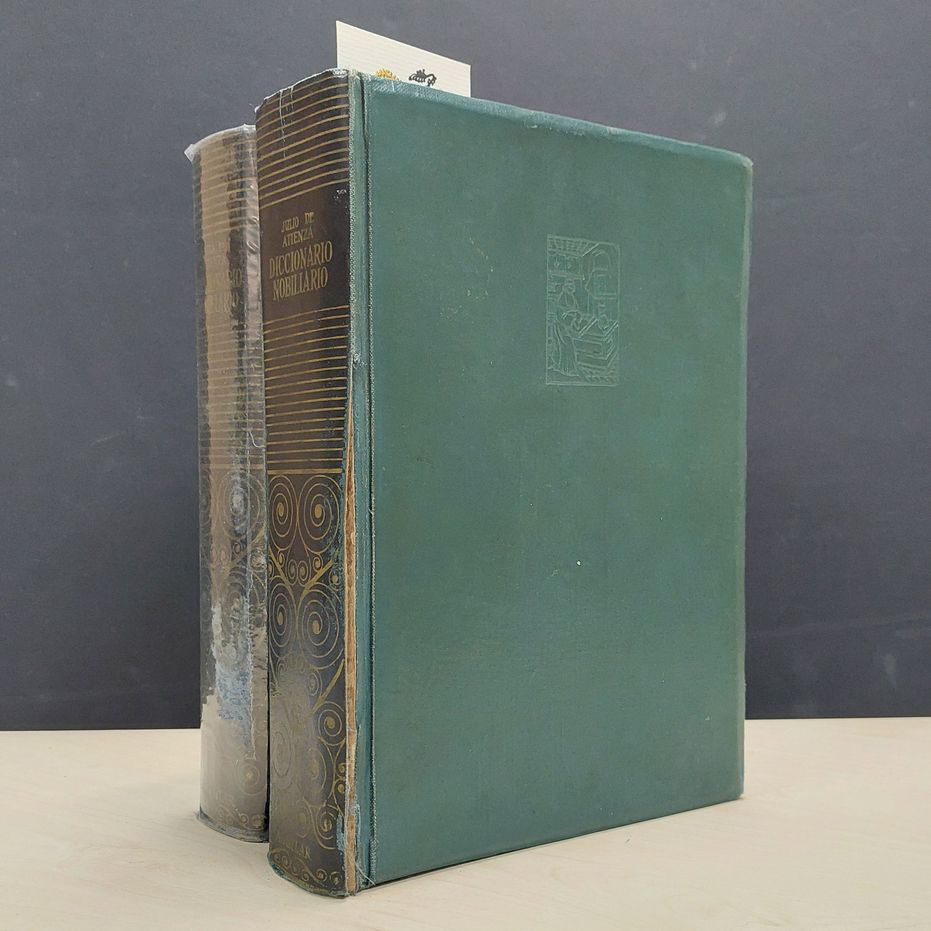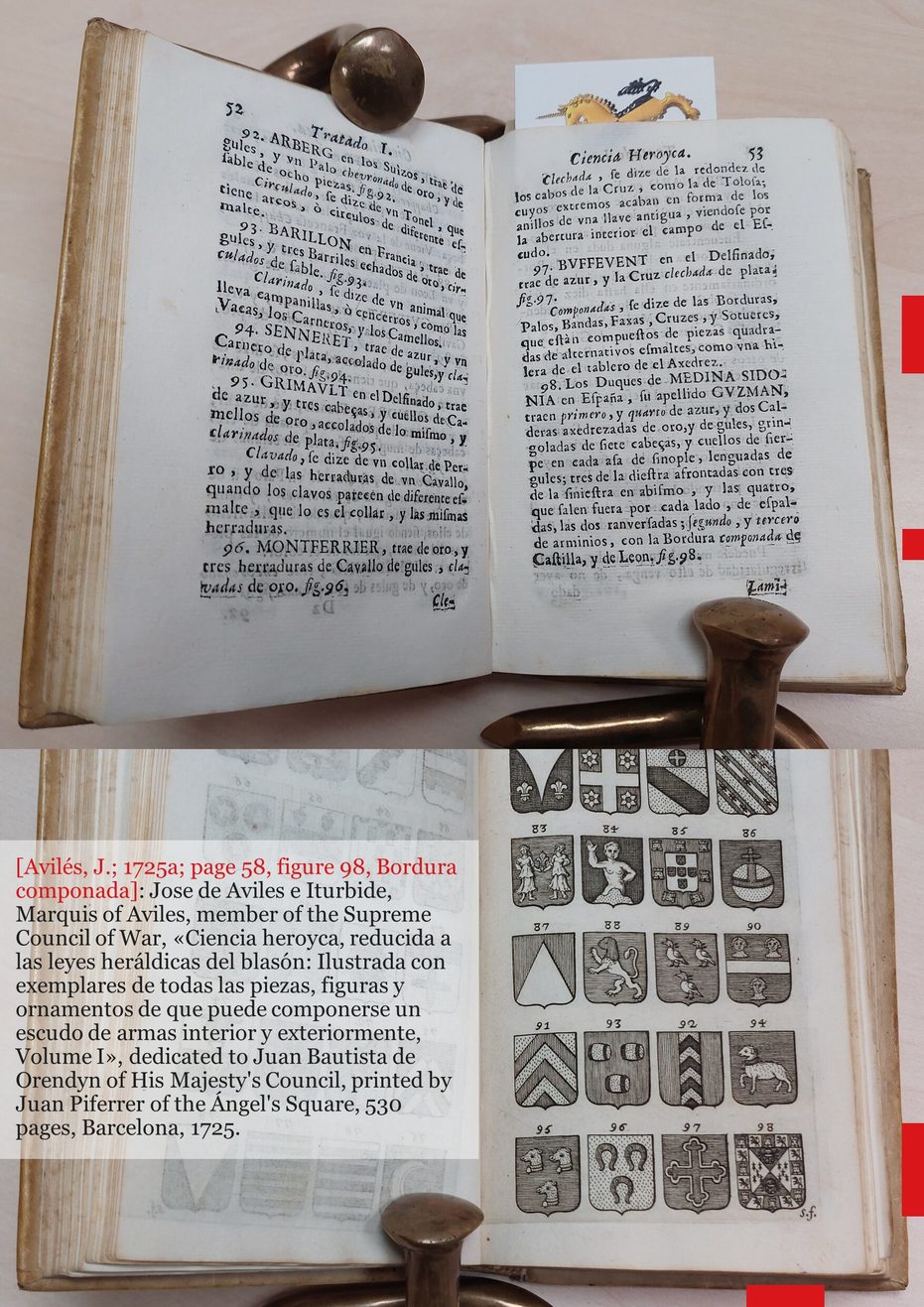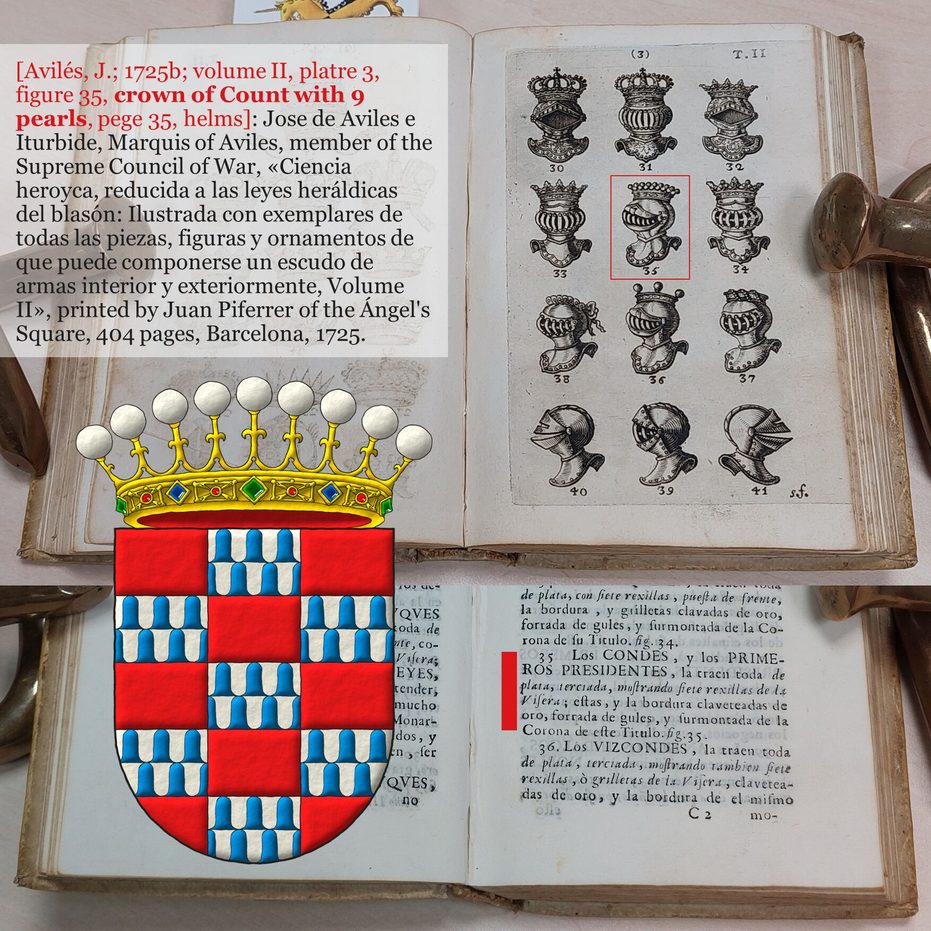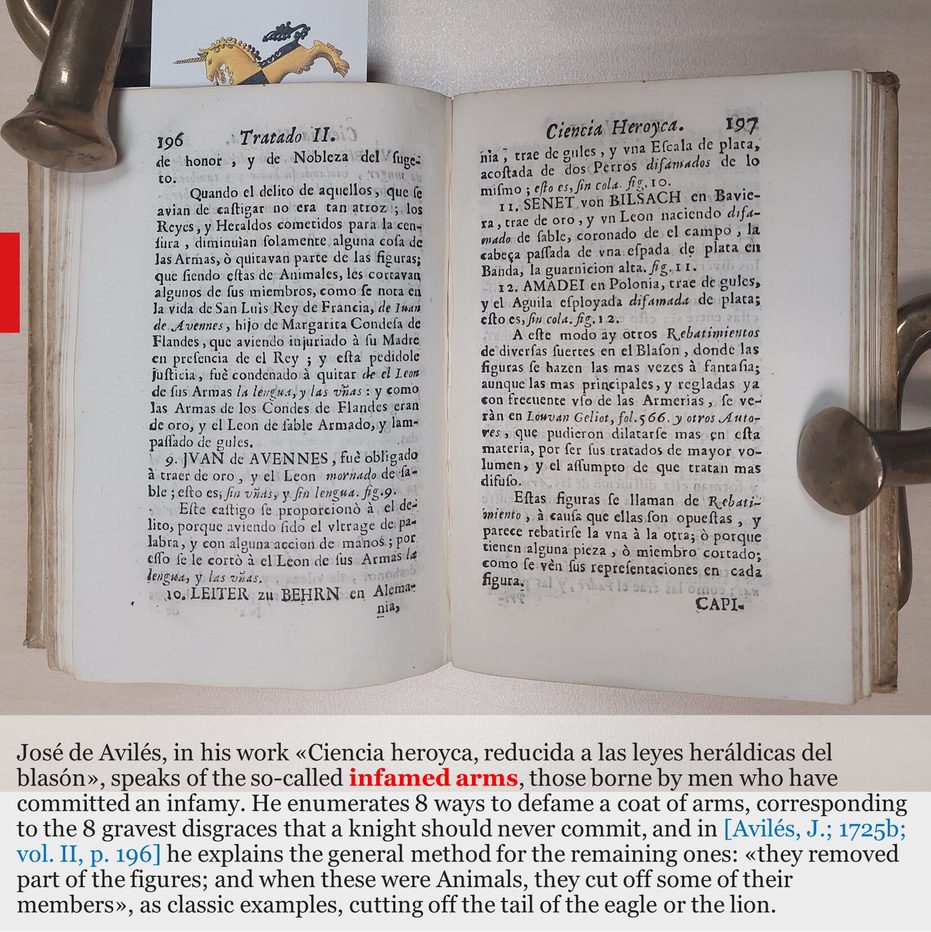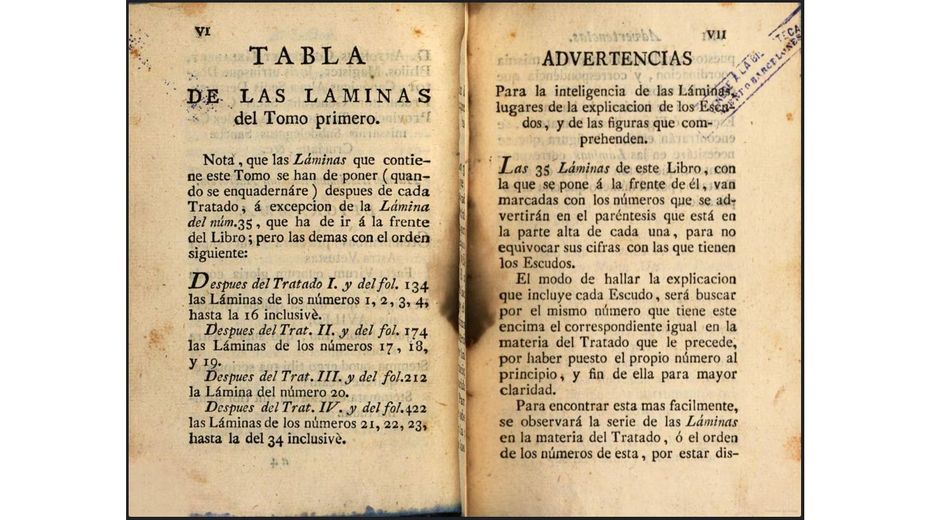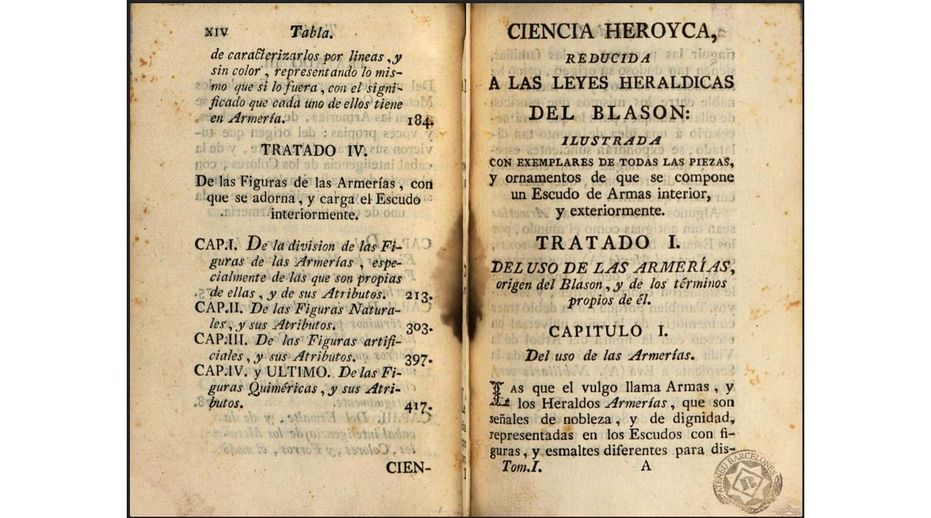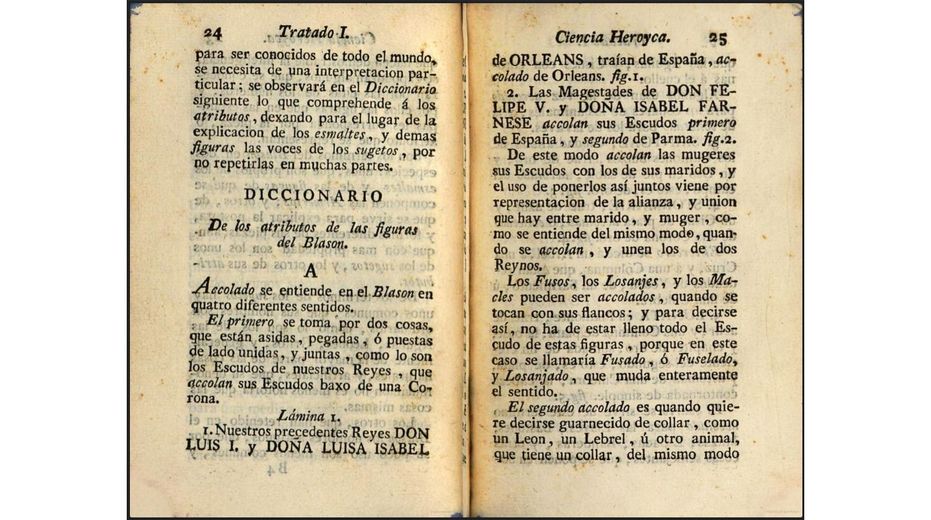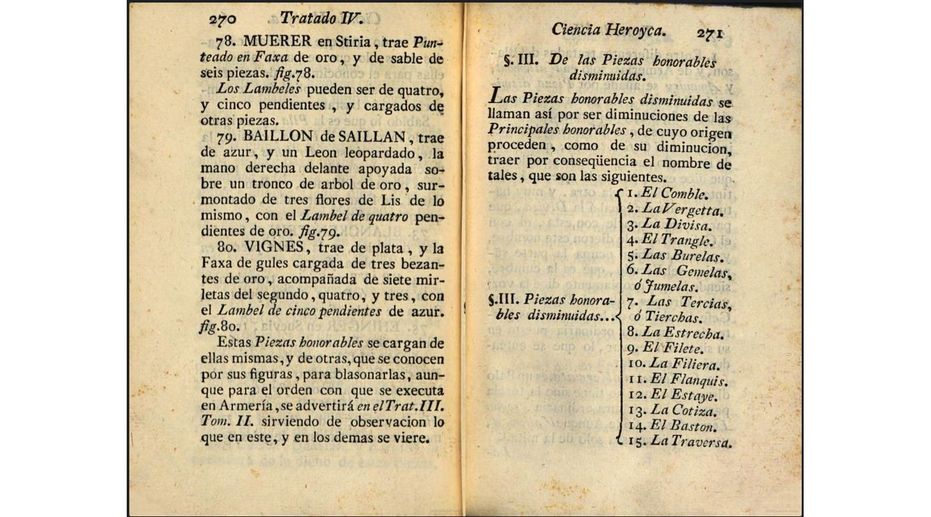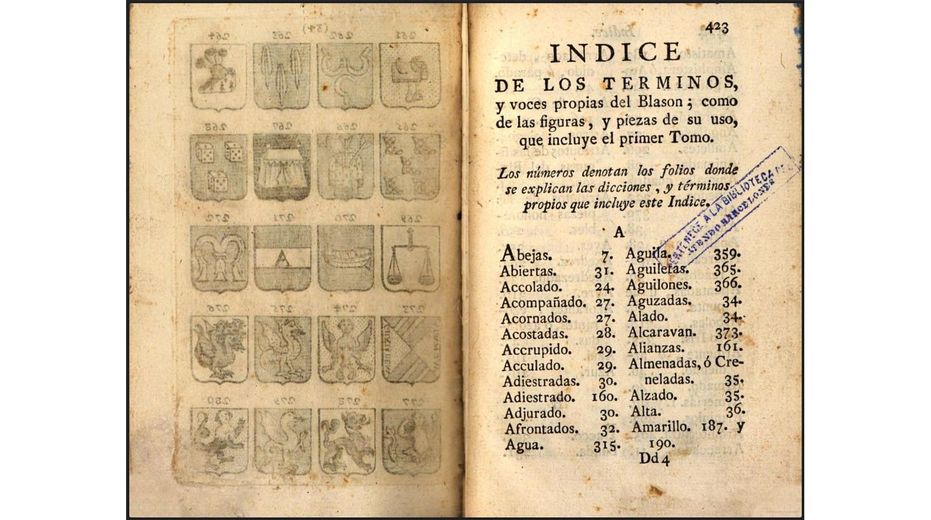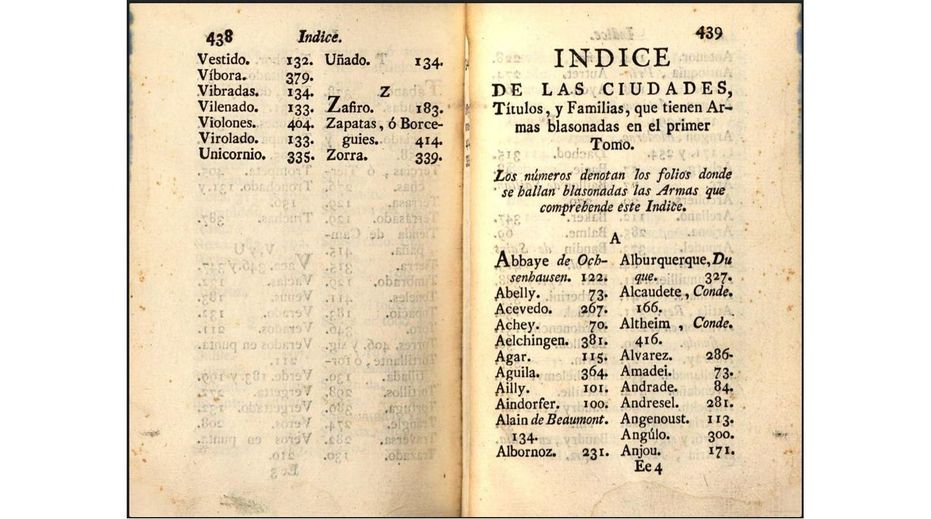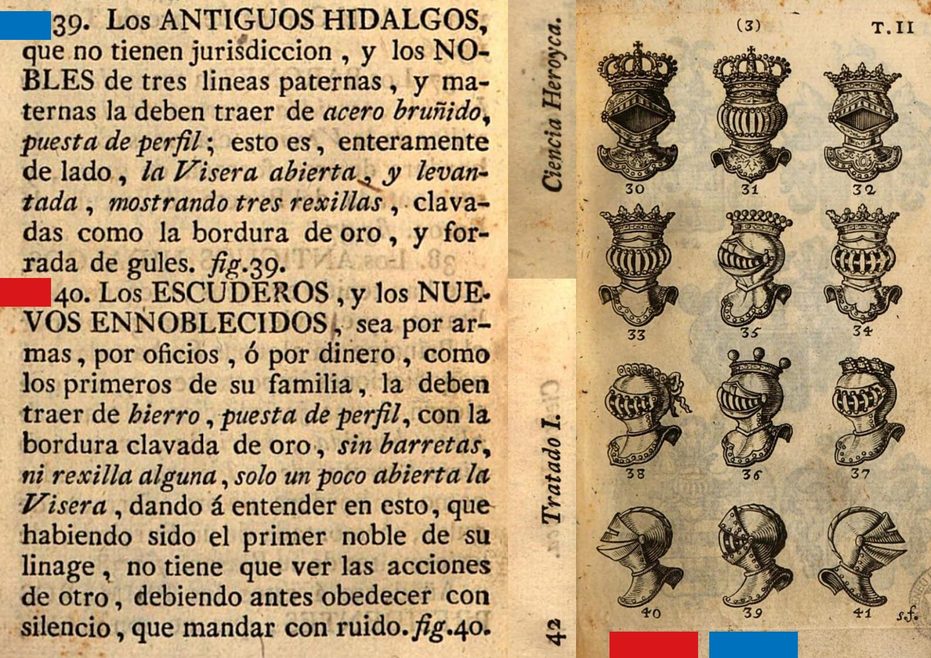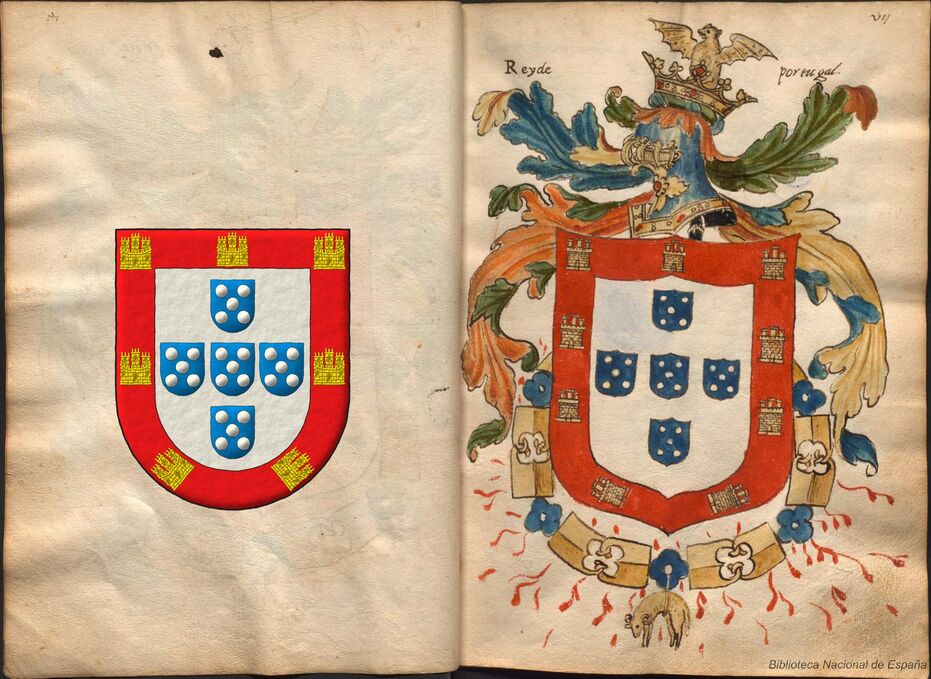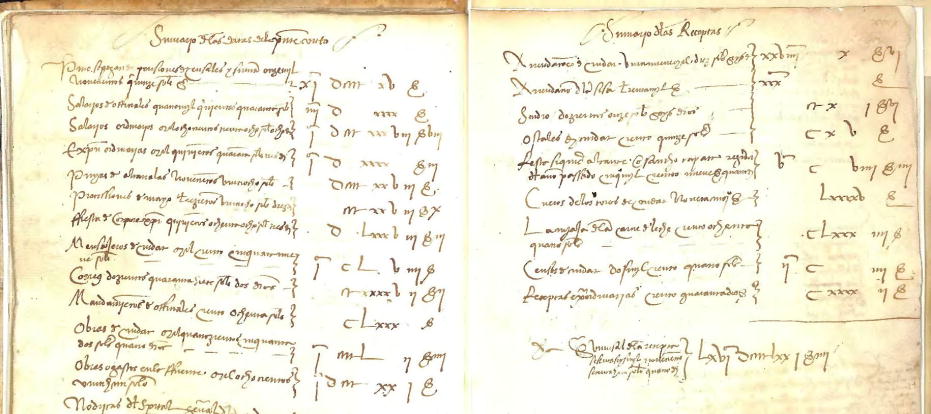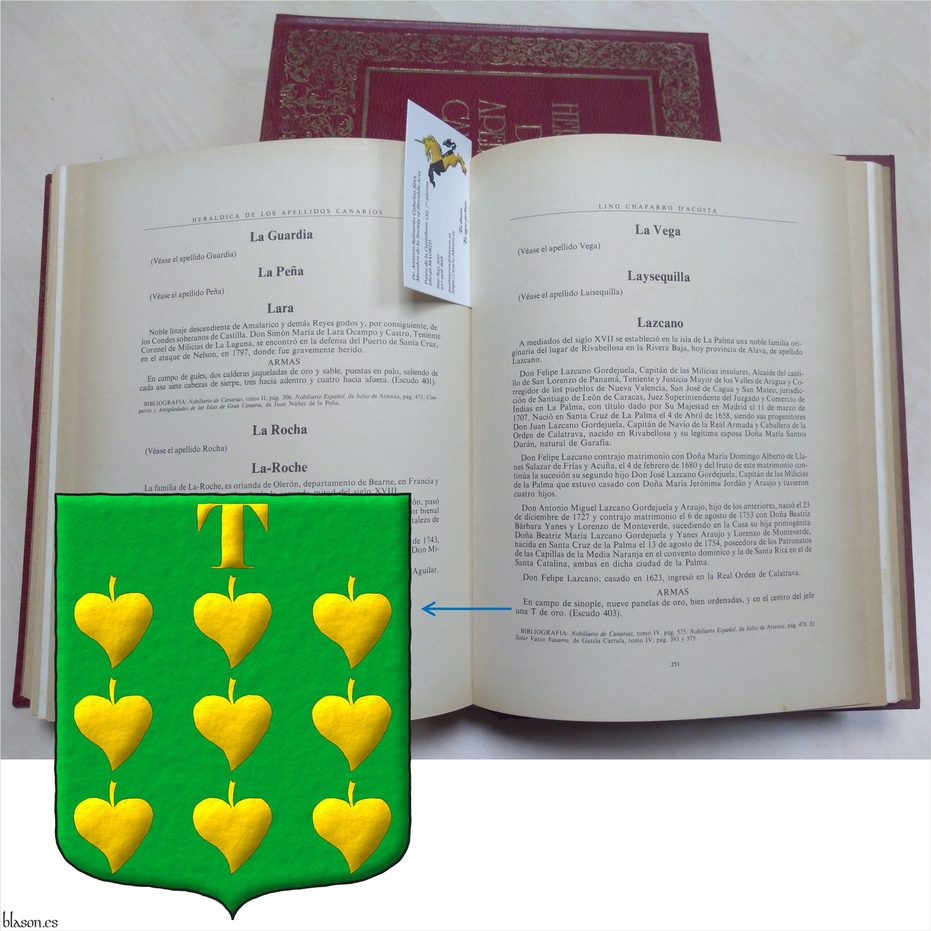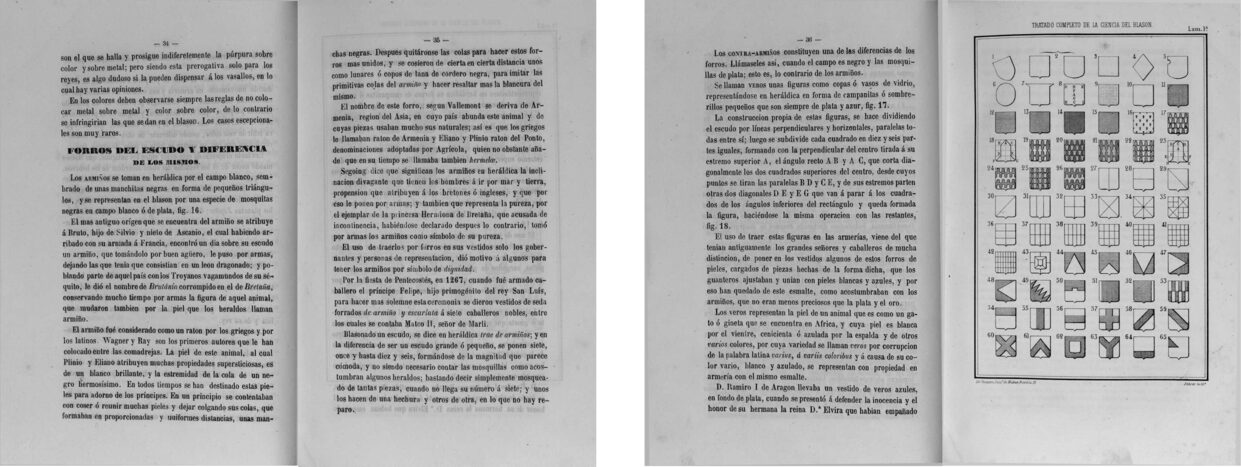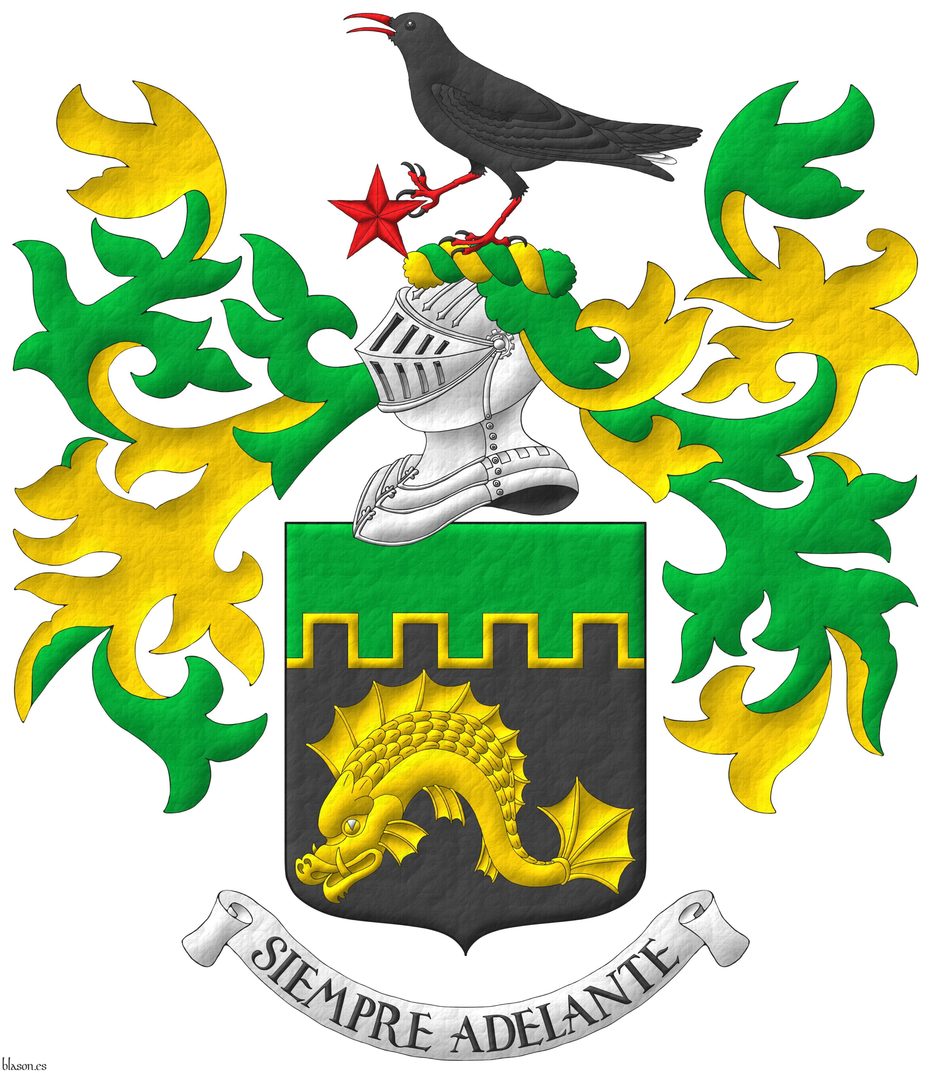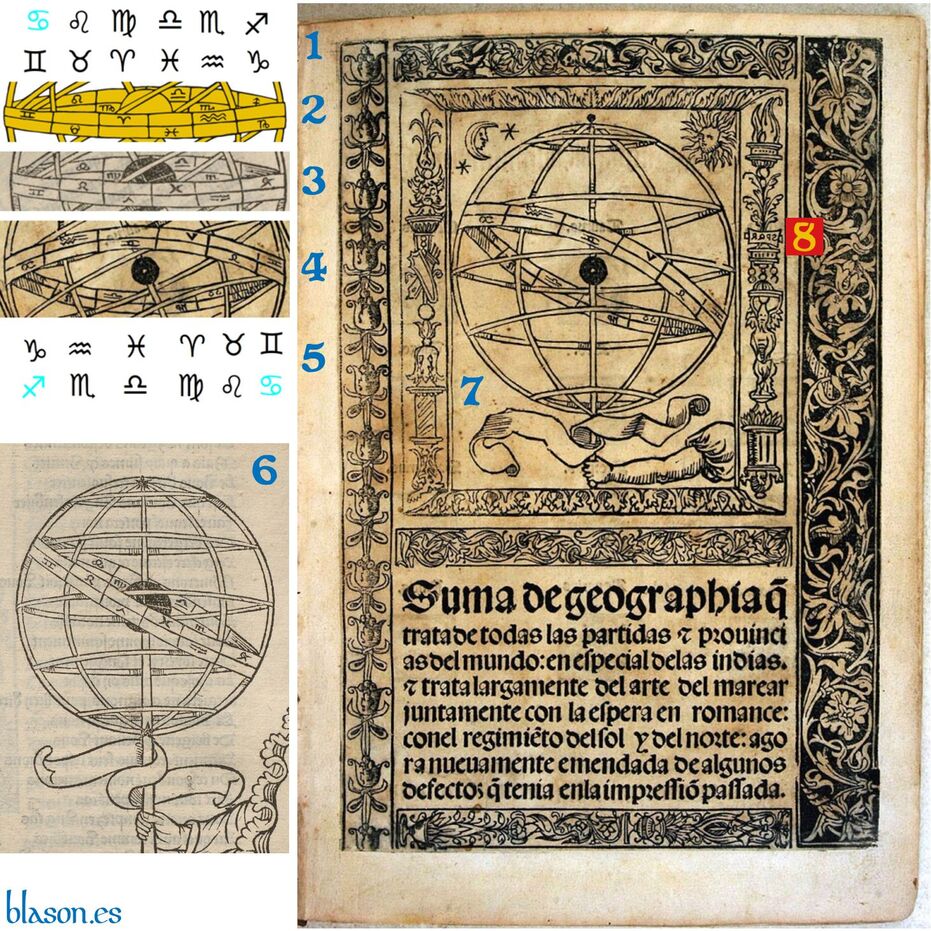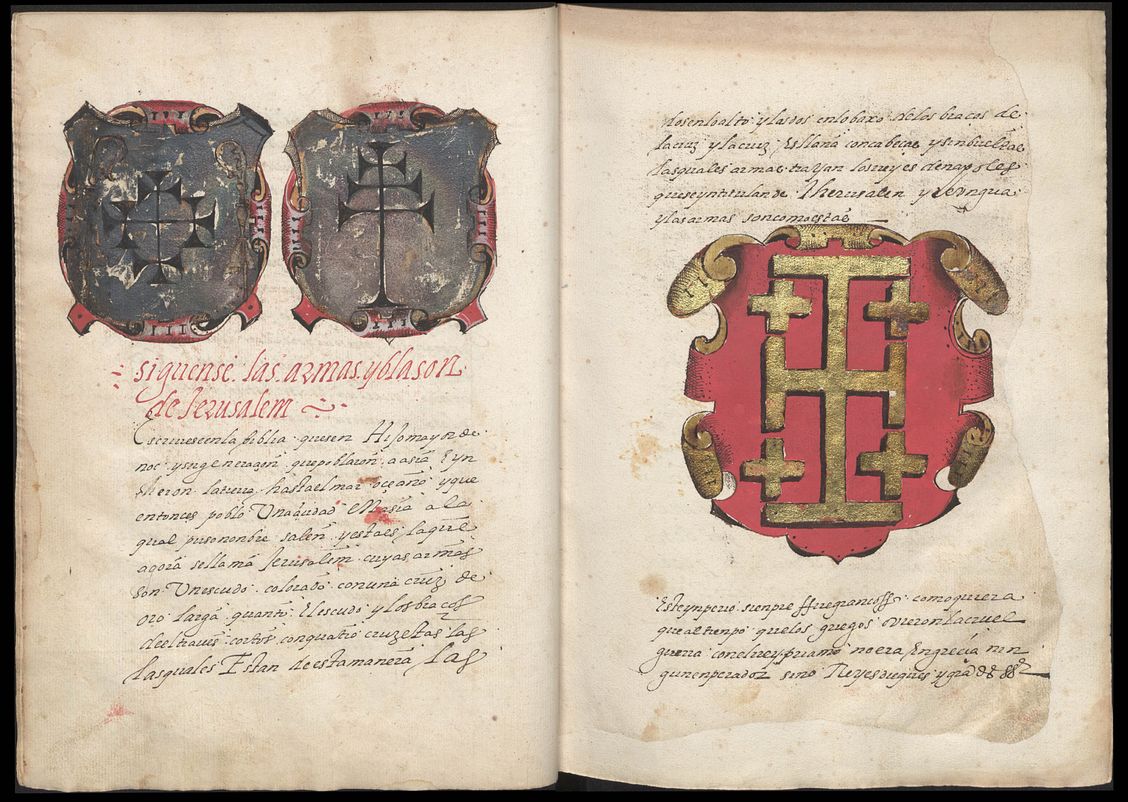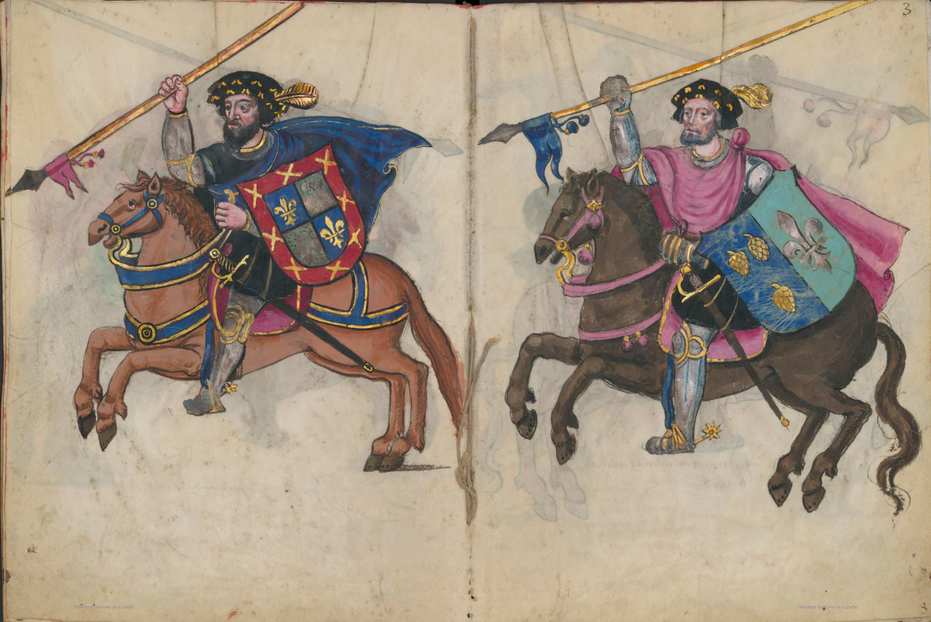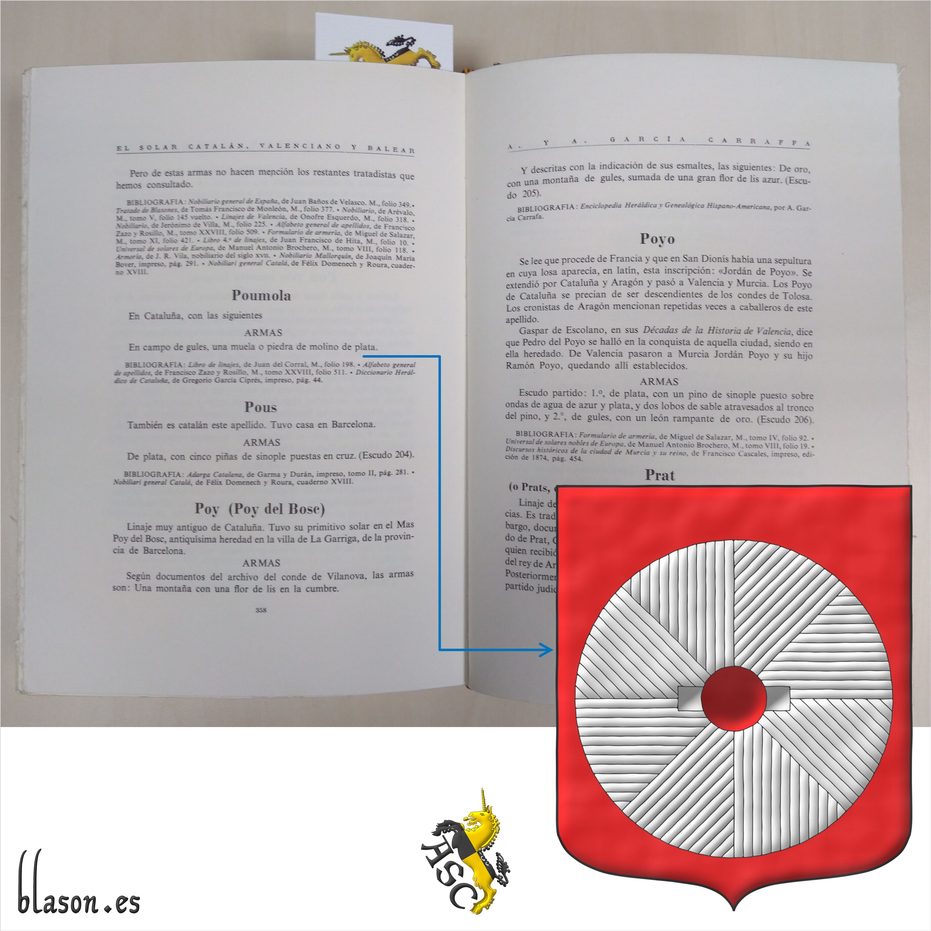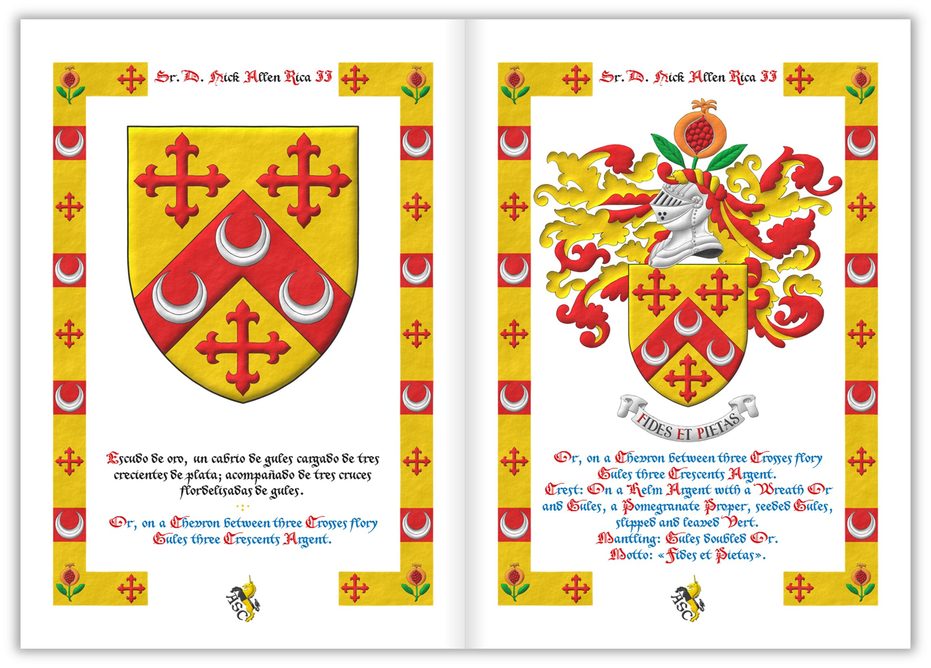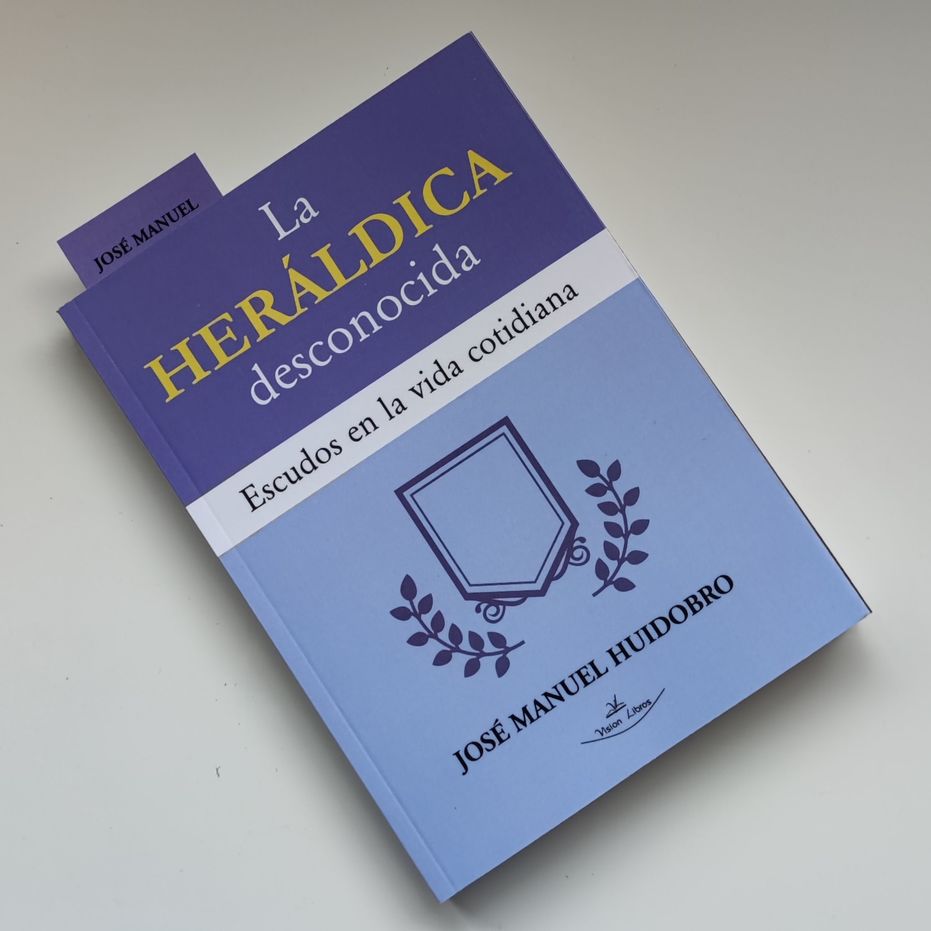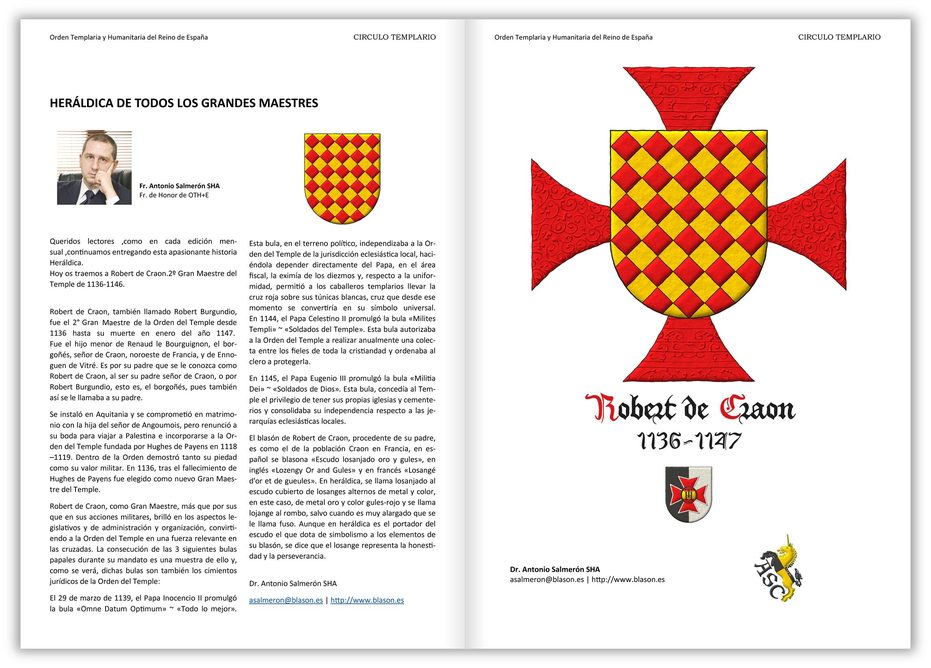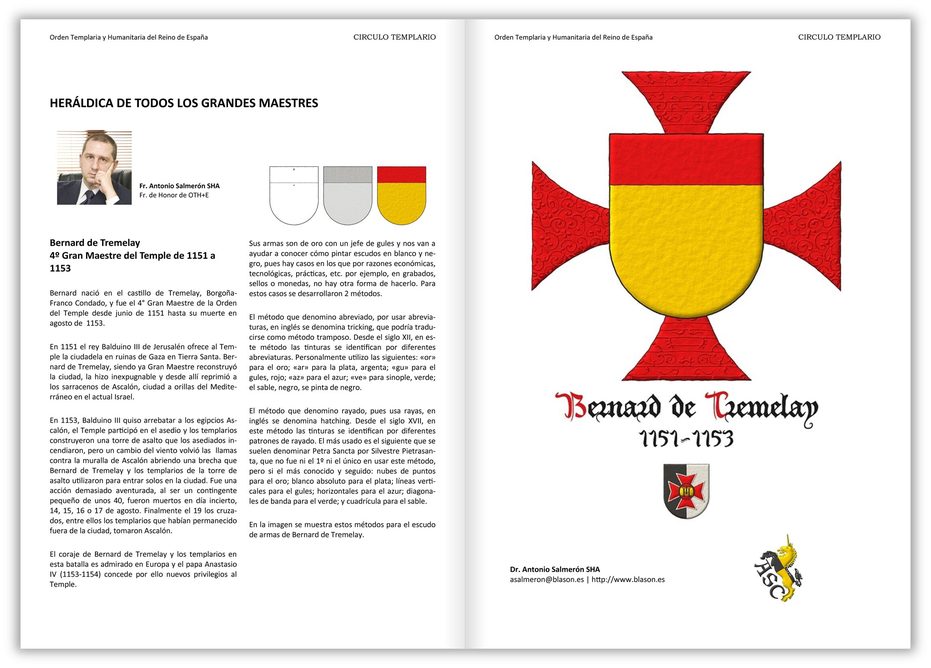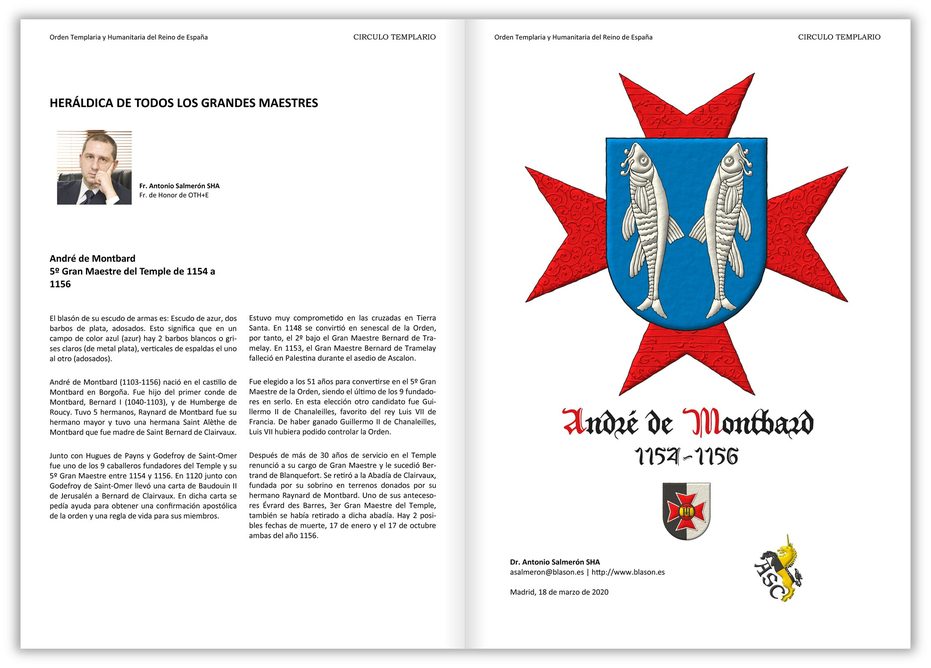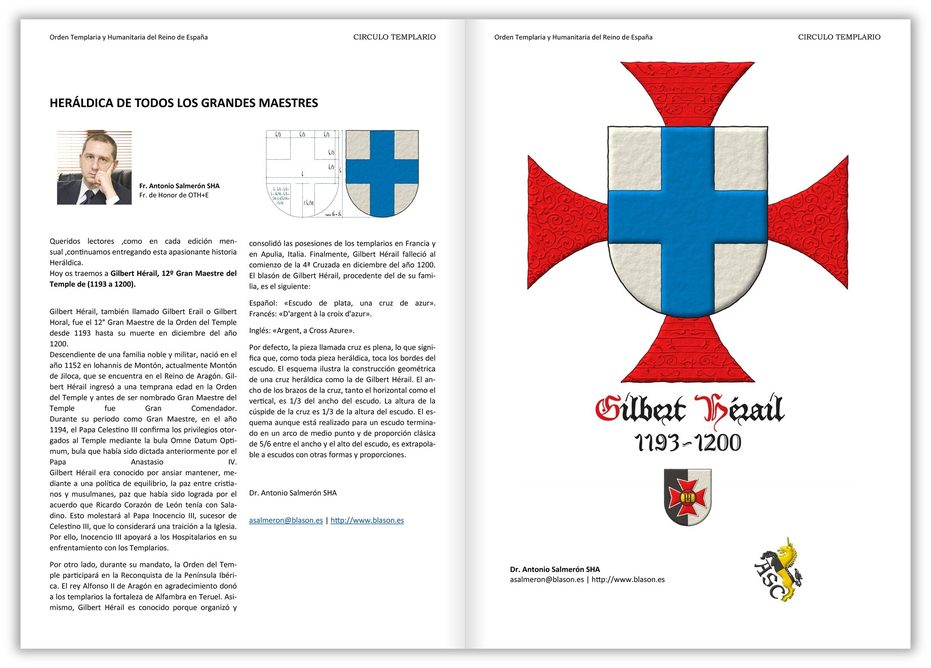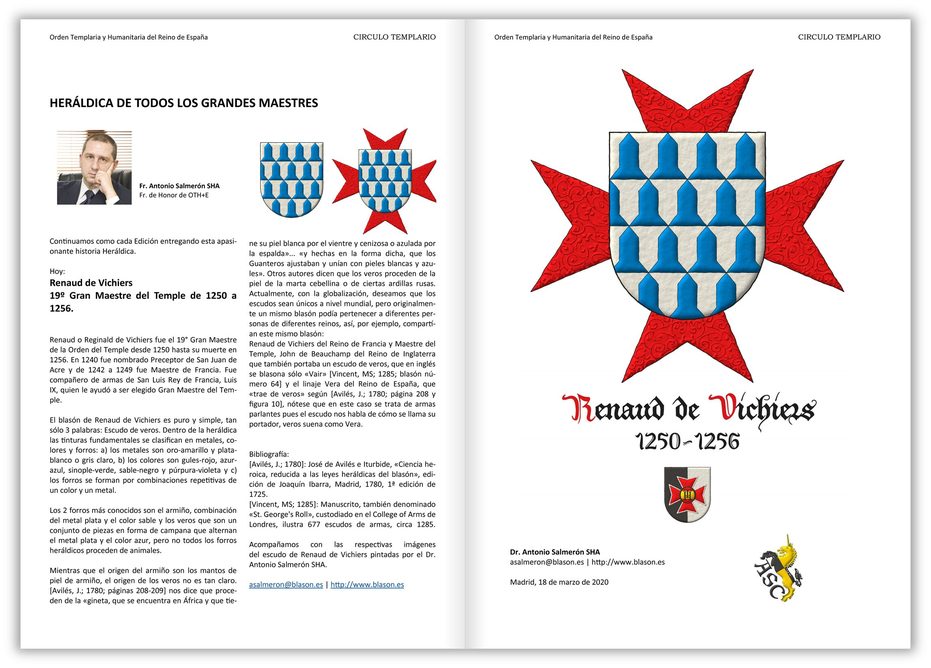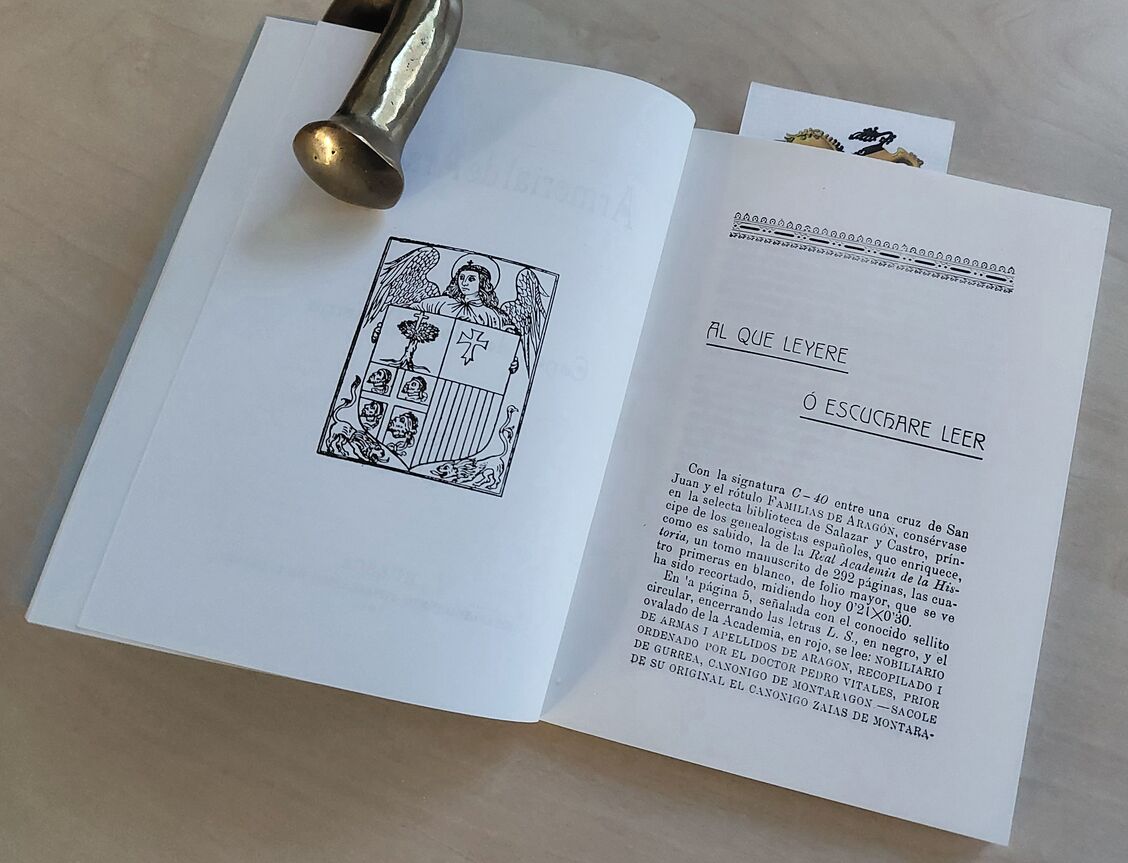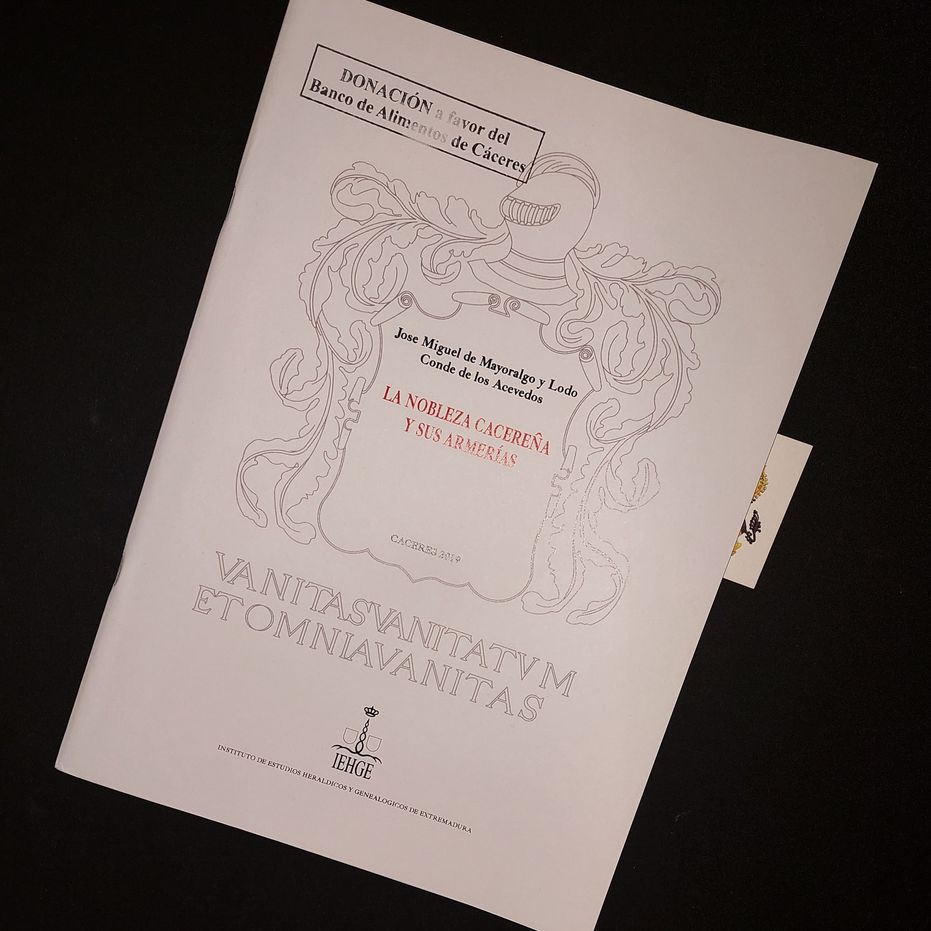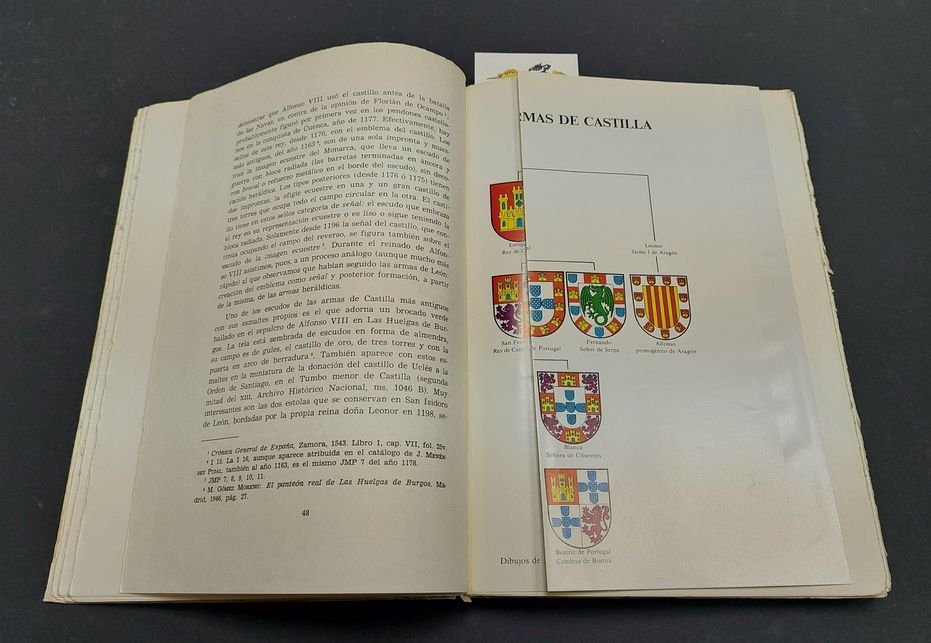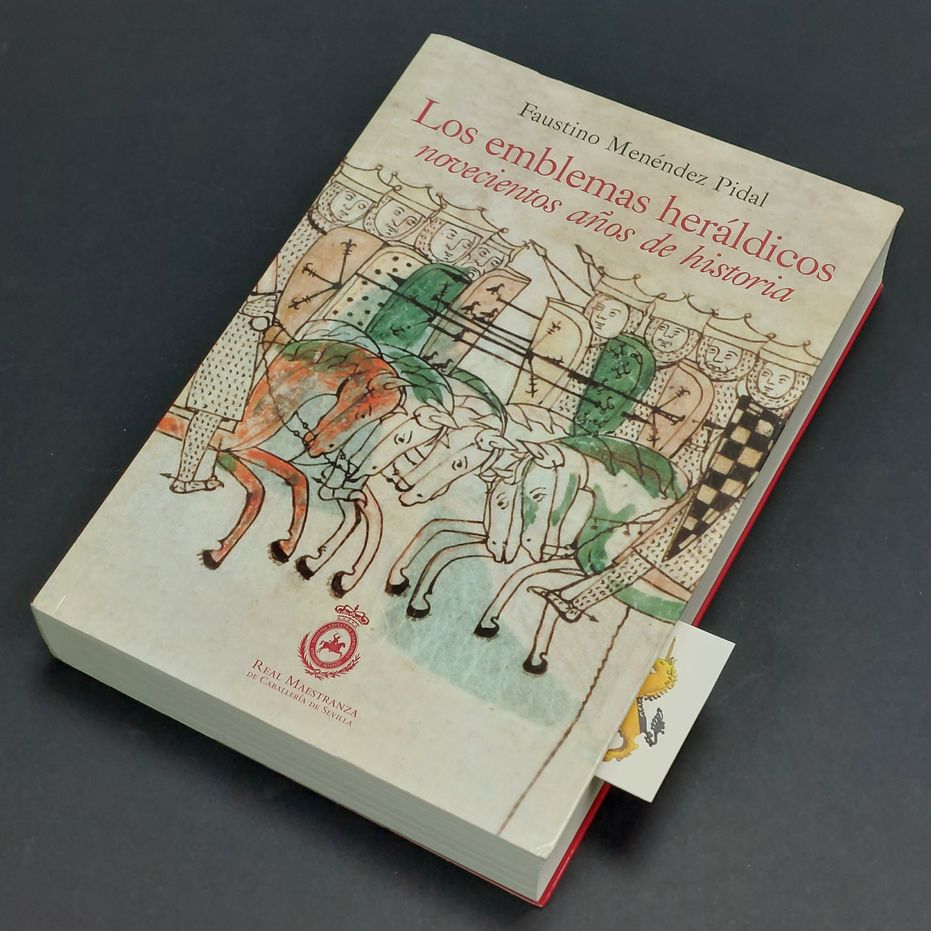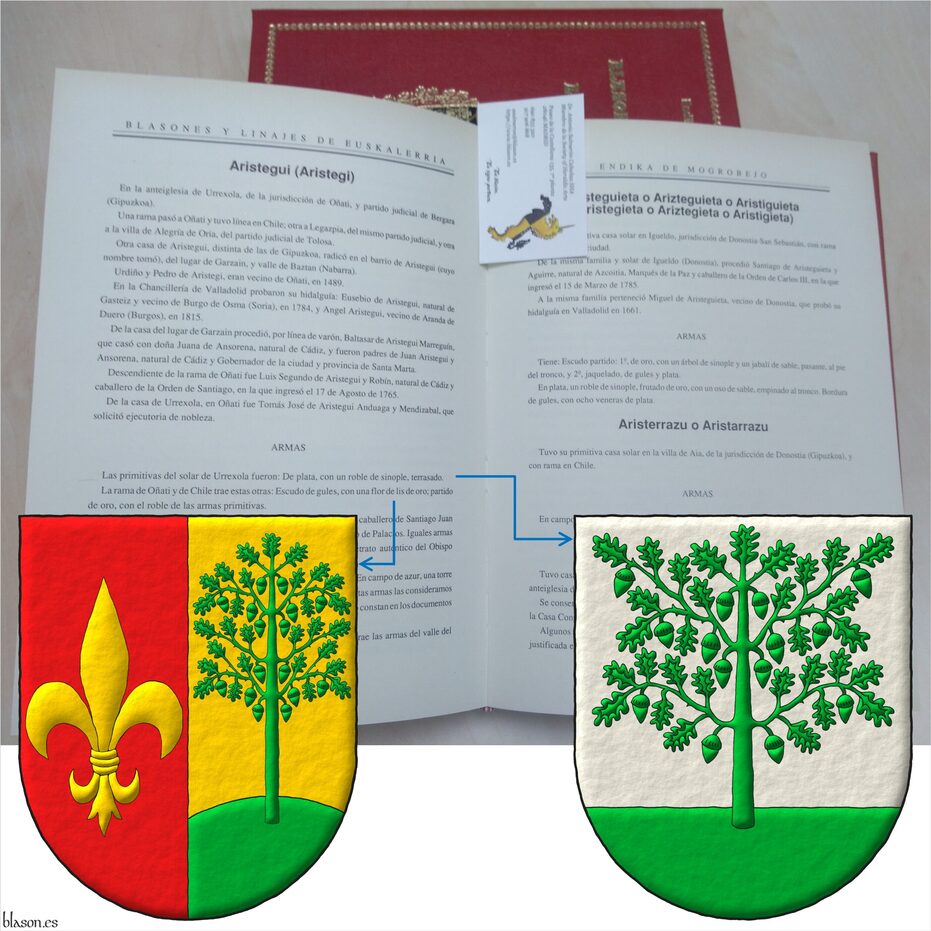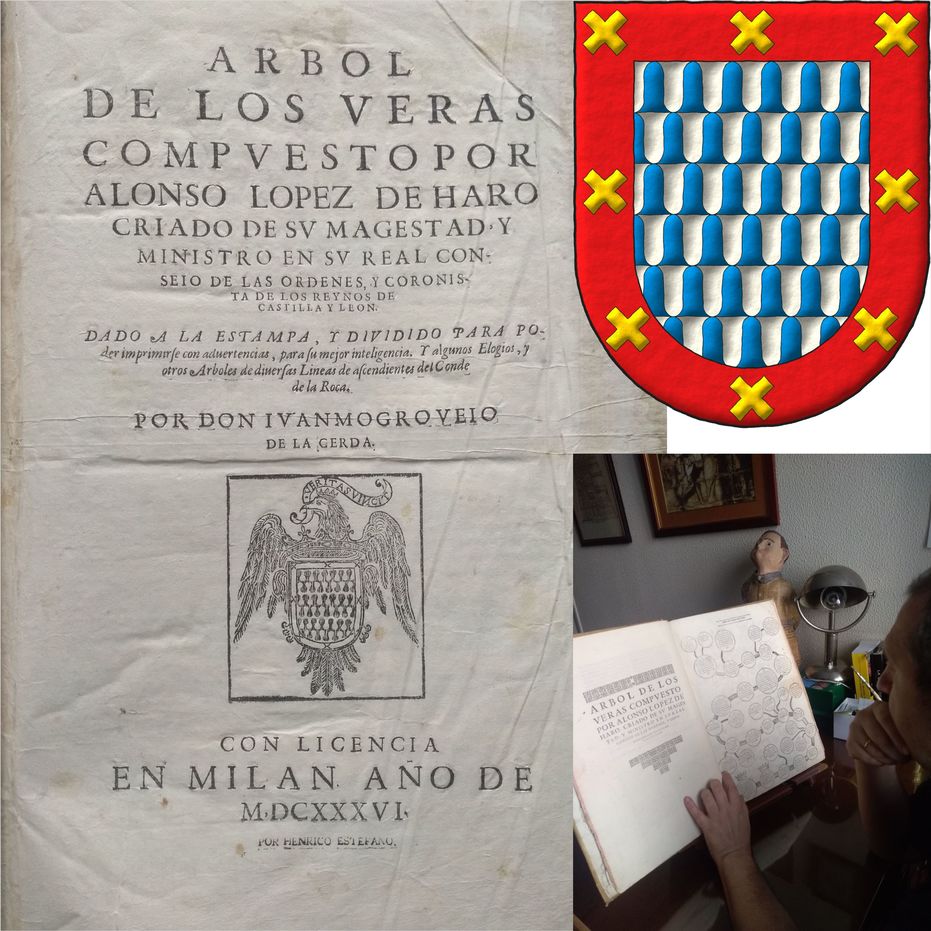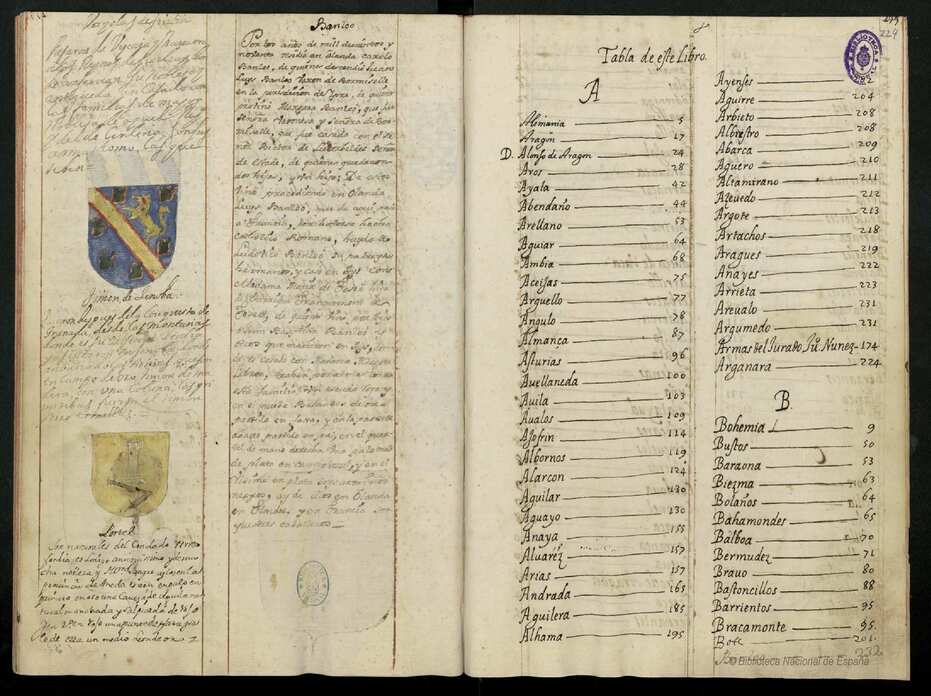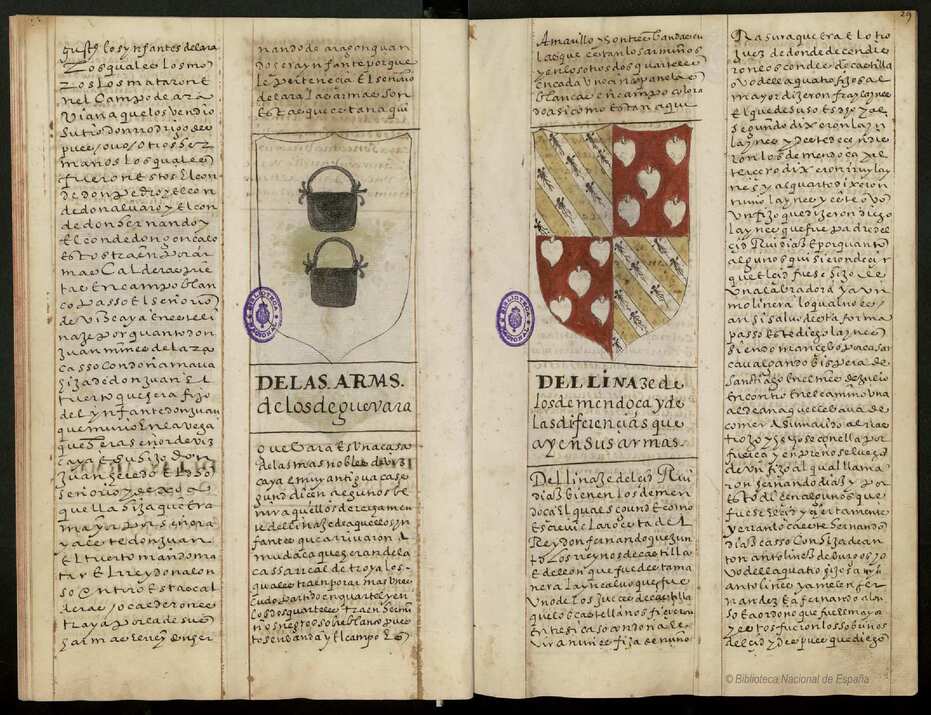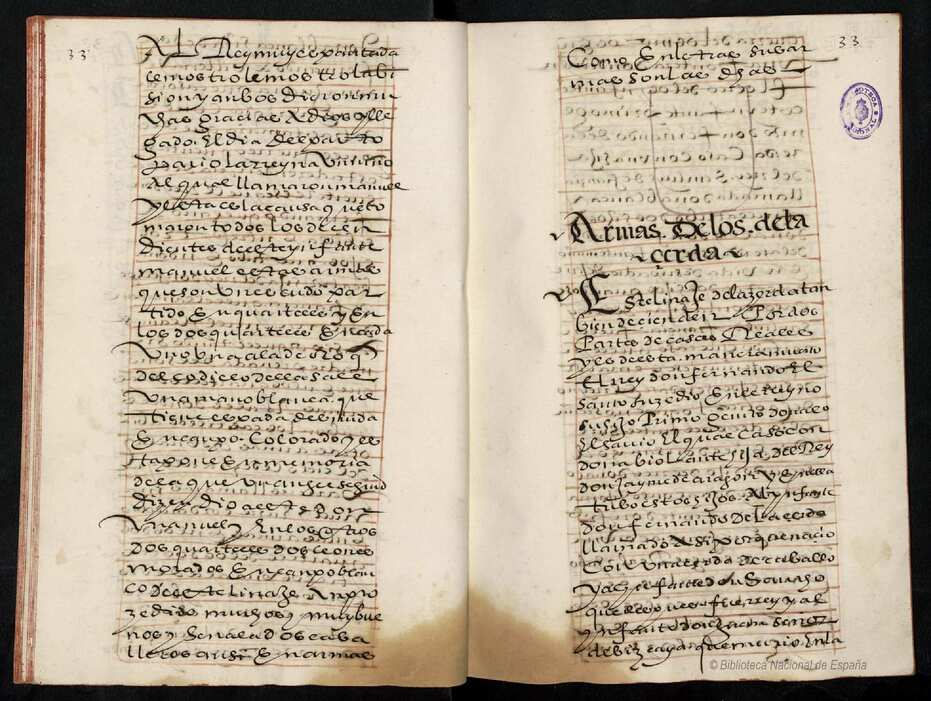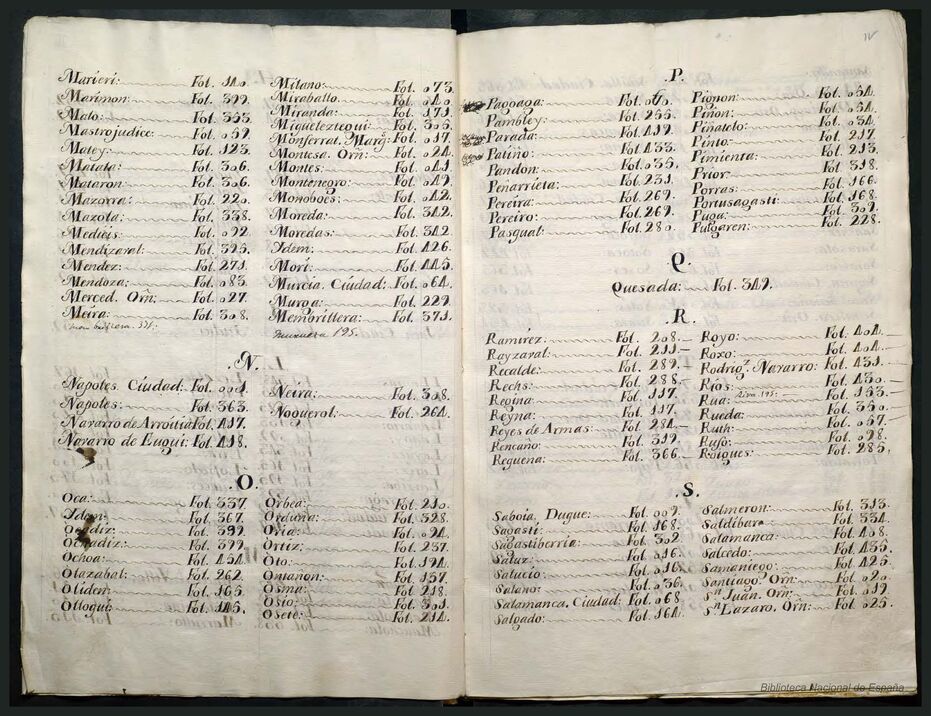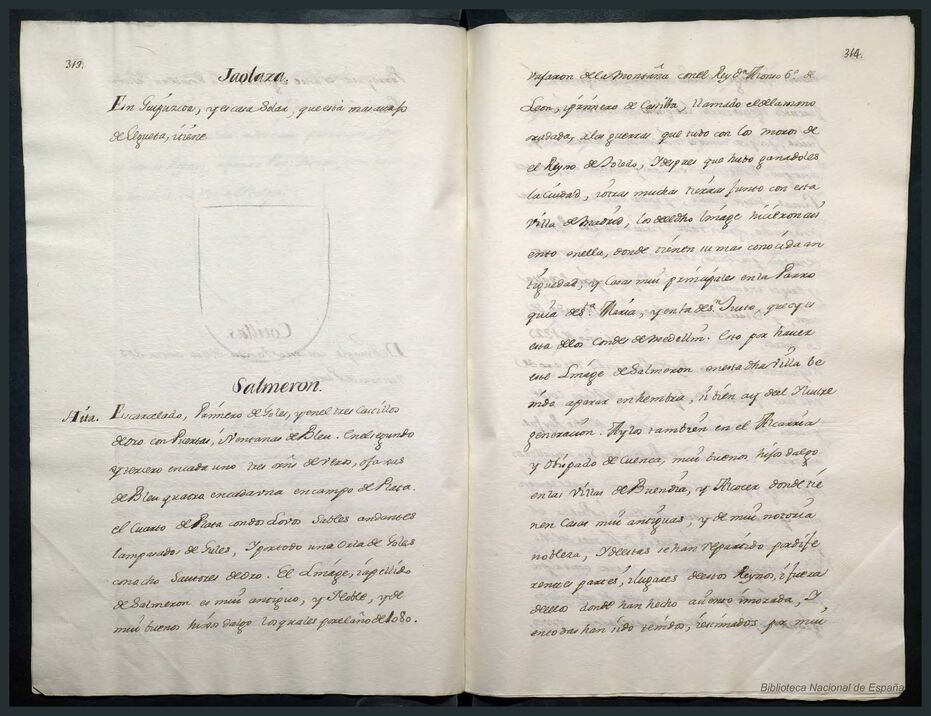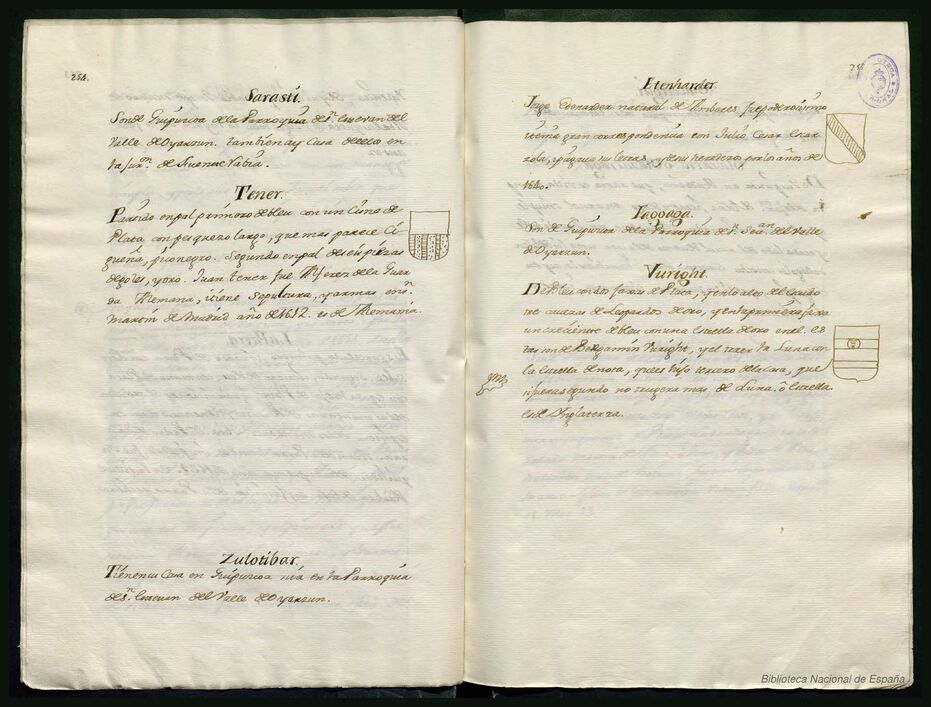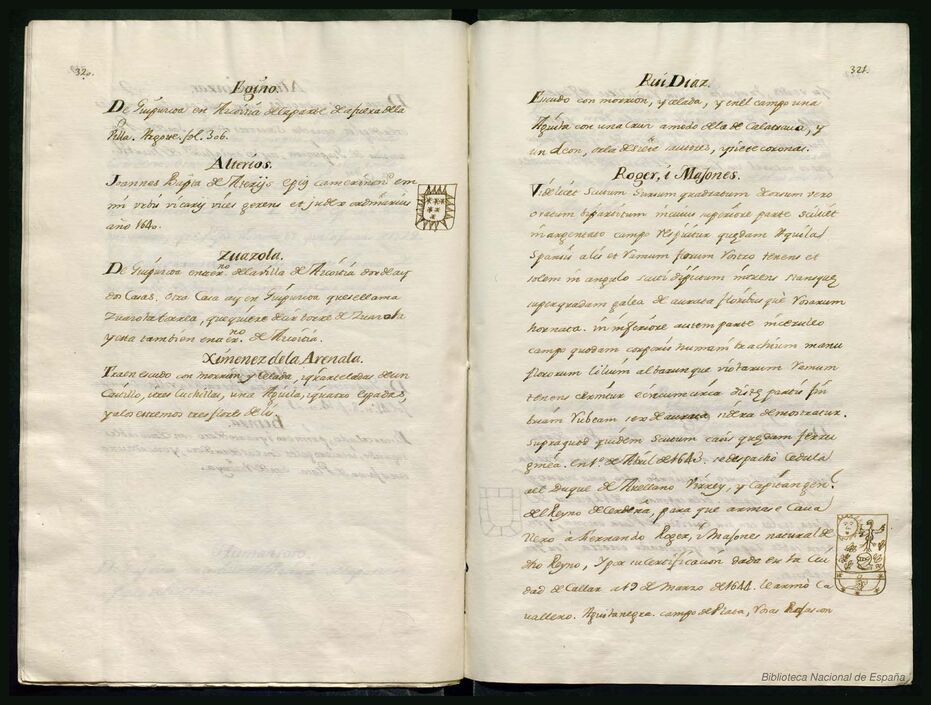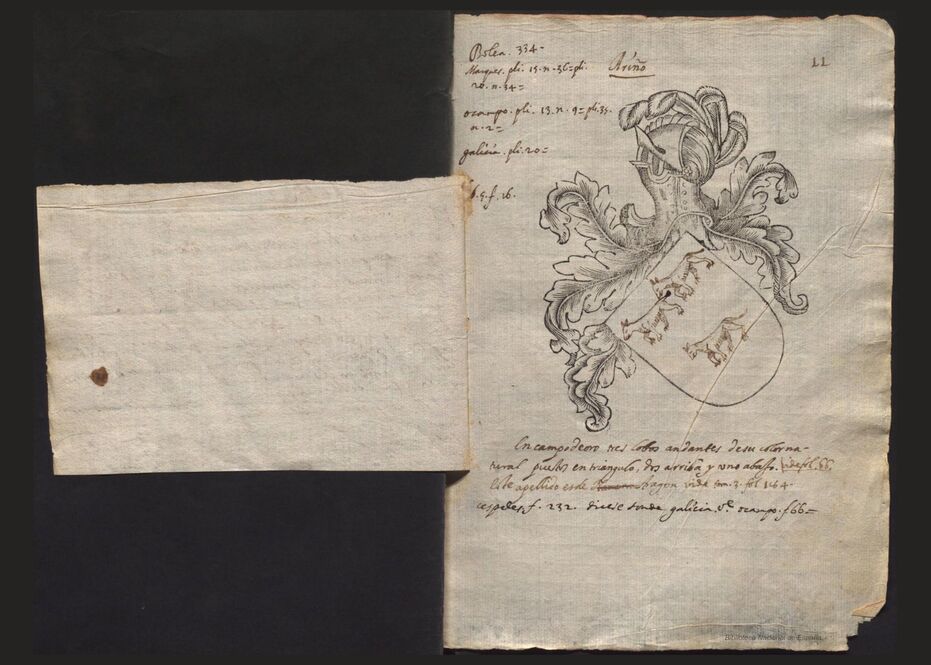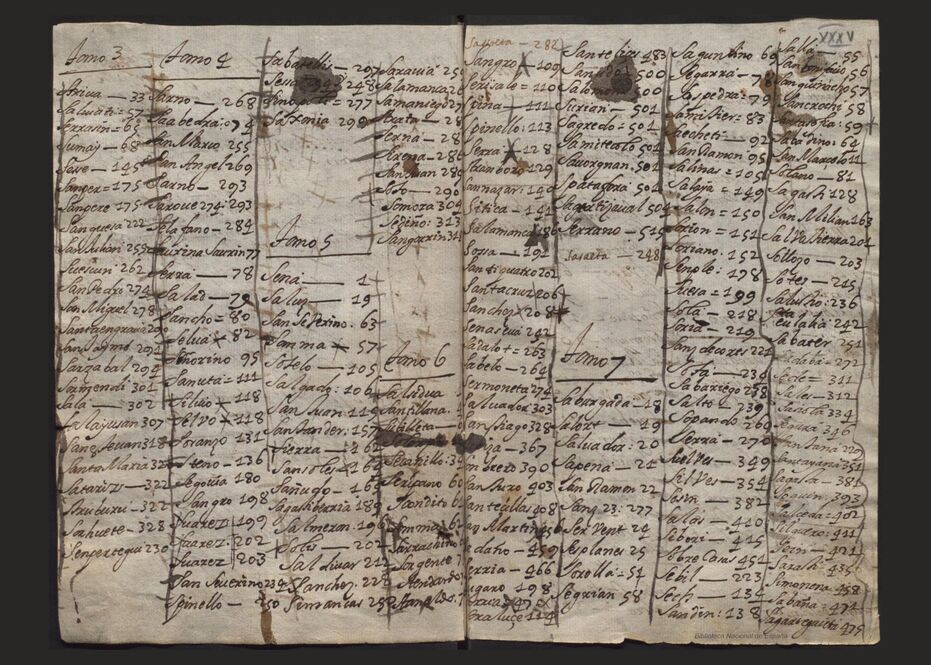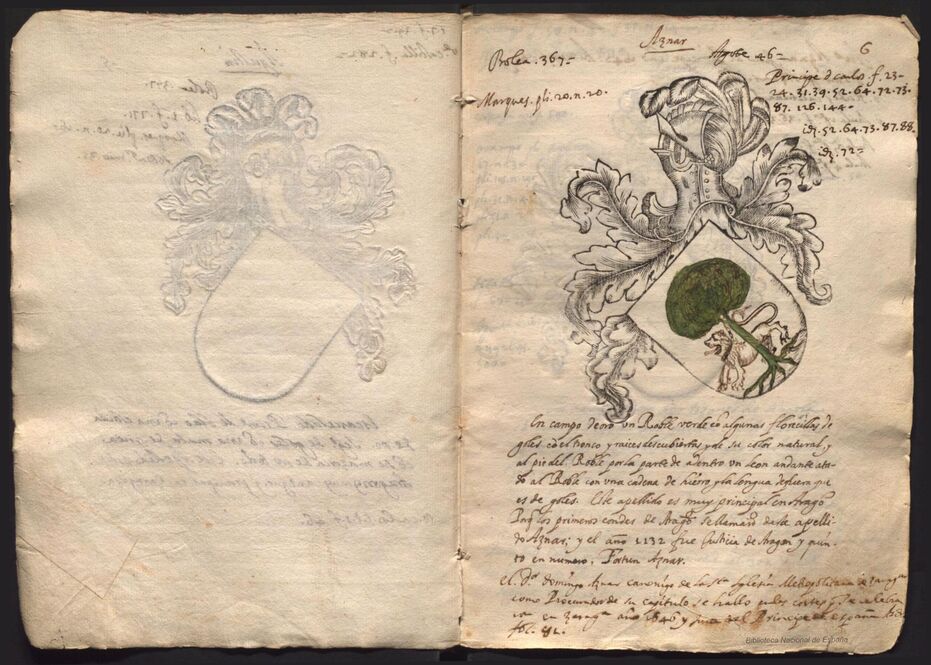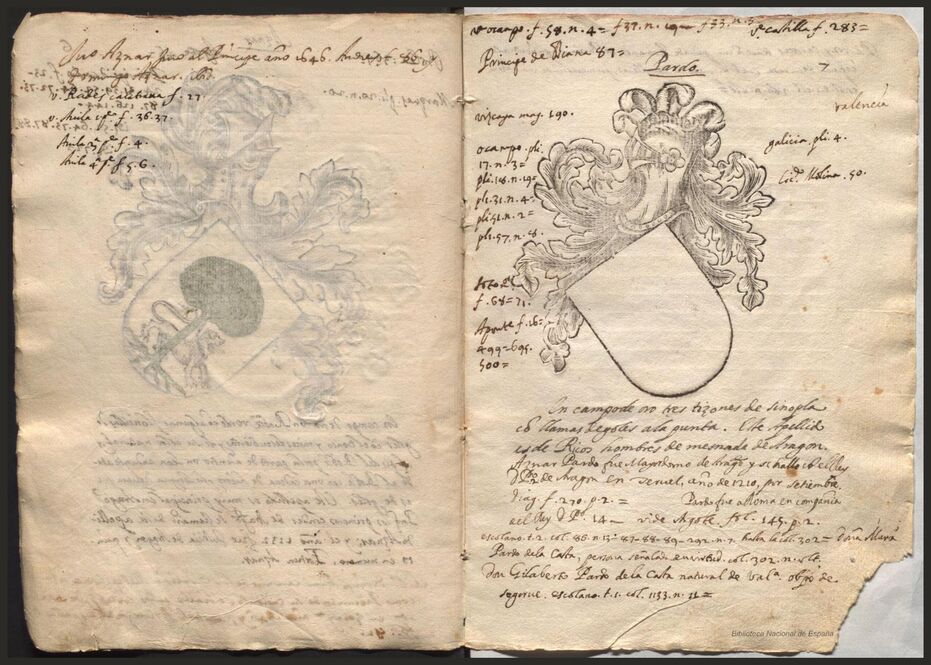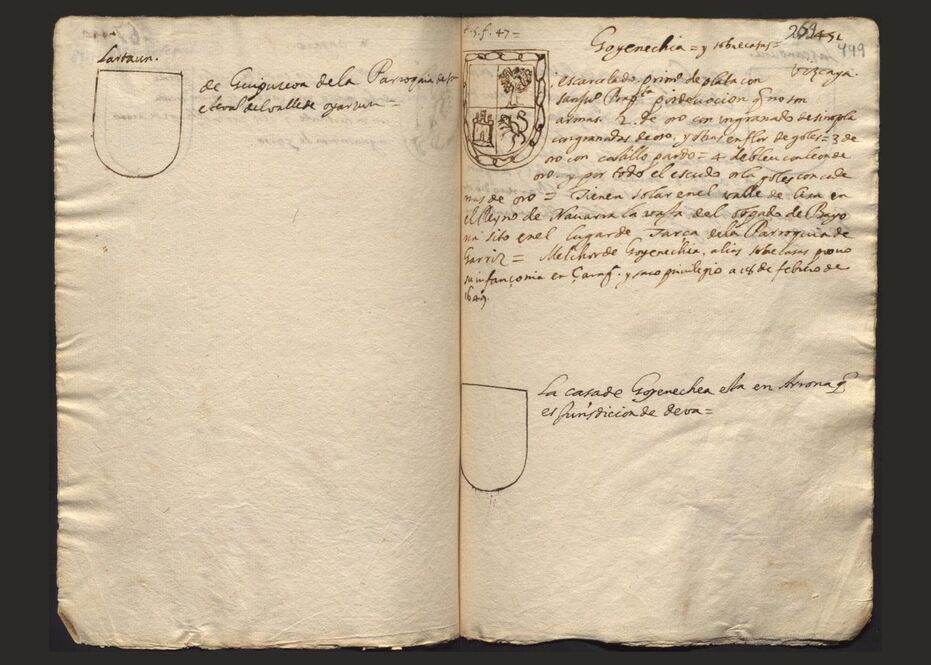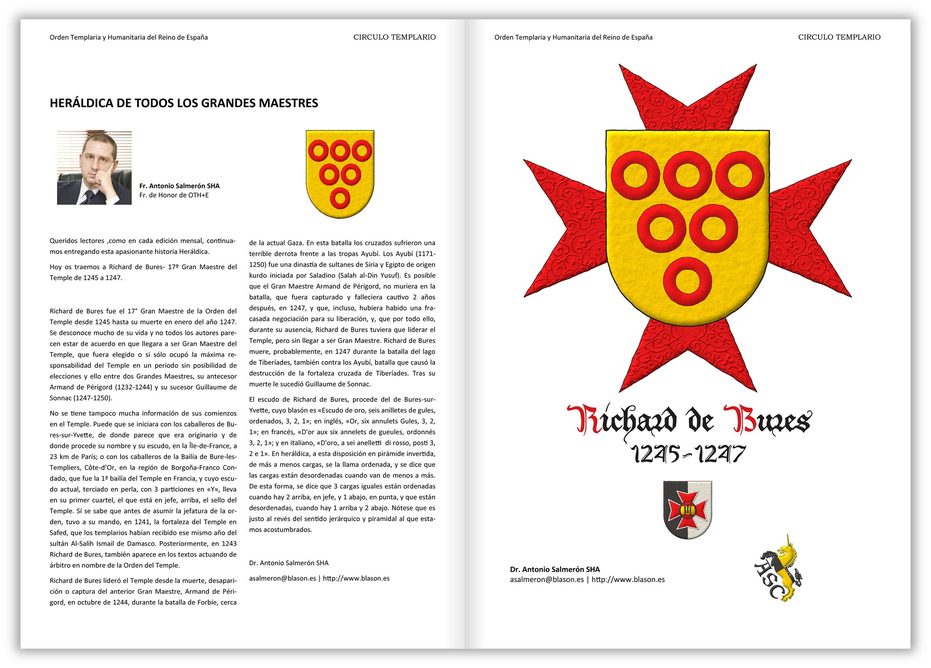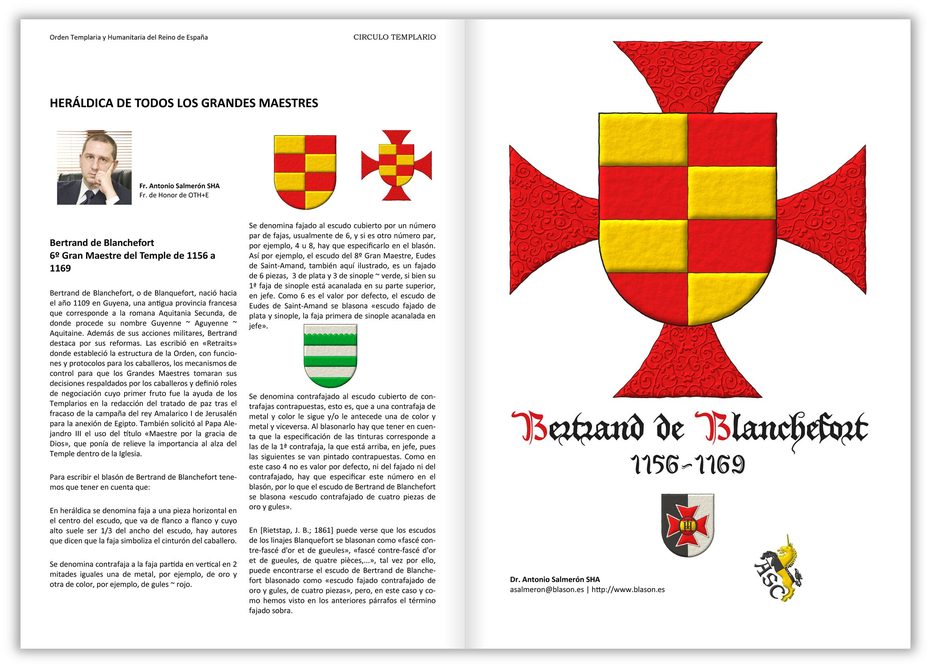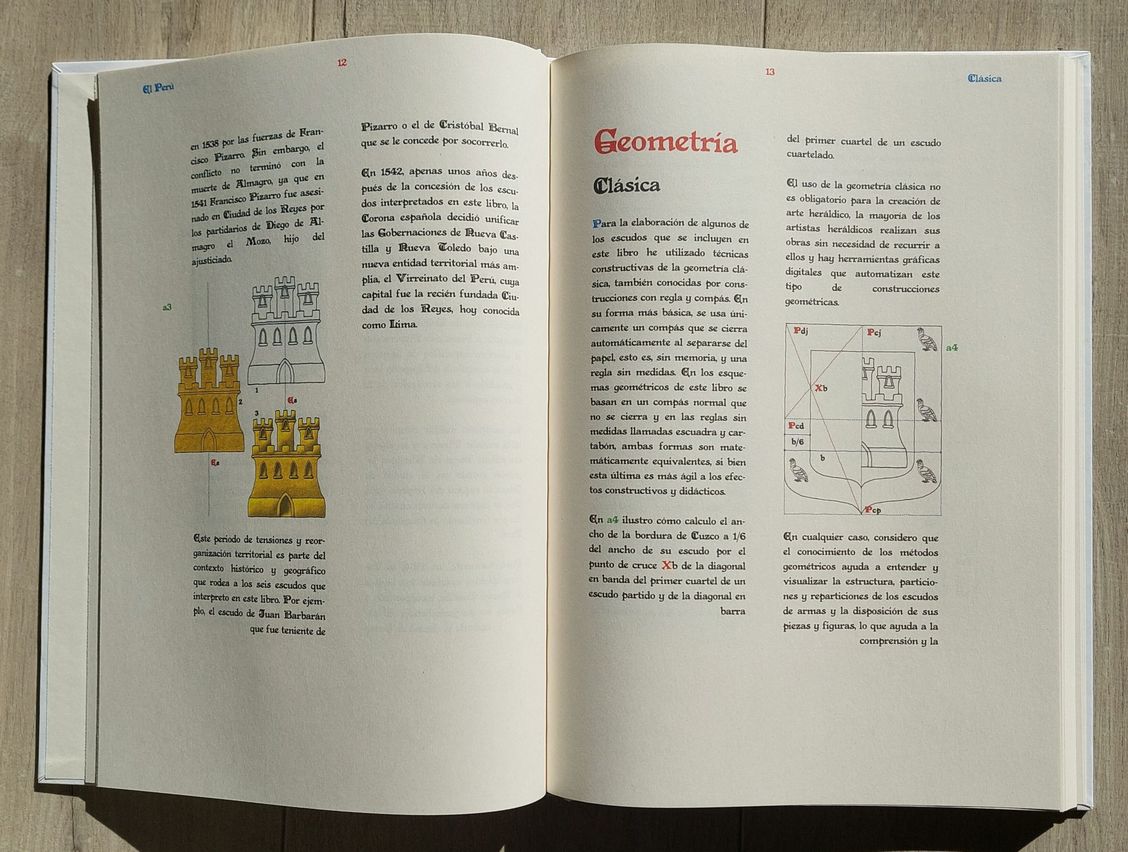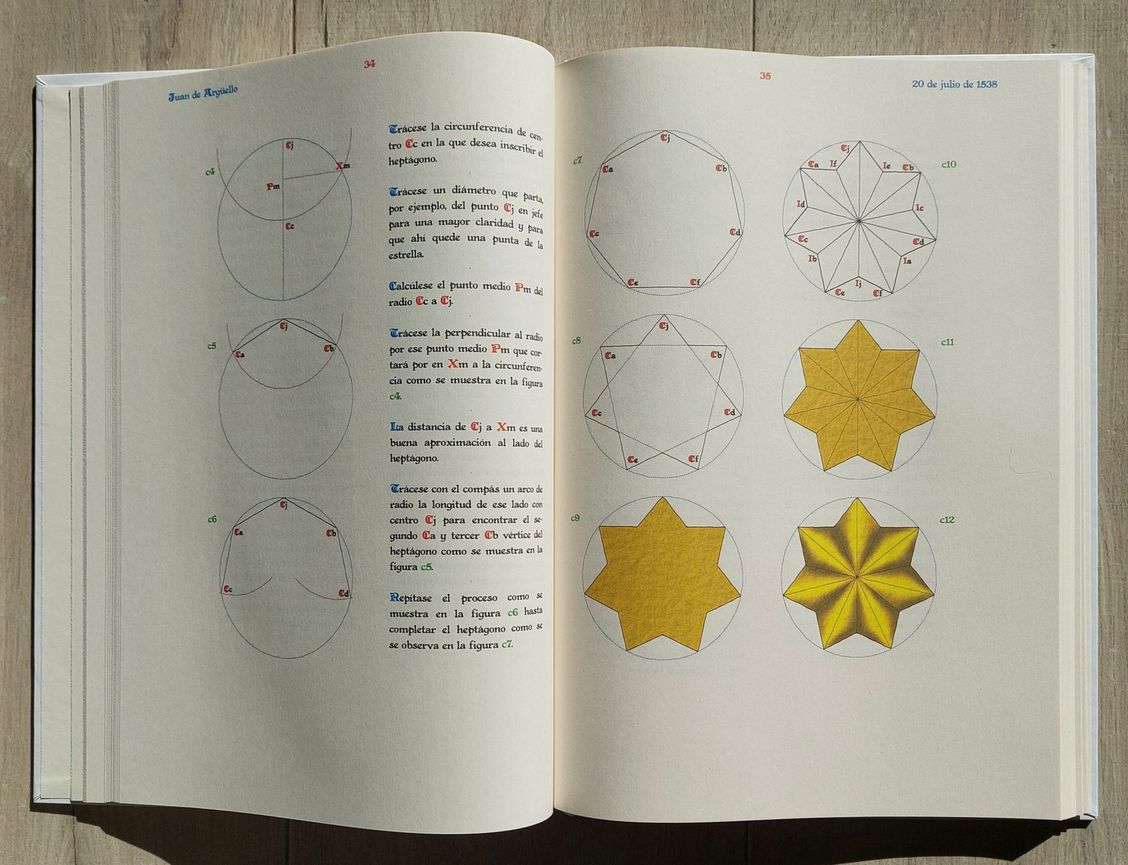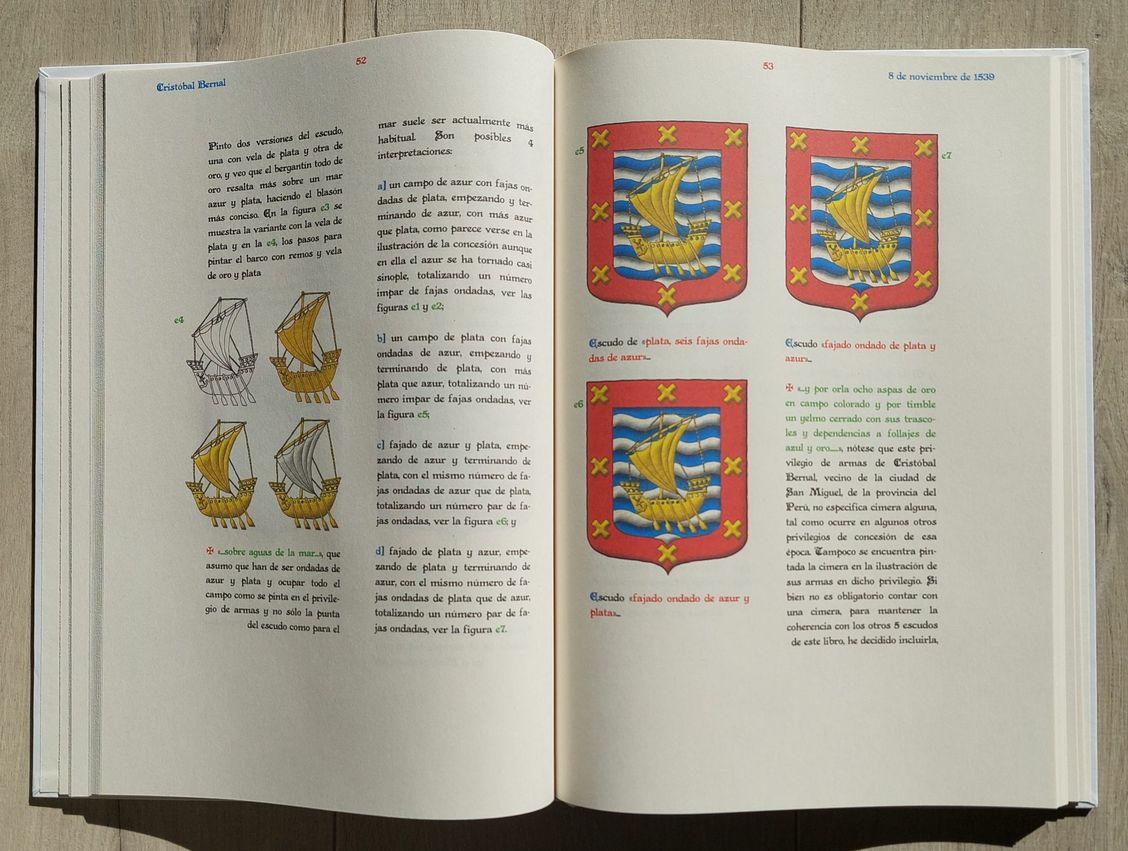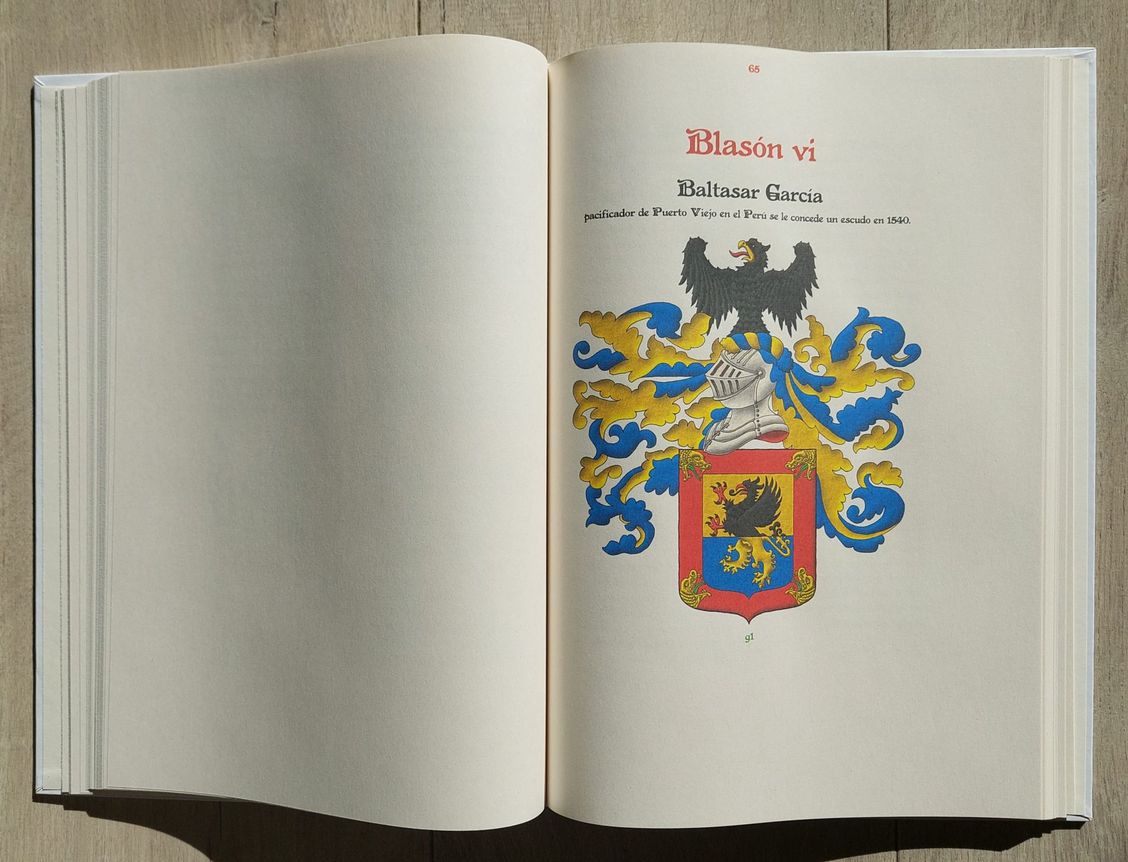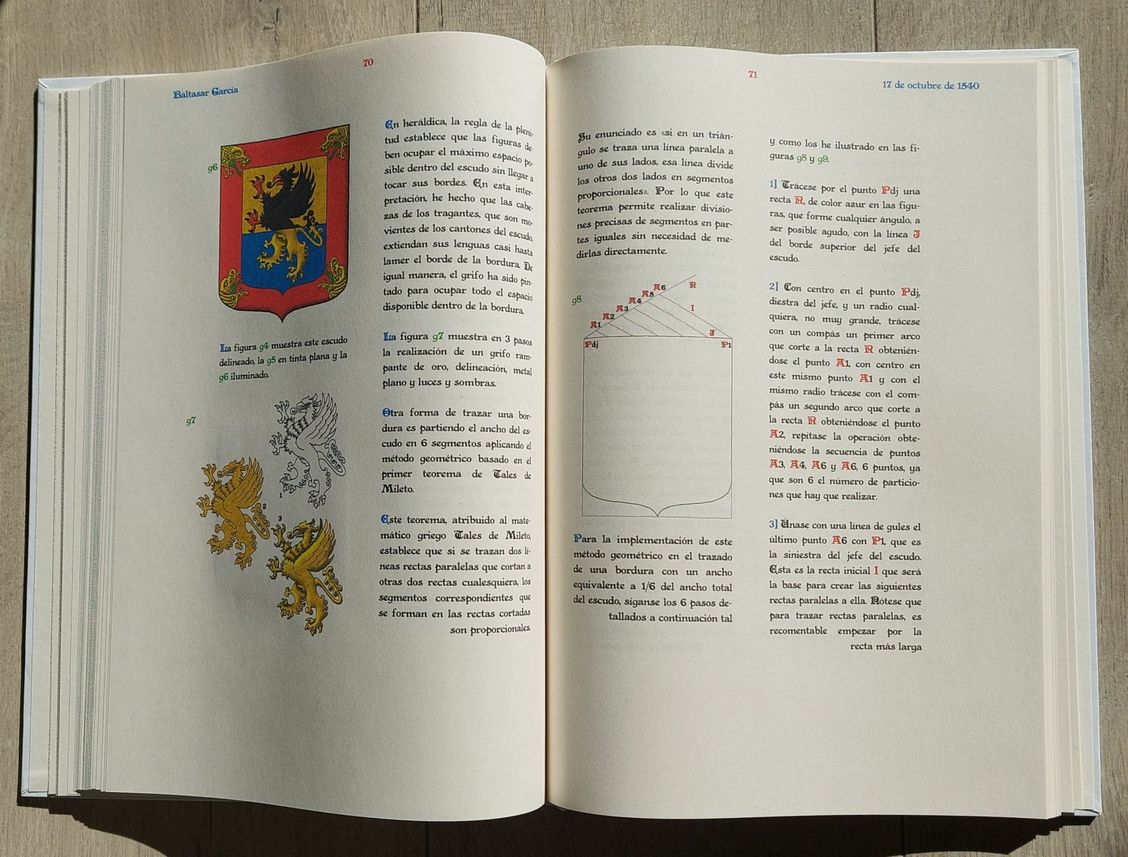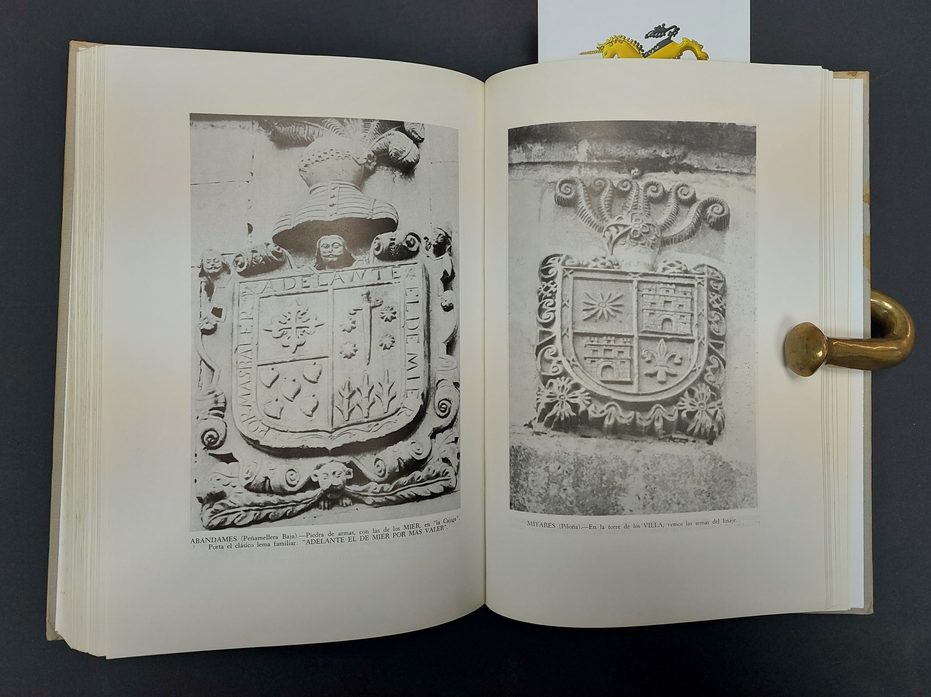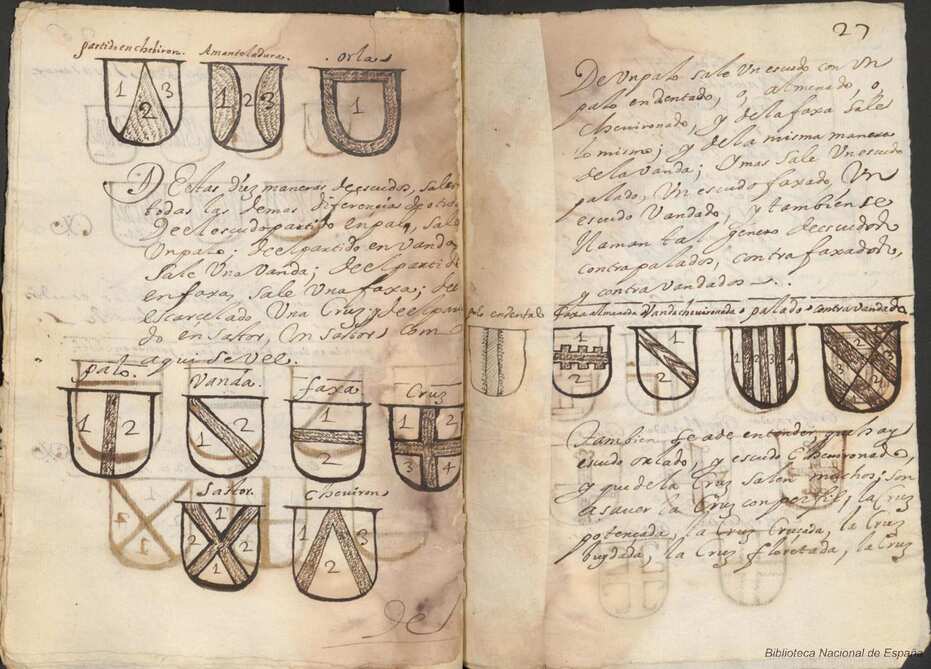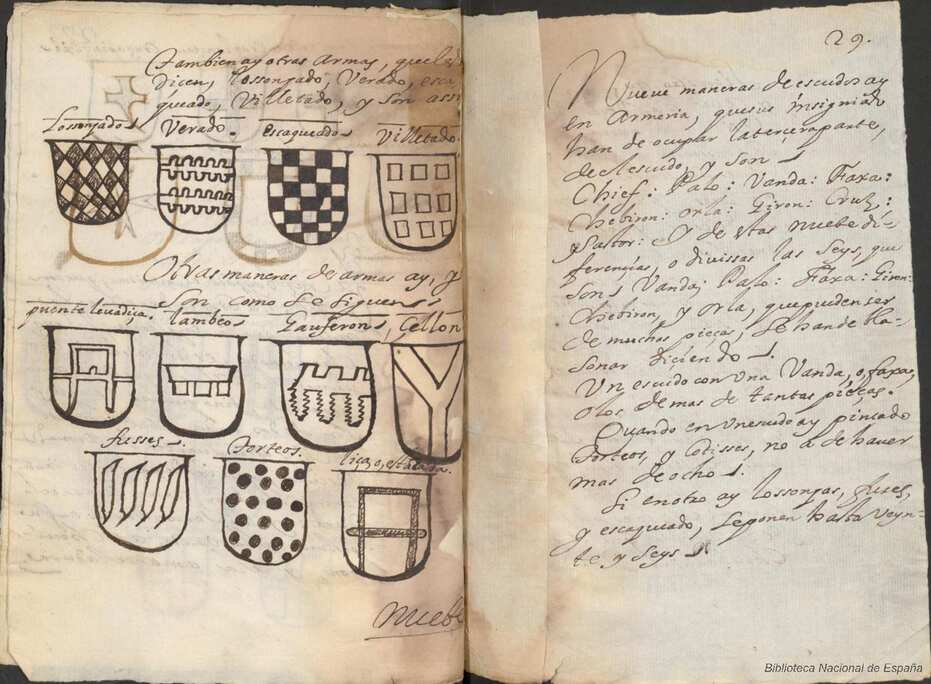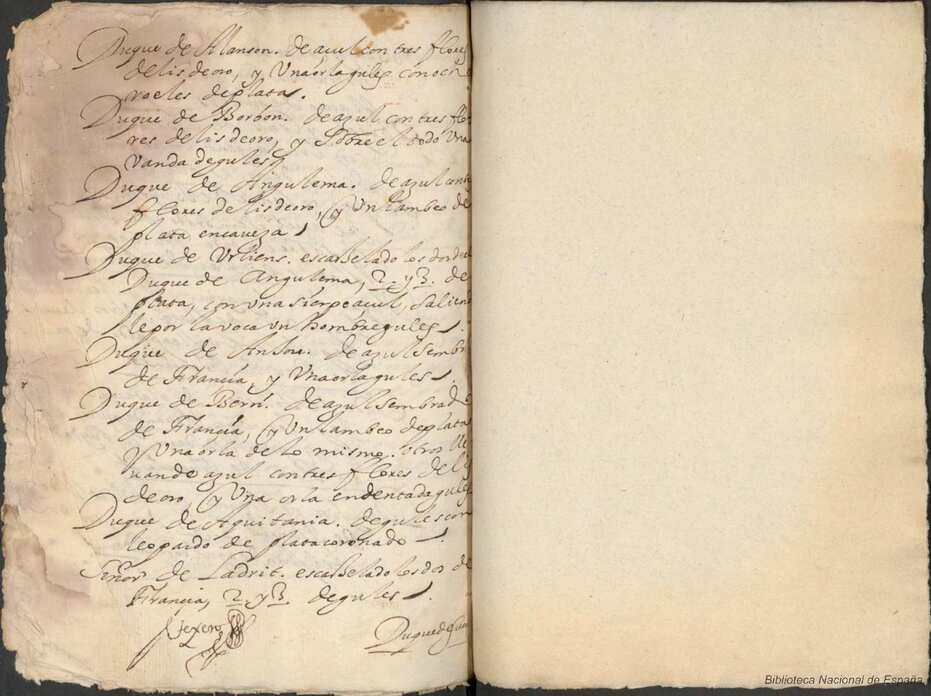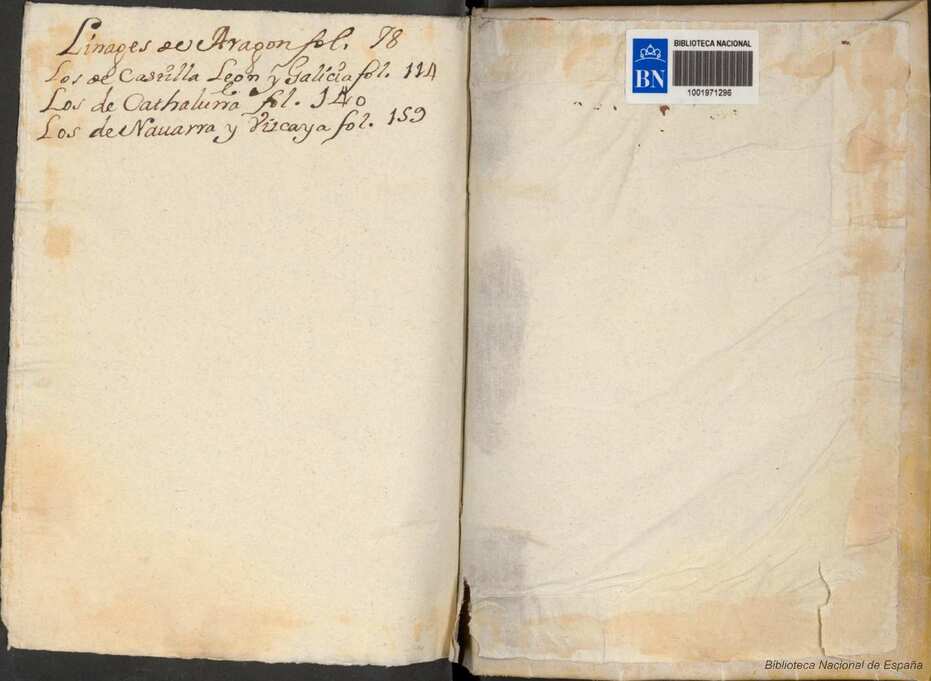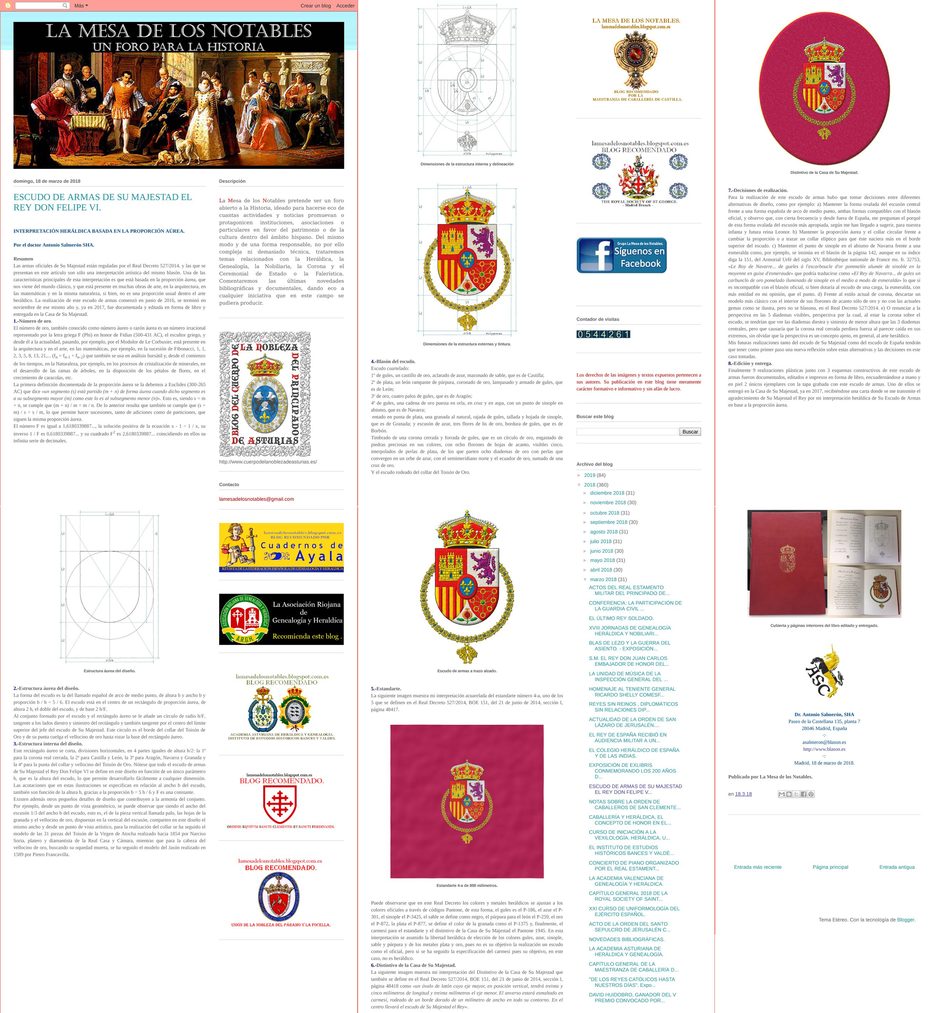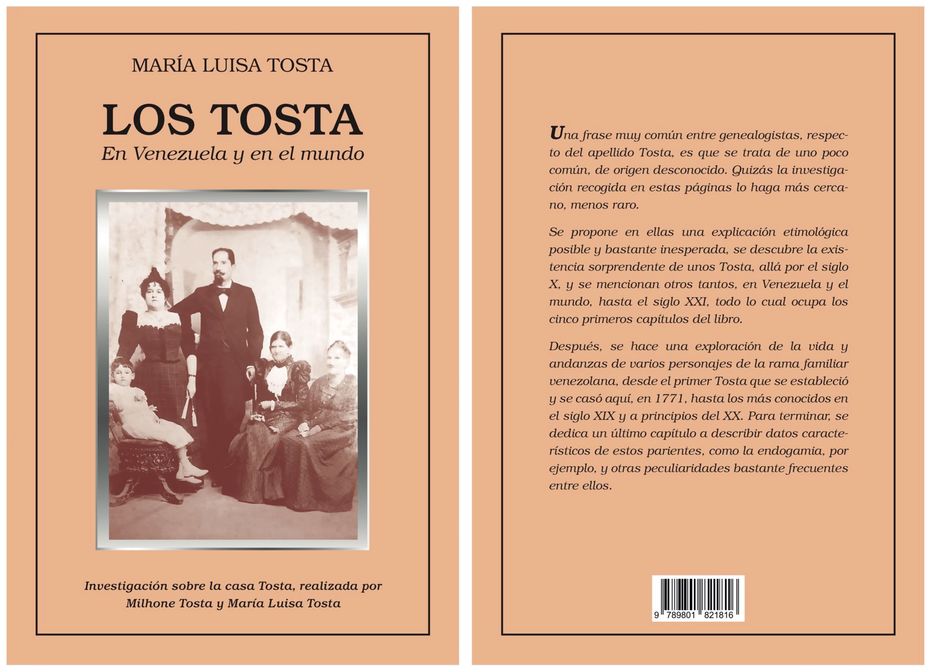Castilian language


![Ver [Académie internationale d'héraldique; 1952] en referencias bibliográficas. Libro abierto, hojas de plata, filo de oro, guardas de gules, tapas de sable.](../css/Libro.Bibliografia.png)
Académie internationale d'héraldique; 1952
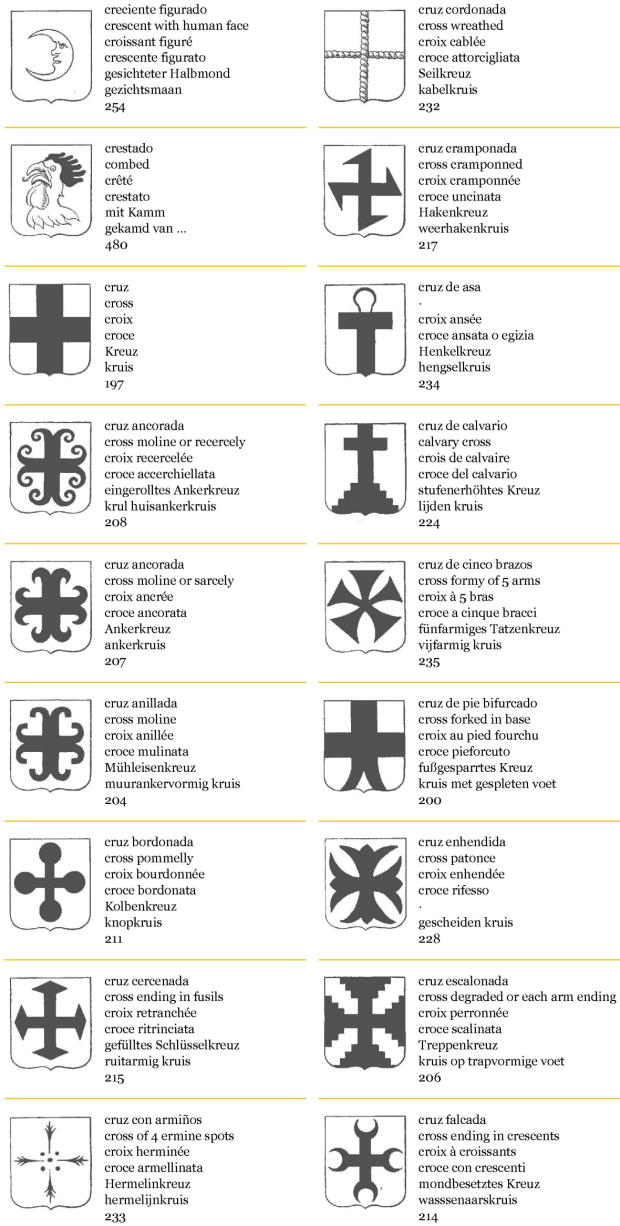
Académie internationale d'héraldique, AIH, «Vocabulaire-Atlas Héraldique en six Langues: Francais - English - Deutsch - Español - Italiano - Nederlandsch», by Gaston Stalins, Le Baron Stalins, with the collaboration of René Le Juge De Segrais, Ottfried Neubecker, Martin de Riquer y Morera, Giacomo Carlo Bascapé, and Mario Gorino-Causa, 119 pages, 530 black and white heraldic pictures, Société du Grand Armorial de France, 179 Boulevard Haussmann, París, 1952.
This book begins with the following sentence: «Heraldique - science et art - qui prit naissance en France vers la moitié du XIIe siècle, s'est propagée très rapidement dans les principaux pays européens».
The number of terms and words of the heraldry by languages is as follows:
- French language: 523 heraldic terms.
- Dutch language: 521 heraldic terms.
- German language: 519 heraldic terms.
- Spanish language: 511 heraldic terms.
- Italian language: 506 heraldic terms.
- English language: 502 heraldic terms.
The names of the authors and collaborators have been checked with [Académie internationale d'héraldique; 1999].
Its 530 heraldic illustrations correspond, according to my calculations to 509 drawings, numbered from 1 to 530. Some images contain several numbers, for example, the image that shows a coat of arms with its mantling, number 528, and its supporters, number 529, a griffin and a lion rampant, it is the same illustation, but with 2 numbers.
Bibliographical reference of century XXI.
Classification: Dictionary, French language, English language, German language, Castilian language, Italian language and Dutch language.
Authors:
- Stalins, Gaston.
- Le Juge De Segrais, René.
- Neubecker, Ottfried.
- Riquer y Morera, Martin de.
- Bascapé, Giacomo Carlo.
- Gorino-Causa, Mario.
The following articles cite this bibliographic reference:
- Ermine
- Ixai Lanzagorta Ochoa, plain tincture
- Pile issuant from the base in the Dictionary of the Spanish Language
- Sanz Lacorte, J.; 2007
- Sir Thomas Grenville II
- Val'Quirico, wreath an owl
External resource:
Internal resources: Aih1952.00.Vocabulaire.Original.pdf, Aih1952.01.Vocabulaire.Sefidn.pdf and Paper edition with a Swedish bookplate.


![Ver [Alfonso X of Castile; 1265] en referencias bibliográficas. Libro abierto, hojas de plata, filo de oro, guardas de gules, tapas de sable.](../css/Libro.Bibliografia.png)
Alfonso X of Castile; 1265
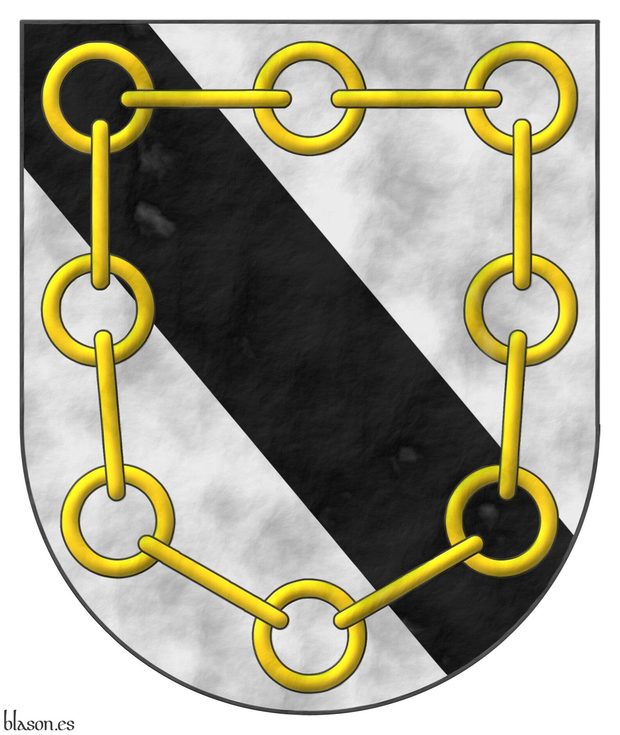
Alfonso X of Castile, The Wise, «The Seven-Part Code», its estimated completion year is 1265.
This is the copy I can consult, as it is available in the Hispanic Digital Library, it is a manuscript measuring 42 by 30 centimeters that once belonged to Álvaro de Zúñiga y Guzmán, first Duke of Arévalo, which later came into the possession of the Catholic Monarchs, initially Queen Isabella I of Castile, and after her death, King Ferdinand reclaimed it for the price of 5,251 maravedis. The original is housed in the National Library, in display case 4/6.
This copy, in addition to its numerous capital letters, has 8 illustrated pages, which according to its subsequent hand-numbering in pencil are:
- Page 6, among its illustrations can be seen 2 coats of arms of the Zúñiga family «Argent, a bend Sable, over all, a chain in orle Or», in this case formed by 16 links, 8 round and 8 more elongated placed in profile.
- Pages 106 and 191, on the latter can be seen a curious bishop-lizard climbing.
- Pages 294 and 331, on the 2nd at the bottom, a maiden is seen walking a monkey to relieve itself and to her right a fight of men with beast bodies.
- Page 379 and on its previous unnumbered page, and finally, on page 415 which begins with a tournament where the 2nd knight bears the ancient arms of France «Azure, semy of fleurs de lis Or».
The coat of arms that illustrates this bibliographic reference is that of Álvaro de Zúñiga y Guzmán. For the creation of his chain, I followed the illustration of his 2 coats of arms on the already mentioned page 6 of this manuscript.
It is one of my favorite manuscripts and, perhaps, the one with which I have created the most things.
Bibliographical reference of century XIII.
Classification: Castilian language, Manuscript and In color.
The author is Alfonso X of Castile.
Bibliographical reference mentioned in the following article:
External resources:
- National Library of Spain.
- Indirect access to the Library of Congress of the United States of America.
- Direct access to the Library of Congress of the United States of America.
Internal resources: AlfonsoXDeCastilla1265.7Partidas.10642.pdf.


![Ver [Anonymous; 1800a] en referencias bibliográficas. Libro abierto, hojas de plata, filo de oro, guardas de gules, tapas de sable.](../css/Libro.Bibliografia.png)
Anonymous; 1800a
Anonymous, «Armerías de España», 124 double pages, title in the page 9, provenance Duke of Osuna and Infantado, 1800.
Content
The book has no index and its content, written by hand, is as follows:
- Pages 1 through 8 are blank.
- On page 9, title, the letter A begins and surnames Abarca, Abendaño, Abeo, Ablitas and Abrego in large handwritten and the blazon in small handwritten (except for the end of the book on page 123, the unknown author seems to write more about surnames than about lineages).
- On page 10, the surnames with the letter A continue and their blazon both in small handwritten.
- On page 23, the letter B begins, its surnames and their blazons, for example, the Barrasas, in the page 25, «Or, six Lions proper, combatant».
- On page 30, the letter C begins, it is followed by the letter Z on page 42, 29 surnames with Z was written before the letter D and Cocas and Cuacas, with the letter C, are inserted inside the letter Z.
- It follows in alphabetical order of surnames from page 46, where the letter D begins, to page 97 with the letter S, including in the S the surname Sánchez on page 99, as a lineage will be included at the end of the book, and it follows with the letter S until the page 104.
- On page 105 the letter T begins, surname Tabixas, Taboadas, Tafuxes, ...
- On page 109 jump from the letter T to the letter V, with the surnames Vacas, Vadillos,... and skipping the letter U.
- On page 119, it returns from letter V to U, in an unordered manner and without including the title with the capital letter U.
- On page 120, begins the letter X and also the letter Y.
- On page 122, the letter Z and only 3 additional surnames with Z, recall that the majority of the surnames with Z were included after the letter C.
- On page 123 he returns to the surname Sánchez by testimony of Pedro de Soto owner of the books of Armory of Spain of Andreas Heredia, King of Arms, and finally the unknown author copies the text for the surname Sánchez, those who were «hijosdalgos, en Cangas de Gobadonga» ~ Covadonga of Asturias and ends with a poem of 8 verses. Andreas Heredia, also known as Andrés Heredia, was King of Arms during the reign of Philip III of Spain, [Nieto y Cortadellas, R.; 1957a; Page 4]
- Beginning on page 124 are blank.
Bibliographical reference of century XVIII.
Classification: Manuscript, Armorial roll, In black and white and Castilian language.
Author: unknown.
Bibliographical reference mentioned in the following article:
External links:
- Detail of this Armorial in the National Library of Spain.
- Bibliographic record of the National Library of Spain.
- Scanned Armorial in the National Library of Spain.
Internal resources: Osuna1800.ArmeriaEspaña.Manuscrito.pdf.


![Ver [Arco y García, F. del; 1996a] en referencias bibliográficas. Libro abierto, hojas de plata, filo de oro, guardas de gules, tapas de sable.](../css/Libro.Bibliografia.png)
Arco y García, F. del; 1996a
Fernando del Arco y García, «Introducción a la Heráldica», 142 pages, Collection Burgundy Pursuivant, edited by Prensa y Ediciones Iberoamericanas SL, printed by Gráficas Joma, Legal deposit M-5240, ISBN 84-86568-64-1, Madrid, 22nd of february of 1996.
In the image, you can see two pages of this book regarding his criteria on the war cry, the motto, and the legend. These criteria do not align with mine, as I follow [Sevilla Gómez, A.; 2000] and describe in Lema, divisa, mote y grito de guerra.
Bibliographical reference of century XX.
Classification: De bibliotheca, In black and white and Castilian language.
Author: Arco y García, Fernando del.
The following article cites this bibliographic reference:
Internal resources: Physical book on paper.


![Ver [Arco y García, F. del; 1996b] en referencias bibliográficas. Libro abierto, hojas de plata, filo de oro, guardas de gules, tapas de sable.](../css/Libro.Bibliografia.png)
Arco y García, F. del; 1996b
Fernando del Arco y García, «Método de blasonar», 75 pages, Perseverant Burgundy Collection, edited by Ateneist Group of Vexilological, Heraldic and Genealogical Studies, printed by Gráficas Joma, Legal deposit M. M-5240, ISBN 84-606-2768-3, Madrid, 1996.
Bibliographical reference of century XX.
Classification: De bibliotheca, In black and white and Castilian language.
The author is Arco y García, Fernando del.
Bibliographical reference mentioned in the following article:
Internal resources: Physical book on paper.


![Ver [Argote de Molina, G.; 1588] en referencias bibliográficas. Libro abierto, hojas de plata, filo de oro, guardas de gules, tapas de sable.](../css/Libro.Bibliografia.png)
Argote de Molina, G.; 1588
Gonzalo Argote de Molina, «Nobleza de Andalucía», dedicated to King Philip II of Spain, with about 500 coat of arms engraved, printed by Fernando Díaz, Seville, 1588.
There are other editions, for example, the edition by Francisco López Vizcaíno, 799 pages, Jaen, 1867, or facsimile edition by Riquelme y Vargas Ediciones SL, Jaén, 1991, my copy is the number 1268.
Bibliographical reference of century XVI.
Classification: De bibliotheca, Castilian language and In black and white.
The author is Argote de Molina, Gonzalo.
The following articles cite this bibliographic reference:
- Alfonso IX of Leon
- Alfonso VIII of Castile
- Argote de Molina, Gonzalo
- James I of Aragon
- Álvaro de Zúñiga y Guzmán
External links:
- Virtual Library of Andalusia, 1867.
- Digital Library Madrid's memory, 1588 edition from page 6 missing cover and initial pages.
- National Library of Spain, bibliographic record, there are 2 copies of the edición of 1588.
- National Library of Spain, edition of 1588, cover of the first copy.
- National Library of Spain, edition of 1588, cover of the second copy, this has more resolution than the previous copy.
- Google Books, the second book and not complete.
Internal resources: ArgoteMolinaG1588.22.NoblezaAndalucia.Madrid.pdf is the edition of the year 1588 in PDF digital format, ArgoteMolinaG1588.23.Bne.Baja.resolucion.R10805.pdf is the edition of the year 1588 in PDF digital format and low resolution, ArgoteMolinaG1588.24.Bne.Alta.resolucion.R26842.pdf is the edition of the year 1588 in PDF digital format and hight resolution, ArgoteMolinaG1588.25.NoblezaAndalucia.1867.pdf is the edition of the year 1866 in PDF digital format for Adobe Reader only and a facsimile edition as a physical book on paper.


![Ver [Atienza y Navajas, J. de; 1959] en referencias bibliográficas. Libro abierto, hojas de plata, filo de oro, guardas de gules, tapas de sable.](../css/Libro.Bibliografia.png)
Atienza y Navajas, J. de; 1959
Julio de Atienza y Navajas, Baron of the Cobos de Belchite, «Nobiliario Español: Diccionario Heráldico de Apellidos y Títulos», 1st edition, edited by Aguilar, 1,712 pages, 2 volumes, Madrid, 1959.
It is a monumental work that includes a heraldic dictionary and blazons of Spanish lineages and noble titles, along with the history and genealogy of thousands of Spanish families.
Bibliographical reference of century XX.
Classification: Castilian language, In black and white and De bibliotheca.
Author: Atienza y Navajas, Julio de.
The following article cites this bibliographic reference:
Internal resources: Physical book on paper, 2 volumes.


![Ver [Avilés, J.; 1725a] en referencias bibliográficas. Libro abierto, hojas de plata, filo de oro, guardas de gules, tapas de sable.](../css/Libro.Bibliografia.png)
Avilés, J.; 1725a
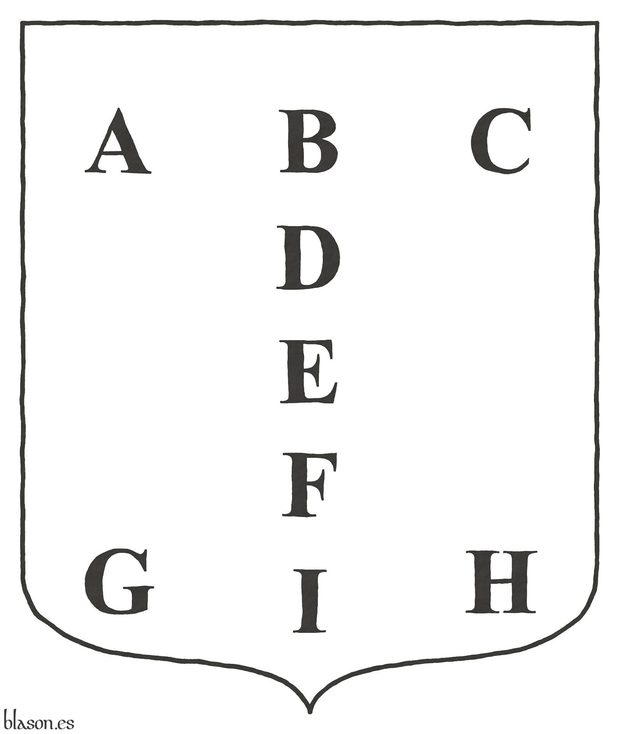
José de Avilés e Iturbide, Marquis of Aviles, member of the Supreme Council of War, «Ciencia heroyca, reducida a las leyes heráldicas del blasón: Ilustrada con exemplares de todas las piezas, figuras y ornamentos de que puede componerse un escudo de armas interior y exteriormente, Volume I», dedicated to Juan Bautista de Orendyn of His Majesty's Council, printed by Juan Piferrer of the Ángel's Square, 530 pages, Barcelona, 1725.
I also usually consult Volume I of the edition [Avilés, J.; 1780a].
Contents of Volume One
- Cover page.
- Dedication.
- Censor's review from 1724.
- Approval.
- To the reader.
- Epigram.
- Summary of privileges.
- Summary of the price.
- Plate index.
- Warnings.
- Errata sheet for each of the treatises.
- Additions.
- Table of the treatises.
- 378 pages for its 4 treatises: Treatise I with 3 chapters and a dictionary, Treatise II with 3 chapters, Treatise III with 3 chapters, and Treatise IV with 4 chapters.
- 34 plates with more than 650 coats of arms arranged at the end of each treatise, as follows: Plates 1 to 16 at the end of Treatise I, Plates 17 to 19 at the end of Treatise II, Plate 20 at the end of Treatise III, and Plates 21 to 34 at the end of Treatise IV.
- Index of terms, words, and figures specific to blazonry.
- Index of cities, titles, and families with coats of arms blazoned in this second volume.
Bordure compony
Bibliographical reference of century XVIII.
Classification: De bibliotheca, In black and white and Castilian language.
Author: Avilés e Iturbide, José.
The following articles cite this bibliographic reference:
- Adrian V
- Baudry in France
- Bourgeois, lineage of Burgundy
- Criteria used by its title
- Dancetty, ratio, points and blazon
- Edmund Plantagenet
- Enrique Fernández Marqués, two supporters
- Ferdinand II of Leon
- Flanched, schemaat one-fifth
- Hector of Troy
- Hector of Troy, Sable
- Hufflepuff House with 2 badgers
- Innocent IV
- Leonor de Aquitania
- Navarre
- Nhf, Norsk Heraldisk Forening
- Oschoven of the Rhin
- Pile issuant from the base in the Dictionary of the Spanish Language
- Richard I of England
- The Heraldry Society of Scotland
- Triangulation 1, contre-embrassés, chapé, embrassé, and chaussé
- Triangulation 2, chaussé, contre-embrassé, embrassé, and chapé
- Triangulation 6, embrassé, chaussé, chapé, and contre-embrassé
- Triangulation 7, chaussé, contre-embrassé, embrassé, and chapé
External resources:
- Valencian Digital Library, records for the Volumes I and II.
- Valencian Digital Library, content of Volume I.
Internal resources: AvilesJ1725.Tomo.I.pdf.


![Ver [Avilés, J.; 1725b] en referencias bibliográficas. Libro abierto, hojas de plata, filo de oro, guardas de gules, tapas de sable.](../css/Libro.Bibliografia.png)
Avilés, J.; 1725b
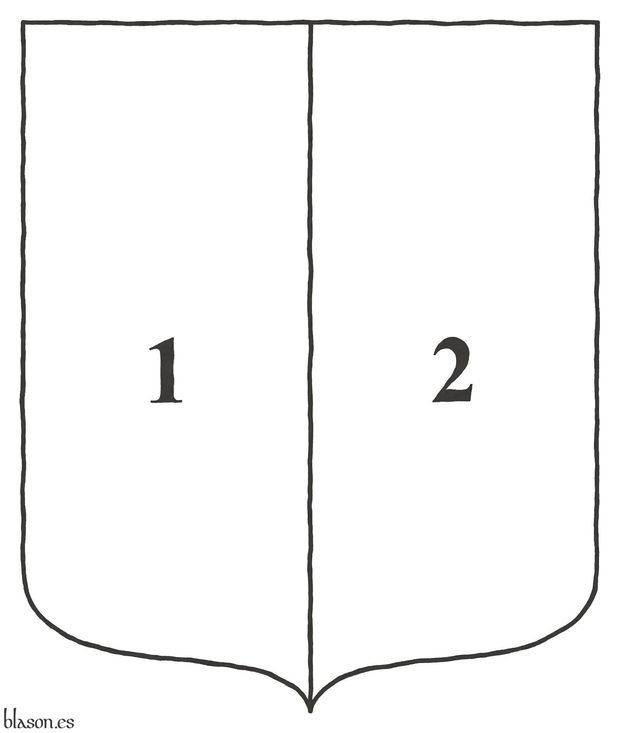
José de Avilés e Iturbide, Marquis of Aviles, member of the Supreme Council of War, «Ciencia heroyca, reducida a las leyes heráldicas del blasón: Ilustrada con exemplares de todas las piezas, figuras y ornamentos de que puede componerse un escudo de armas interior y exteriormente, Volume II», dedicated to Juan Bautista de Orendyn (Juan Bautista de Orendáin y Azpilicueta) of His Majesty's Council, printed by Juan Piferrer of the Ángel's Square, 404 pages, Barcelona, 1725.
I also usually consult Volume I of the edition [Avilés, J.; 1780b].
Contents of Volume Two
- Cover page.
- To the reader.
- Errata sheet for each of the treatises.
- Summary of the price.
- Table of the treatises.
- Plate index.
- Warnings.
- 319 pages for its 4 treatises: Treatise I with 6 chapters, Treatise II with 3 chapters, Treatise III with 4 chapters, and Treatise IV with 13 chapters.
- 25 plates with hundreds of coats of arms and illustrative figures arranged at the end of each treatise, as follows: Plates 1 to 16 at the end of Treatise I, Plates 17 to 19 at the end of Treatise II, Plates 20 to 24 at the end of Treatise III, and Plate 25 at the end of Treatise IV.
- Index of terms, words, and figures specific to blazonry.
- Index of cities, titles, and families with coats of arms blazoned in this second volume.
Crown of count
Infamed arms
Bibliographical reference of century XVIII.
Classification: De bibliotheca, In black and white and Castilian language.
Author: Avilés e Iturbide, José.
Here are the articles quoting this reference:
External resources:
- Valencian Digital Library, records for the Volumes I and II.
- Valencian Digital Library, content of Volume II.
Internal resources: AvilesJ1725.Tomo.II.pdf.


![Ver [Avilés, J.; 1780a] en referencias bibliográficas. Libro abierto, hojas de plata, filo de oro, guardas de gules, tapas de sable.](../css/Libro.Bibliografia.png)
Avilés, J.; 1780a
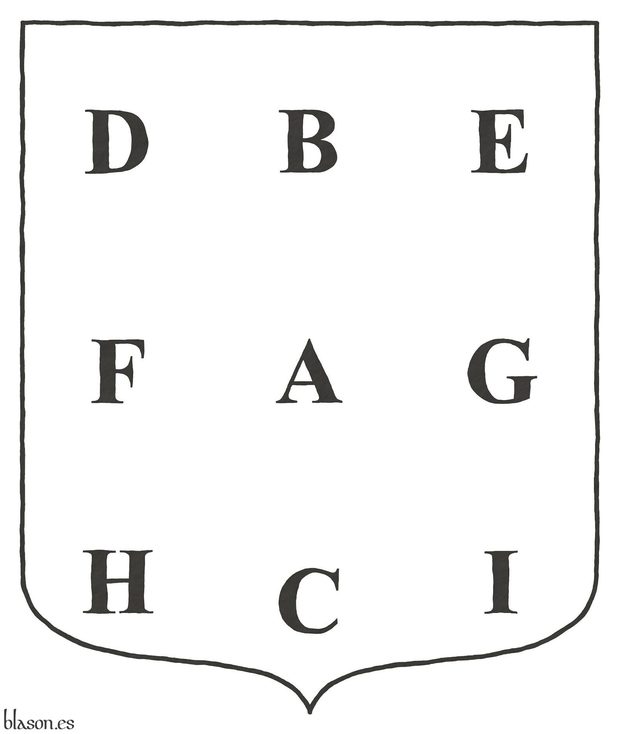
José de Avilés e Iturbide, Marquis of Aviles, member of the Supreme Council of War, «Ciencia heroyca, reducida a las leyes heráldicas del blasón: Ilustrada con exemplares de todas las piezas, figuras y ornamentos de que puede componerse un escudo de armas interior y exteriormente, Volume I», edition of Joaquín Ibarra, printer of his Majesty's Chamber, at the expense of the Company of Printers and Booksellers of the Kingdom, 526 pages, Madrid, 1780.
The first edition is [Avilés, J.; 1725a] and this edition is 14 years after the death of José de Avilés, that happened in 1766.
Page Examples
Bibliographical reference of century XVIII.
Classification: In black and white and Castilian language.
Author: Avilés e Iturbide, José.
The following articles cite this bibliographic reference:
- Adrian V
- Avilés, J.; 1725a
- Bourgeois, lineage of Burgundy
- Dancetty, ratio, points and blazon
- David B. Appleton, slipped and leaved
- Enrique Fernández Marqués, two supporters
- Ferdinand II of Leon
- Holy Trinity
- Hufflepuff House with 2 badgers
- Innocent IV
- Jesus Christ, preparation schema
- Jesus Christ, with bezants Or
- Kimon Andreou, contourné
- Kimon Andreou, eradicated
- Latidos Podencos, Azure and Argent version
- Latidos Podencos, Azure and Argent version with motto
- Latidos Podencos, seal of the animal protection organization
- Leonor de Aquitania
- Leonor de Aquitania y Enrique de Inglaterra
- Lozengy 5x6 and 6x7
- Navarra, chains Or
- Nhf, Norsk Heraldisk Forening
- Norsk Heraldisk Forening, coat of arms
- Pile issuant from the base in the Dictionary of the Spanish Language
- Ponce I of Urgell
- Royal Spanish Academy, coat of arms
- Sebastián González Montenegro en Doce Linajes
- Thomas de Warbleton
- Urgell, County of
External link:


![Ver [Avilés, J.; 1780b] en referencias bibliográficas. Libro abierto, hojas de plata, filo de oro, guardas de gules, tapas de sable.](../css/Libro.Bibliografia.png)
Avilés, J.; 1780b
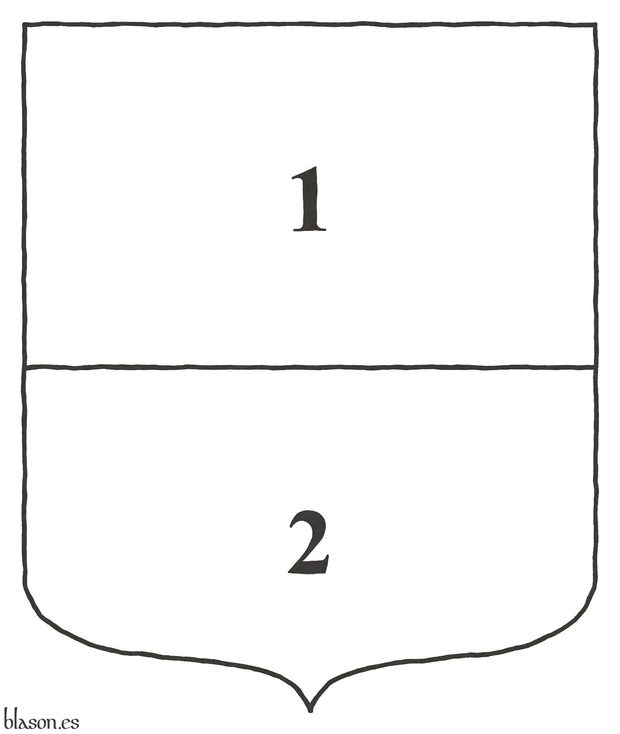
José de Avilés e Iturbide, Marquis of Aviles, member of the Supreme Council of War, «Ciencia heroyca, reducida a las leyes heráldicas del blasón: Ilustrada con exemplares de todas las piezas, figuras y ornamentos de que puede componerse un escudo de armas interior y exteriormente, Tomo II», edition of Joaquín Ibarra, printer of his Majesty's Chamber, at the expense of the Company of Printers and Booksellers of the Kingdom, 440 pages, Madrid, 1780.
The first edition is [Avilés, J.; 1725b] and this edition is 14 years after the death of José de Avilés, that happened in 1766.
Helm of squire, knight, 39, and hidalgo, 40
Bibliographical reference of century XVIII.
Classification: In black and white and Castilian language.
Author: Avilés e Iturbide, José.
Here are the articles quoting this reference:
- Alcantara, Order of
- Avilés, J.; 1725b
- Calatrava, Order of
- David B. Appleton, slipped and leaved
- Godfrey V, Count of Anjou
- Montesa, Order of
- Order of Alcantara, emblem
- Order of Calatrava, emblem
- Order of Montesa, emblem
- Order of Santiago, emblem
- Santiago, Order of
External resource:


![Ver [Avilés, T. de; XVI] en referencias bibliográficas. Libro abierto, hojas de plata, filo de oro, guardas de gules, tapas de sable.](../css/Libro.Bibliografia.png)
Avilés, T. de; XVI
Tirso de Avilés, continued by Martín de Bolea y Castro, «Roll of arms», 3 volumes, Volume I, coats of arms of kings, princes and grand titles, 208 hand-numbered pages in Roman numerals, Volume II, coats of arms of noble and private titles, 129 hand-numbered pages in Arabic numerals, Volume III, coats of arms of popes, cardinals, archbishops and bishops, 185 hand-numbered pages in Arabic numerals, in the National Library of Spain, signatures Mss/12550 V.1, Mss/12551 V.2 and Mss/12552 V.3, it is estimated from the XVI century.
Bibliographical reference of century XVI.
Classification: Manuscript, Armorial roll, In color and Castilian language.
The author is Avilés, Tirso de.
Bibliographical reference mentioned in the following article:
External resources:
- Detail of this armorial in the National Library of Spain.
- Bibliographic record of the National Library of Spain.
- Scanned Armorial in the National Library of Spain.
Internal resources: Volume I AvilesTdeXVI.11.Tomo01.pdf, Volume II AvilesTdeXVI.11.Tomo02.pdf and Volume III AvilesTdeXVI.11.Tomo03.pdf.
Credits: This book belongs to the Biblioteca Nacional de España. License Creative Commons CC-BY. You may share, transform and create from images in the public domain that are accessible in the Hispanic Digital Library.


![Ver [Bravo Guarida, C.; 1934] en referencias bibliográficas. Libro abierto, hojas de plata, filo de oro, guardas de gules, tapas de sable.](../css/Libro.Bibliografia.png)
Bravo Guarida, C.; 1934
Clemente Bravo Guarida, «El Paso Honroso de Don Suero de Quiñones: Célebre Caballero Leonés en el Puente de Órbigo, en 1434», second edition, published by «El Diario de León» to commemorate the fifth centenary of this famous feat of arms, 59 pages, printed by Imprenta Católica, León, 1934.
This edition, written by Clemente Bravo Guarida, provides an updated account of the famous «Passo Honroso», [Rodríguez de Lena, P.; Century XVI], undertaken by the renowned knight Suero de Quiñones in 1434 at the bridge of Órbigo.
The book includes the full list of the 10 maintainers on page 57, and the 68 challengers, or adventurers, on pages 67 and 68. It also reports the results of the jousts for all participants.
Please note a correction: on page 58, where it reads «Loque de la Torre, corrió 6, rompió 4» it should instead say «Lope de la Torre, corrió 6, rompió 4».
Bibliographical reference of century XX.
Classification: Castilian language and In black and white.
The author is Bravo Guarida, Clemente.
Bibliographical reference mentioned in the following article:
Internal resources: BravoGuaridaC1934.PasoHonroso.Ocr.pdf.


![Ver [Calvo, P.; 1501] en referencias bibliográficas. Libro abierto, hojas de plata, filo de oro, guardas de gules, tapas de sable.](../css/Libro.Bibliografia.png)
Calvo, P.; 1501
Pedro Calvo, notary and alderman of the city of Calatayud, «Libro de cuentas de la ciudad de Calatayud» ~ «Account book of the city of Calatayud», literal title, «Libro dela data fecha por pedro calvo notao Regidor dela ciutat de Calatayut enel anyo de mil Quinientos y uno», manuscript restored with cover, back cover and Mudejar style binding, 2 blank pages behind the cover and the back cover, 76 inner pages of 300 x 230 mm, of which 7 could be in white and in even position, 3 in white among the first 20 pages, 1 blank towards the middle of the book and another 3 blank between the last 20 pages, final annotation with the term «cabreo», Calatayud, 1501.
Bibliographical reference of century XVI.
Classification: Manuscript, In black and white and Castilian language.
Author: Calvo, Pedro.
External resources:
- Documents and archives of Aragon, DARA Medieval, registry of the book and link to the image included here.
- Name of the Latin written after the fall of the Roman Empire and during the Middle Ages.
Internal resources: CalvoP1501.CalatayudDataOriginal.pdf book as a sequence of available pages and CalvoP1501.CalatayudDataPaginado.pdf book recomposed in sequence of odd and even pages, with blank pages inserted to recover lost sequences.


![Ver [Cervantes Saavedra, M. de; 1605] en referencias bibliográficas. Libro abierto, hojas de plata, filo de oro, guardas de gules, tapas de sable.](../css/Libro.Bibliografia.png)
Cervantes Saavedra, M. de; 1605
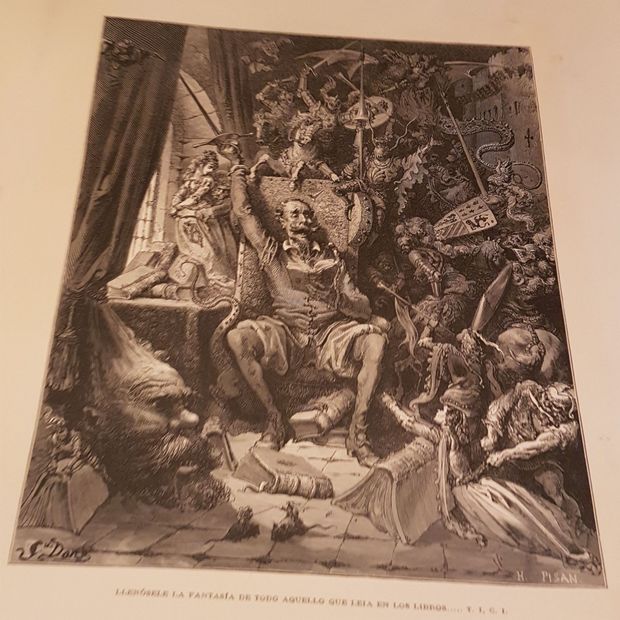
Miguel de Cervantes Saavedra, «El Ingenioso Hidalgo Don Quijote de la Mancha», edition with illustrations by Gustavo Doré, engravings by H. Pisan, in 2 volumes, printed by Imprenta y Librería Religiosa y Científica del Heredero de Don Pablo Riera, Robador Street, 24 and 26, Barcelona, 1875.
Original publication date
The original edition of «El Ingenioso Hidalgo Don Quijote de la Mancha» was published in 1605, with the second part released in 1615.
Illustrated edition details
This 1875 edition is notable for its elaborate illustrations by Gustavo Doré, a renowned French artist, and the detailed engravings by H. Pisan. The illustrations add a rich visual element to Cervantes' classic text, making this edition a significant artistic interpretation of the original work.
First Part, Chapter XVIII, excerpt
«—That knight you see over there with the yellow arms», Or,
«who bears on his shield a crowned lion,
bowed at the feet of a maiden,
is the valiant Laurcalco,
lord of the Silver Bridge;
the other with the golden flowered arms,
who bears on his shield three silver crowns on a blue field,
is the feared Micocolembo, grand duke of Quirocia;
the other with giant limbs,
who stands to his right hand,
is the never fearful Brandabarbarán de Boliche,
lord of the three Arabias,
who comes armed with that serpent's hide and
bears on his shield a door, which, according to legend,
is one of the doors of the temple that Samson destroyed when
he avenged himself on his enemies with his death.
But turn your eyes to the other side and
you will see before and in front
of the other army the always victorious and never defeated
Timonel of Carcajona, prince of New Biscay,
who comes armed with quartered arms,
blue, green, white, and yellow, and bears on his shield
a golden cat on a tawny field,
with an inscription that says «Miau»,
which is the beginning of his lady's name, who,
as they say, is the incomparable Miulina,
daughter of the duke Alfeñiquén of Algarve;
the other who presses down the back of that powerful steed,
who bears arms as white as snow and a shield white and
without any charges, is a novice knight, of French nation,
named Pierres Papín, lord of the baronies of Utrique;
the other who strikes the flanks with the iron-shod heels
of that painted and swift zebra and bears
the blue vair arms,
is the powerful duke of Nerbia, Espartafilardo del Bosque,
who bears as a charge on his shield an asparagus plant,
with an inscription in Castilian that says: «Tracks my fate».
And in this way, he went on naming many knights
from one and the other squadron that he imagined,
and to each of them, he gave
arms, colors, charges, and mottos on the spot,
driven by the imagination of his never-before-seen madness, and,
without stopping, he continued saying...».
Bibliographical reference of century XVII.
Classification: Castilian language and In black and white.
The author is Cervantes Saavedra, Miguel de.
Bibliographic reference mentioned in the following articles:


![Ver [Chaparro D'Acosta L.; 1979] en referencias bibliográficas. Libro abierto, hojas de plata, filo de oro, guardas de gules, tapas de sable.](../css/Libro.Bibliografia.png)
Chaparro D'Acosta L.; 1979
Lino Chaparro D'Acosta, «Heráldica de los Apellidos Canarios», foreword by Vicente de Cadenas y Vicent, 2 volumes, Volume I from A to L, 285 surnames, 293 pages, Volume II from M to Z and a heraldic dictionary, 387 surnames, 439 pages, edited by Estudios Tecnicos del Blason, ISBN of the complete work 84-300-2000-4, ISBN of Volume I 84-300-1989-8, ISBN of Volume I II 84-300-418010-8, Las Palmas de Gran Canaria, 1979.
Bibliographical reference of century XX.
Classification: Black and white with color plates and Castilian language.
The author is Chaparro D'Acosta, Lino.
The following article cites this bibliographic reference:


Claudia Trujillo Jiménez, page of armorial

Purpure, three dragons passant, in pale Argent; a bordure Gules, eight saltires couped Or. Crest: A crown of the Sovereign and Most Noble Order of the Pomegranate. The shield is surrounded by the Grand Collar of the Sovereign and Most Noble Order of the Pomegranate.
This is her coat of arms of emblazoned by me for the Roll of Arms of the Sovereign and Most Noble Order of the Pomegranate.
Blazon keywords: Without divisions, Purpure, Three, Dragon, Passant, In pale, Argent, One, Bordure, Gules, Eight, Saltire, Or, Crest and mantling, Crown, Pomegranate, Surrounded and Grand collar.
Style keywords: Ogee, Outlined in sable, Illuminated and Leather.
Classification: Personal, Interpreted, Coat of arms, Armorial roll and Castilian language.
Bearer: Trujillo Jiménez, Hermanos.


![Ver [Cofradía de Santiago; Century XIV] en referencias bibliográficas. Libro abierto, hojas de plata, filo de oro, guardas de gules, tapas de sable.](../css/Libro.Bibliografia.png)
Cofradía de Santiago; Century XIV
Anonymous, «Libro de la Cofradía de Caballeros de Santiago de la Fuente», held by the Brotherhood of Santiago, Burgos Cathedral, manuscript, illustrated, 94 leaves, 21 missing, folio size, 29 x 21 centimeters, Burgos, 1338-1636.
Introduction
The illuminated manuscript chronicles the history and membership of the Brotherhood of Knights of Santiago in Burgos. Founded in 1338 during the reign of King Alfonso XI, as indicated by the preamble to the Rule on folio 27 verso, the Brotherhood was composed of members of the social and political elite of Burgos. The manuscript spans several centuries, primarily from the 14th to the 17th century.
The first 13 folios include a record of four deeds dating from 1396 to 1415, all related to the financial dealings of the Brotherhood.
Folio 14 marks the beginning of the original Rule of the Brotherhood, adorned with an illuminated initial «E» and a vignette of Christ flanked by saints and angels.
Portraits and illumination
The manuscript includes a list of the members, known as «cofrades» in Castilian, alongside their portraits and coats of arms. The book contains 295 portraits, added over time, with the last one dated to 1636.
The knights depicted in the manuscript held significant roles in the city, such as mayors, scribes, and other high offices. Many of the knights' families, like the Camargos from France and the Sanchestels from England, are noted for their diverse origins.
The portraits begin on page 21, initially with four to a page until folio 44, after which the number decreases to three, two, and eventually single figures per page.
Binding and preservation
The manuscript is bound in red leather with gold fillets and clasps, a 19th-century binding aimed at preserving the parchment pages. Originally, it had 94 leaves, but 21 are now missing, as noted in a contemporary annotation at the front.
Bibliographical reference of century XIV.
Classification: Manuscript, Armorial roll, Castilian language and In color.
Author: unknown.
Here are the articles quoting this reference:
Internal resources: 86 images in JPEG format.


![Ver [Col, J. J. del; 2007] en referencias bibliográficas. Libro abierto, hojas de plata, filo de oro, guardas de gules, tapas de sable.](../css/Libro.Bibliografia.png)
Col, J. J. del; 2007
José Juan del Col, «Auxiliary Dictionary: Spanish-Latin for Modern Latin Use», Instituto Superior Juan XXIII, edited by Adrian Mandara, composition and layout by Zulma Iglesias and Daniel Cirio, 1250 pages, 23x17 centimeters, ISBN 978-950-9771-34-5, printed in Argentina by Sapienza Industria Gráfica, Undiano 84, Bahía Blanca, 2007.
Bibliographical reference of century XXI.
Classification: Dictionary, Castilian language and In black and white.
The author is Col, José Juan del.
Internal resources: ColJJdel2007.LatinDiccionario.pdf PDF format.


![Ver [Costa y Turell, M.; 1858] en referencias bibliográficas. Libro abierto, hojas de plata, filo de oro, guardas de gules, tapas de sable.](../css/Libro.Bibliografia.png)
Costa y Turell, M.; 1858
Modesto Costa y Turell, «Tratado completo de la ciencia del blasón, o sea, Código heráldico-histórico; acompañado de una estensa noticia de todas las órdenes de caballería existentes y abolidas», Second edition corrected and augmented, 7 pages of prologue, 554 page, 26 pages with illustrations; size 25 centimeters, published by Libreria Española y Libreria de El Plus Ultra, Madrid, 1858.
Bibliographical reference of century XIX.
Classification: Castilian language and In black and white.
Author: Costa y Turell, Modesto.
The following article cites this bibliographic reference:
External resources:
Internal resources: CostaTurellM1858.33.paginas.597.pdf in PDF format for Adobe Reader.


Crest and motto of David Ryan Shorey
Sable, a dolphin naiant Or; a chief embattled Vert, fimbriated Or. Crest: Upon a helm, with a wreath Or and Vert, a cornish chough speaking proper, his dexter foot grasping the point of a mullet Gules. Mantling: Vert doubled Or. Motto: «Siempre Adelante».
Blazon keywords: Sable, Dolphin, Naiant, Or, Chief, Embattled, Vert, Fimbriated, Crest and mantling, Helm, Mantling, Wreath, Crest, Speaking, Proper, Grasping, Mullet, Gules and Motto.
Style keywords: Ogee, Outlined in sable, Illuminated and Leather.
Classification: Personal, Interpreted, Coat of arms and Castilian language.
Bearer: Shorey, David Ryan.


![Ver [Cuena Bartolomé, J.; 1968] en referencias bibliográficas. Libro abierto, hojas de plata, filo de oro, guardas de gules, tapas de sable.](../css/Libro.Bibliografia.png)
Cuena Bartolomé, J.; 1968
José Cuena Bartolomé, Doctor of Civil Engineering (Roads, Canals and Harbours) of the Computing Office of the Center for Studies and Experimentation of Public Works, «The ordered trial of solutions in hydraulic systems by means of mathematical simulation models on an electronic computer» Journal of «Obras Públicas» del College of Roads, Canals and Harbours, 115, volume I, number 3038, pages 413-430, ISSN 0034-8619, ISSN electronic 1695-4408, Legal Deposit M-156-1958, Madrid, June 1968.
Bibliographical reference of century XX.
Classification: Magazine and Castilian language.
Author: José Cuena Bartolomé.
The following article cites this bibliographic reference:


![Ver [de Pando Villarroya, J. L. P. V.; 2006] en referencias bibliográficas. Libro abierto, hojas de plata, filo de oro, guardas de gules, tapas de sable.](../css/Libro.Bibliografia.png)
de Pando Villarroya, J. L. P. V.; 2006
José Luís Patricio Vicente de Pando Villarroya, Doctor in Information Sciences by the Complutense University of Madrid, «Historical Sciences, Heraldic Terms», on-line publication, in the domine dictionariesdigitales.net registered on 11th of January of 2006.
Release date
The release date is taken from Archive.org, checking when this «Heraldic Glossary» appeared for the first time in the record log series.
Heraldic glossary
It originally contains 676 heraldic terms without illustrations and 694 definitions.
Bibliographical reference of century XXI.
Classification: Dictionary and Castilian language.
The author is de Pando Villarroya, José Luís Patricio Vicente.
External resource:


Donna Connie Nisnoni, page of armorial

Or, the symbol of the Royal House of Kupang Sable. Crest: A crown of the Sovereign and Most Noble Order of the Pomegranate. The shield is surrounded by the Grand Collar of the Sovereign and Most Noble Order of the Pomegranate.
This is her coat of arms of emblazoned by me for the Roll of Arms of the Sovereign and Most Noble Order of the Pomegranate.
Blazon keywords: Without divisions, Or, One, Symbol, Sable, Crest and mantling, Crown, Pomegranate, Surrounded and Grand collar.
Style keywords: Pointed, Outlined in sable, Illuminated and Leather.
Classification: Civic, Interpreted, Coat of arms, Armorial roll and Castilian language.
Bearer: Kupang, Royal House of.


Edwin Gräupl, page of armorial
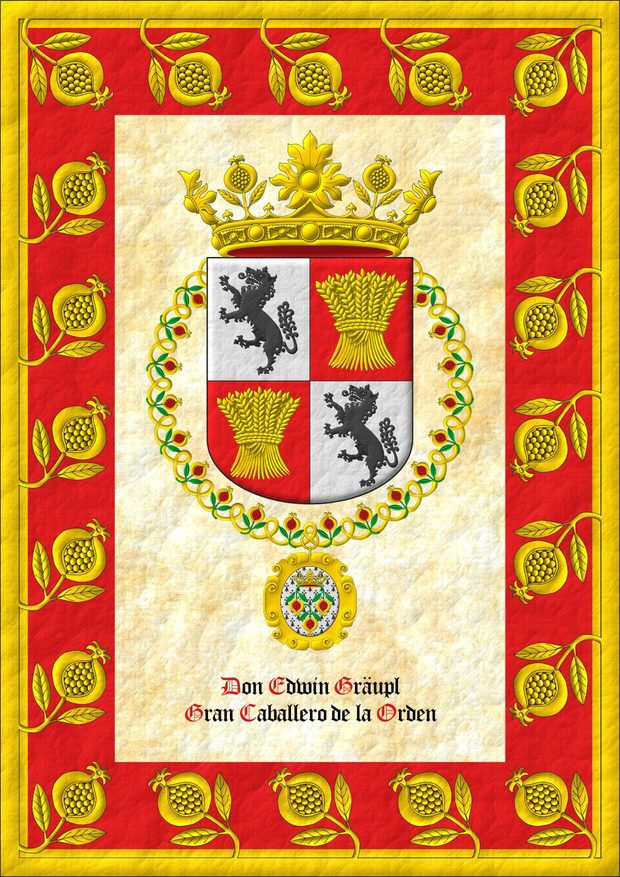
Quarterly: 1 and 4 Argent, a wolf rampant Sable; 2 and 3 Gules, a garb Or. Crest: A crown of the Sovereign and Most Noble Order of the Pomegranate. The shield is surrounded by the Grand Collar of the Sovereign and Most Noble Order of the Pomegranate.
This is his coat of arms of emblazoned by me for the Roll of Arms of the Sovereign and Most Noble Order of the Pomegranate.
Blazon keywords: Quarterly, Argent, One, Wolf, Rampant, Sable, Gules, Garb, Or, Crest and mantling, Crown, Pomegranate, Surrounded and Grand collar.
Style keywords: Rounded, Outlined in sable, Illuminated and Leather.
Classification: Personal, Interpreted, Coat of arms, Armorial roll and Castilian language.
Bearer: Gräupl, Edwin.


![Ver [Emblemata; 1995] en referencias bibliográficas. Libro abierto, hojas de plata, filo de oro, guardas de gules, tapas de sable.](../css/Libro.Bibliografia.png)
Emblemata; 1995
Baron of Valdeolivos Emblematic Chair, of the Fernando el Catolico Institution, of the Centre of Scientific Research (C. S. I. C.) and of the Government of Zaragoza, «Emblemata», Volume 1st, Emblemata Aragonese Magazine about Emblems (E. R. A. E.), 419 pages, 44 pictures, ISSN 1137-1056, Legal deposit Z.3.937 1996, printed by the Cooperativa de Artes Gráficas Librería General, Zaragoza, 1995.
Bibliographical reference of century XX.
Classification: Magazine and Castilian language.
Author: Cátedra de Emblemática Barón de Valdeolivos.
External link:


![Ver [Emblemata; 1996] en referencias bibliográficas. Libro abierto, hojas de plata, filo de oro, guardas de gules, tapas de sable.](../css/Libro.Bibliografia.png)
Emblemata; 1996
Baron of Valdeolivos Emblematic Chair, of the Fernando el Catolico Institution, of the Centre of Scientific Research (C. S. I. C.) and of the Government of Zaragoza, «Emblemata», Volume 2nd, Emblemata Aragonese Magazine about Emblems (E. R. A. E.), 396 pages, 89 pictures, ISSN 1137-1056, Legal deposit Z.3.937 1996, printed by the Cooperativa de Artes Gráficas Librería General, Zaragoza, 1996.
Bibliographical reference of century XX.
Classification: Magazine and Castilian language.
Author: Cátedra de Emblemática Barón de Valdeolivos.
External resource:


![Ver [Emblemata; 1997] en referencias bibliográficas. Libro abierto, hojas de plata, filo de oro, guardas de gules, tapas de sable.](../css/Libro.Bibliografia.png)
Emblemata; 1997
Baron of Valdeolivos Emblematic Chair, of the Fernando el Catolico Institution, of the Centre of Scientific Research (C. S. I. C.) and of the Government of Zaragoza, «Emblemata», Volume 3rd, Emblemata Aragonese Magazine about Emblems (E. R. A. E.), 480 pages, 116 pictures, 2 maps, ISSN 1137-1056, Legal deposit Z.3.937 1996, printed by the Cooperativa de Artes Gráficas Librería General, Zaragoza, 1997.
Bibliographical reference of century XX.
Classification: Magazine and Castilian language.
The author is Cátedra de Emblemática Barón de Valdeolivos.
External link:


![Ver [Emblemata; 1998] en referencias bibliográficas. Libro abierto, hojas de plata, filo de oro, guardas de gules, tapas de sable.](../css/Libro.Bibliografia.png)
Emblemata; 1998
Baron of Valdeolivos Emblematic Chair, of the Fernando el Catolico Institution, of the Centre of Scientific Research (C. S. I. C.) and of the Government of Zaragoza, «Emblemata», Volume 4th, Emblemata Aragonese Magazine about Emblems (E. R. A. E.), 450 pages, 135 pictures, ISSN 1137-1056, Legal deposit Z.3.937 1996, printed by the Cooperativa de Artes Gráficas Librería General, Zaragoza, 1998.
Bibliographical reference of century XX.
Classification: Magazine and Castilian language.
Author: Cátedra de Emblemática Barón de Valdeolivos.
External link:


![Ver [Emblemata; 1999] en referencias bibliográficas. Libro abierto, hojas de plata, filo de oro, guardas de gules, tapas de sable.](../css/Libro.Bibliografia.png)
Emblemata; 1999
Baron of Valdeolivos Emblematic Chair, of the Fernando el Catolico Institution, of the Centre of Scientific Research (C. S. I. C.) and of the Government of Zaragoza, «Emblemata», Volume 5th, Emblemata Aragonese Magazine about Emblems (E. R. A. E.), 484 pages, 124 pictures, ISSN 1137-1056, Legal deposit Z.3.937 1996, printed by the Cooperativa de Artes Gráficas Librería General, Zaragoza, 1999.
Bibliographical reference of century XX.
Classification: Magazine and Castilian language.
Author: Cátedra de Emblemática Barón de Valdeolivos.
External link:


![Ver [Emblemata; 2000] en referencias bibliográficas. Libro abierto, hojas de plata, filo de oro, guardas de gules, tapas de sable.](../css/Libro.Bibliografia.png)
Emblemata; 2000
Baron of Valdeolivos Emblematic Chair, of the Fernando el Catolico Institution, of the Centre of Scientific Research (C. S. I. C.) and of the Government of Zaragoza, «Emblemata», Volume 6th, Emblemata Aragonese Magazine about Emblems (E. R. A. E.), 419 pages, 124 pictures, ISSN 1137-1056, Legal deposit Z.3.937 1996, printed by the Cooperativa de Artes Gráficas Librería General, Zaragoza, 2000.
Bibliographical reference of century XX.
Classification: Magazine and Castilian language.
Author: Cátedra de Emblemática Barón de Valdeolivos.
External links:
Internal resources: Emblemata2000.Volumen06.pdf.


![Ver [Emblemata; 2001] en referencias bibliográficas. Libro abierto, hojas de plata, filo de oro, guardas de gules, tapas de sable.](../css/Libro.Bibliografia.png)
Emblemata; 2001
Baron of Valdeolivos Emblematic Chair, of the Fernando el Catolico Institution, of the Centre of Scientific Research (C. S. I. C.) and of the Government of Zaragoza, «Emblemata», Volume 7th, Emblemata Aragonese Magazine about Emblems (E. R. A. E.), 496 pages, 199 pictures, ISSN 1137-1056, Legal deposit Z.3.937 1996, printed by the Cooperativa de Artes Gráficas Librería General, Zaragoza, 2001.
Bibliographical reference of century XXI.
Classification: Magazine and Castilian language.
Author: Cátedra de Emblemática Barón de Valdeolivos.
External resources:
Internal resources: Emblemata2001.Volumen07.pdf.


![Ver [Emblemata; 2002] en referencias bibliográficas. Libro abierto, hojas de plata, filo de oro, guardas de gules, tapas de sable.](../css/Libro.Bibliografia.png)
Emblemata; 2002
Baron of Valdeolivos Emblematic Chair, of the Fernando el Catolico Institution, of the Centre of Scientific Research (C. S. I. C.) and of the Government of Zaragoza, «Emblemata», Volume 8th, Emblemata Aragonese Magazine about Emblems (E. R. A. E.), 454 pages, 58 pictures, ISSN 1137-1056, Legal deposit Z.3.937 1996, printed by the Cooperativa de Artes Gráficas Librería General, Zaragoza, 2002.
Bibliographical reference of century XXI.
Classification: Magazine and Castilian language.
Author: Cátedra de Emblemática Barón de Valdeolivos.
External links:
Internal resources: Emblemata2002.Volumen08.pdf.


![Ver [Emblemata; 2003] en referencias bibliográficas. Libro abierto, hojas de plata, filo de oro, guardas de gules, tapas de sable.](../css/Libro.Bibliografia.png)
Emblemata; 2003
Baron of Valdeolivos Emblematic Chair, of the Fernando el Catolico Institution, of the Centre of Scientific Research (C. S. I. C.) and of the Government of Zaragoza, «Emblemata», Volume 9th, Emblemata Aragonese Magazine about Emblems (E. R. A. E.), 483 pages, ISSN 1137-1056, Legal deposit Z.3.937 1996, printed by the Cooperativa de Artes Gráficas Librería General, Zaragoza, 2003.
Bibliographical reference of century XXI.
Classification: Magazine and Castilian language.
Author: Cátedra de Emblemática Barón de Valdeolivos.
External resources:
Internal resources: Emblemata2003.Volumen09.pdf.


![Ver [Emblemata; 2004] en referencias bibliográficas. Libro abierto, hojas de plata, filo de oro, guardas de gules, tapas de sable.](../css/Libro.Bibliografia.png)
Emblemata; 2004
Baron of Valdeolivos Emblematic Chair, of the Fernando el Catolico Institution, of the Centre of Scientific Research (C. S. I. C.) and of the Government of Zaragoza, «Emblemata», Volume 10th, Emblemata Aragonese Magazine about Emblems (E. R. A. E.), 563 pages, ISSN 1137-1056, Legal deposit Z.3.937 1996, printed by the Cooperativa de Artes Gráficas Librería General, Zaragoza, 2004.
Bibliographical reference of century XXI.
Classification: Magazine and Castilian language.
The author is Cátedra de Emblemática Barón de Valdeolivos.
External links:
Internal resources: Emblemata2004.Volumen10.pdf.


![Ver [Emblemata; 2005] en referencias bibliográficas. Libro abierto, hojas de plata, filo de oro, guardas de gules, tapas de sable.](../css/Libro.Bibliografia.png)
Emblemata; 2005
Baron of Valdeolivos Emblematic Chair, of the Fernando el Catolico Institution, of the Centre of Scientific Research (C. S. I. C.) and of the Government of Zaragoza, «Emblemata», Volume 11th, Emblemata Aragonese Magazine about Emblems (E. R. A. E.), 463 pages, ISSN 1137-1056, Legal deposit Z.3.937 1996, printed by the Cooperativa de Artes Gráficas Librería General, Zaragoza, 2005.
Bibliographical reference of century XXI.
Classification: Magazine and Castilian language.
Author: Cátedra de Emblemática Barón de Valdeolivos.
External resources:
- Abstract in the Fernando el Catolico Institution.
- Index in the Fernando el Catolico Institution.
- Magazine in the Fernando el Catolico Institution.
Internal resources: Emblemata2005.Volumen11.pdf.


![Ver [Emblemata; 2006] en referencias bibliográficas. Libro abierto, hojas de plata, filo de oro, guardas de gules, tapas de sable.](../css/Libro.Bibliografia.png)
Emblemata; 2006
Baron of Valdeolivos Emblematic Chair, of the Fernando el Catolico Institution, of the Centre of Scientific Research (C. S. I. C.) and of the Government of Zaragoza, «Emblemata», Volume 12th, Emblemata Aragonese Magazine about Emblems (E. R. A. E.), 415 pages, ISSN 1137-1056, Legal deposit Z.3.937 1996, printed by the Cooperativa de Artes Gráficas Librería General, Zaragoza, 2006.
Bibliographical reference of century XXI.
Classification: Magazine and Castilian language.
The author is Cátedra de Emblemática Barón de Valdeolivos.
External resources:
- Abstract in the Fernando el Catolico Institution.
- Index in the Fernando el Catolico Institution.
- Magazine in the Fernando el Catolico Institution.
Internal resources: Emblemata2006.Volumen12.pdf.


![Ver [Emblemata; 2007] en referencias bibliográficas. Libro abierto, hojas de plata, filo de oro, guardas de gules, tapas de sable.](../css/Libro.Bibliografia.png)
Emblemata; 2007
Baron of Valdeolivos Emblematic Chair, of the Fernando el Catolico Institution, of the Centre of Scientific Research (C. S. I. C.) and of the Government of Zaragoza, «Emblemata», Volume 13th, Emblemata Aragonese Magazine about Emblems (E. R. A. E.), 535 pages, ISSN 1137-1056, Legal deposit Z.3.937 1996, printed by the Cooperativa de Artes Gráficas Librería General, Zaragoza, 2007.
Bibliographical reference of century XXI.
Classification: Magazine and Castilian language.
Author: Cátedra de Emblemática Barón de Valdeolivos.
External resources:
Internal resources: Emblemata2007.Volumen13.pdf.


![Ver [Emblemata; 2008] en referencias bibliográficas. Libro abierto, hojas de plata, filo de oro, guardas de gules, tapas de sable.](../css/Libro.Bibliografia.png)
Emblemata; 2008
Baron of Valdeolivos Emblematic Chair, of the Fernando el Catolico Institution, of the Centre of Scientific Research (C. S. I. C.) and of the Government of Zaragoza, «Emblemata», Volume 14th, Emblemata Aragonese Magazine about Emblems (E. R. A. E.), 579 pages, ISSN 1137-1056, Legal deposit Z.3.937 1996, printed by the Cooperativa de Artes Gráficas Librería General, Zaragoza, 2008.
Bibliographical reference of century XXI.
Classification: Magazine and Castilian language.
Author: Cátedra de Emblemática Barón de Valdeolivos.
External links:
- Abstract in the Fernando el Catolico Institution.
- Index in the Fernando el Catolico Institution.
- Magazine in the Fernando el Catolico Institution.
Internal resources: Emblemata2008.Volumen14.pdf.


![Ver [Emblemata; 2009] en referencias bibliográficas. Libro abierto, hojas de plata, filo de oro, guardas de gules, tapas de sable.](../css/Libro.Bibliografia.png)
Emblemata; 2009
Baron of Valdeolivos Emblematic Chair, of the Fernando el Catolico Institution, of the Centre of Scientific Research (C. S. I. C.) and of the Government of Zaragoza, «Emblemata», Volume 15th, Emblemata Aragonese Magazine about Emblems (E. R. A. E.), 579 pages, ISSN 1137-1056, Legal deposit Z.3.937 1996, printed by the Cooperativa de Artes Gráficas Librería General, Zaragoza, 2009.
Bibliographical reference of century XXI.
Classification: Magazine and Castilian language.
The author is Cátedra de Emblemática Barón de Valdeolivos.
External links:
- Abstract in the Fernando el Catolico Institution.
- Index in the Fernando el Catolico Institution.
- Magazine in the Fernando el Catolico Institution.
Internal resources: Emblemata2009.Volumen15.pdf.


![Ver [Emblemata; 2010] en referencias bibliográficas. Libro abierto, hojas de plata, filo de oro, guardas de gules, tapas de sable.](../css/Libro.Bibliografia.png)
Emblemata; 2010
Baron of Valdeolivos Emblematic Chair, of the Fernando el Catolico Institution, of the Centre of Scientific Research (C. S. I. C.) and of the Government of Zaragoza, «Emblemata», Volume 16th, Emblemata Aragonese Magazine about Emblems (E. R. A. E.), 507 pages, ISSN 1137-1056, Legal deposit Z.3.937 1996, printed by the Cooperativa de Artes Gráficas Librería General, Zaragoza, 2010.
Bibliographical reference of century XXI.
Classification: Magazine and Castilian language.
The author is Cátedra de Emblemática Barón de Valdeolivos.
The following article cites this bibliographic reference:
External links:
- Abstract in the Fernando el Catolico Institution.
- Index in the Fernando el Catolico Institution.
- Magazine in the Fernando el Catolico Institution.
Internal resources: Emblemata2010.Volumen16.pdf.


![Ver [Emblemata; 2011] en referencias bibliográficas. Libro abierto, hojas de plata, filo de oro, guardas de gules, tapas de sable.](../css/Libro.Bibliografia.png)
Emblemata; 2011
Baron of Valdeolivos Emblematic Chair, of the Fernando el Catolico Institution, of the Centre of Scientific Research (C. S. I. C.) and of the Government of Zaragoza, «Emblemata», Volume 17th, Emblemata Aragonese Magazine about Emblems (E. R. A. E.), 469 pages, ISSN 1137-1056, Legal deposit Z.3.937 1996, printed by the Cooperativa de Artes Gráficas Librería General, Zaragoza, 2011.
Bibliographical reference of century XXI.
Classification: Magazine and Castilian language.
Author: Cátedra de Emblemática Barón de Valdeolivos.
External resources:
Internal resources: Emblemata2011.Volumen17.pdf.


![Ver [Emblemata; 2012] en referencias bibliográficas. Libro abierto, hojas de plata, filo de oro, guardas de gules, tapas de sable.](../css/Libro.Bibliografia.png)
Emblemata; 2012
Baron of Valdeolivos Emblematic Chair, of the Fernando el Catolico Institution, of the Centre of Scientific Research (C. S. I. C.) and of the Government of Zaragoza, «Emblemata», Volume 18th, Emblemata Aragonese Magazine about Emblems (E. R. A. E.), 517 pages, ISSN 1137-1056, Legal deposit Z.3.937 1996, printed by the Cooperativa de Artes Gráficas Librería General, Zaragoza, 2012.
Bibliographical reference of century XXI.
Classification: Magazine and Castilian language.
Author: Cátedra de Emblemática Barón de Valdeolivos.
The following article cites this bibliographic reference:
External links:
- Abstract in the Fernando el Catolico Institution.
- Index in the Fernando el Catolico Institution.
- Magazine in the Fernando el Catolico Institution.
Internal resources: Emblemata2012.Volumen18.pdf.


![Ver [Emblemata; 2013] en referencias bibliográficas. Libro abierto, hojas de plata, filo de oro, guardas de gules, tapas de sable.](../css/Libro.Bibliografia.png)
Emblemata; 2013
Baron of Valdeolivos Emblematic Chair, of the Fernando el Catolico Institution, of the Centre of Scientific Research (C. S. I. C.) and of the Government of Zaragoza, «Emblemata», Volume 19th, Emblemata Aragonese Magazine about Emblems (E. R. A. E.), 558 pages, ISSN 1137-1056, Legal deposit Z.3.937 1996, printed by Talleres Editoriales Cometa SA, Zaragoza, 2013.
Bibliographical reference of century XXI.
Classification: Magazine and Castilian language.
The author is Cátedra de Emblemática Barón de Valdeolivos.
External links:
- Abstract in the Fernando el Catolico Institution.
- Index in the Fernando el Catolico Institution.
- Magazine in the Fernando el Catolico Institution.
Internal resources: Emblemata2013.Volumen19.pdf.


![Ver [Emblemata; 2015] en referencias bibliográficas. Libro abierto, hojas de plata, filo de oro, guardas de gules, tapas de sable.](../css/Libro.Bibliografia.png)
Emblemata; 2015
Baron of Valdeolivos Emblematic Chair, of the Fernando el Catolico Institution, of the Centre of Scientific Research (C. S. I. C.) and of the Government of Zaragoza, «Emblemata», Volumes 20th and 21st, Emblemata Aragonese Magazine about Emblems (E. R. A. E.), 700 pages, ISSN 1137-1056, Legal deposit Z.3.937 1996, printed by Huella Digital SL, Zaragoza, 2015.
Bibliographical reference of century XXI.
Classification: Magazine and Castilian language.
The author is Cátedra de Emblemática Barón de Valdeolivos.
The following article cites this bibliographic reference:
External resources:
- Abstract in the Fernando el Catolico Institution.
- Index in the Fernando el Catolico Institution.
- Magazine in the Fernando el Catolico Institution.
Internal resources: Emblemata2015.Volumen20-21.2014-2015.pdf.


![Ver [Emblemata; 2016] en referencias bibliográficas. Libro abierto, hojas de plata, filo de oro, guardas de gules, tapas de sable.](../css/Libro.Bibliografia.png)
Emblemata; 2016
Baron of Valdeolivos Emblematic Chair, of the Fernando el Catolico Institution, of the Centre of Scientific Research (C. S. I. C.) and of the Government of Zaragoza, «Emblemata», Volume 22nd, Emblemata Aragonese Magazine about Emblems (E. R. A. E.), 346 pages, ISSN 1137-1056, Legal deposit Z.3.937 1996, printed by Huella Digital SL, Zaragoza, 2016.
Bibliographical reference of century XXI.
Classification: Magazine and Castilian language.
Author: Cátedra de Emblemática Barón de Valdeolivos.
External resources:
- Abstract in the Fernando el Catolico Institution.
- Index in the Fernando el Catolico Institution.
- Magazine in the Fernando el Catolico Institution.
Internal resources: Emblemata2016.Volumen22.pdf.


![Ver [Emblemata; 2017] en referencias bibliográficas. Libro abierto, hojas de plata, filo de oro, guardas de gules, tapas de sable.](../css/Libro.Bibliografia.png)
Emblemata; 2017
Baron of Valdeolivos Emblematic Chair, of the Fernando el Catolico Institution, of the Centre of Scientific Research (C. S. I. C.) and of the Government of Zaragoza, «Emblemata», Volume 23rd, Emblemata Aragonese Magazine about Emblems (E. R. A. E.), 312 pages, ISSN 1137-1056, Legal deposit Z.3.937 1996, printed by Copy Center Digital, Zaragoza, 2017.
Bibliographical reference of century XXI.
Classification: Magazine and Castilian language.
The author is Cátedra de Emblemática Barón de Valdeolivos.
External resources:
- Abstract in the Fernando el Catolico Institution.
- Index in the Fernando el Catolico Institution.
- Magazine in the Fernando el Catolico Institution.
Internal resources: Emblemata2017.Volumen23.pdf.


![Ver [Emblemata; 2018] en referencias bibliográficas. Libro abierto, hojas de plata, filo de oro, guardas de gules, tapas de sable.](../css/Libro.Bibliografia.png)
Emblemata; 2018
Baron of Valdeolivos Emblematic Chair, of the Fernando el Catolico Institution, of the Centre of Scientific Research (C. S. I. C.) and of the Government of Zaragoza, «Emblemata», Volume 24th, Emblemata Aragonese Magazine about Emblems (E. R. A. E.), 262 pages, ISSN 1137-1056, Legal deposit Z.3.937 1996, printed by Copy Center Digital, Zaragoza, 2018.
Bibliographical reference of century XXI.
Classification: Magazine and Castilian language.
The author is Cátedra de Emblemática Barón de Valdeolivos.
External resources:
- Abstract in the Fernando el Catolico Institution.
- Index in the Fernando el Catolico Institution.
- Magazine in the Fernando el Catolico Institution.
Internal resources: Emblemata2018.Volumen24.pdf.


![Ver [Emblemata; 2019] en referencias bibliográficas. Libro abierto, hojas de plata, filo de oro, guardas de gules, tapas de sable.](../css/Libro.Bibliografia.png)
Emblemata; 2019
Baron of Valdeolivos Emblematic Chair, of the Fernando el Catolico Institution, of the Centre of Scientific Research (C. S. I. C.) and of the Government of Zaragoza, «Emblemata», Volume 25th, Emblemata Aragonese Magazine about Emblems (E. R. A. E.), 486 pages, ISSN 1137-1056, Legal deposit Z.3.937 1996, printed by Copy Center Digital, Zaragoza, 2019
Bibliographical reference of century XXI.
Classification: Magazine and Castilian language.
The author is Cátedra de Emblemática Barón de Valdeolivos.
Bibliographical reference mentioned in the following article:
External links:
- Abstract in the Fernando el Catolico Institution.
- Index in the Fernando el Catolico Institution.
- Magazine in the Fernando el Catolico Institution.
Internal resources: Emblemata2019.Volumen25.pdf.


![Ver [Fernández de Enciso, M.; 1519] en referencias bibliográficas. Libro abierto, hojas de plata, filo de oro, guardas de gules, tapas de sable.](../css/Libro.Bibliografia.png)
Fernández de Enciso, M.; 1519
Martin Fernandez de Enciso, «Sum of Geography, which deals with all the parts and provinces of the world: especially the Indies. And deals extensively with the art of navigation, together with the sphere in the vernacular, with the regulation of the Sun and the North: newly made. With royal privilege.», 148 pages, House of Trade (Casa de la Contratación), Seville, 1519.
Preliminary note
Note that I try to use, even in these non-heraldic cases, the language of blazon, thus I speak of positions such as in chief, in base, dexter or sinister, arrangements such as in bend and in bend sinister and tinctures such as sable, azure or gules.
Zodiacal bands in armillary spheres: A comparative analysis of Marchant (1499) and Fernández de Enciso (1519) engravings
[Marchant, G.; 1499; page 15] and [Fernández de Enciso, M.; 1519; page 1] depict an armillary sphere with the zodiac signs, &Aries; Aries, &Taurus; Taurus, &Gemini; Gemini, &Cancer; Cancer, &Leo; Leo, &Virgo; Virgo, &Libra; Libra, &Scorpio; Scorpio, &Sagittarius; Sagittarius, &Capricorn; Capricorn, &Aquarius; Aquarius and &Pisces; Pisces, represented on a band around the sphere. I have compared both zodiacal bands by means of the composition of the previous image.
In this image I have made there are:
- In the 3rd row, the band of zodiac signs of the armillary sphere by [Marchant, G.; 1499].
- Above, in the 2nd row, the band of my interpretation of the same previous engraving.
- In chief, at the very top, in the 1st row, the zodiac signs in sable and azure, with those not visible, in the order of [Marchant, G.; 1499], that is, as read by the reader of the book, from his frontal perspective of the engraving, in counterclockwise direction, &Gemini;, &Taurus;, &Aries;, &Pisces;, &Aquarius;, &Capricorn;, &Sagittarius;, &Scorpio;, &Libra;, &Virgo;, &Leo; and &Cancer; which is not visible. Note that, for example, Taurus appears before Aries so the sequence is geocentric, that is, arranged from the point of view of an observer located at the center of the Earth, which is different from the book reader.
- Below, in the 4th row, the band of zodiac signs of the armillary sphere by [Fernández de Enciso, M.; 1519].
- In base, at the very bottom, in the 5th row, the zodiac signs in black and in cyan, with those not visible, in the order of [Fernández de Enciso, M.; 1519], that is, as read by the same reader of the book in counterclockwise direction, &Capricorn;, &Aquarius;, &Pisces;, &Aries;, &Taurus;, &Gemini;, &Cancer; which is not visible, &Leo;, &Virgo;, &Libra;, &Scorpio;, and &Sagittarius; which is also not visible. Note that in this case, for example, Aries appears before Taurus so the sequence is ecliptic, that is, from the point of view of an observer located in outer space, the point of view of the ecliptic sequence coinciding with the point of view of the book reader.
The 3 main differences observed are:
- [Marchant, G.; 1499], number 6 in the image, places at the top the zodiac signs that [Fernández de Enciso, M.; 1519], number 7 in the image, places at the bottom, as a curiosity it can be seen in my interpretation of [Marchant, G.; 1499] that for aesthetic reasons I placed at top and bottom the zodiac signs as [Fernández de Enciso, M.; 1519] does.
- They do not start in the same position, it is &Aries; Aries that has a more similar position in both but with one slot of difference.
- The signs in [Marchant, G.; 1499] and [Fernández de Enciso, M.; 1519] rotate in opposite directions.
The only important conceptual difference is the reverse rotation of the zodiac signs, that is, that [Marchant, G.; 1499] uses the geocentric sequence and [Fernández de Enciso, M.; 1519] uses the ecliptic sequence. In no case is it a printing error of an engraving in mirror, since neither of the two armillary spheres is engraved in mirror, as both have the zodiacal band in bend, and if they were engraved in mirror the zodiacal band would appear placed in bend sinister.
We could also study the few non-symmetrical signs that can be distinguished completely:
- For example, on the back side of the band of [Marchant, G.; 1499], &Scorpio; Scorpio has the scorpion’s stinger in the shape of an m pointing to sinister (the reader’s right), so it makes sense from the point of view of a geocentric observer.
- For example, on the back side of the band of [Fernández de Enciso, M.; 1519], &Leo; Leo seems to have the circle of its head to dexter (the reader’s left) and the curl of its tail to sinister (the left of a geocentric observer), while in &Scorpio; Scorpio, the stinger of the m-scorpion seems to point to dexter (the reader’s left) as if the sign were intended to be seen from the other side of the outside, piercing the band, so that the book reader sees the sign in mirror. Be that as it may, the arrangement of these 2 signs does not seem consistent with each other.
Although it is not a case of printing the engraving in mirror, such errors exist since, if we go beyond the armillary sphere of [Fernández de Enciso, M.; 1519] to study its outer decoration, we see that the SPQR, of «Senatus Populusque Romanus», is in mirror, I have marked it with a square of gules with the number 8 in the image, so that, although its armillary sphere is well printed, in the outer decoration the printer made a mistake and printed it the other way round.
Bibliographical reference of century XVI.
Classification: In black and white and Castilian language.
The author is Fernández de Enciso, Martín.
Bibliographic reference mentioned in the following articles:
External resources:
Internal resources: FernandezDeEncisoM1519.SumaDeGeographia.CatedraNaval.pdf in scanned PDF format at the Naval Chair, Spanish Navy, University of Murcia..


![Ver [Fernández-Xesta y Vázquez, E.; 2014a] en referencias bibliográficas. Libro abierto, hojas de plata, filo de oro, guardas de gules, tapas de sable.](../css/Libro.Bibliografia.png)
Fernández-Xesta y Vázquez, E.; 2014a
Ernesto Fernández-Xesta y Vázquez, «Emblemática en Aragón. La colección de piezas emblemáticas del archivo biblioteca del Barón de Valdeolivos», edited by the Royal Academy of Heraldry and Genealogy of Madrid in collaboration with El Justicia de Aragón and the Spanish Confederation of Local Studies Centers (CECEL-CSIC), 899 pages, with color and black-and-white illustrations, ISBN 978-84-88833-08-2, ISBN number immediately preceding its digital edition, Legal Deposit M. 192-2014, deposit number immediately preceding its digital edition, Madrid, 2014.
Also published in digital PDF format on CD-ROM as [Fernández-Xesta y Vázquez, E.; 2014b] with a print run of 1000 copies.
Bibliographical reference of century XXI.
Classification: Castilian language.
Author: Fernández-Xesta y Vázquez, Ernesto.
The following article cites this bibliographic reference:
External resource:


Francisco Jose Bermejo Fernandez-Briceño, page of armorial
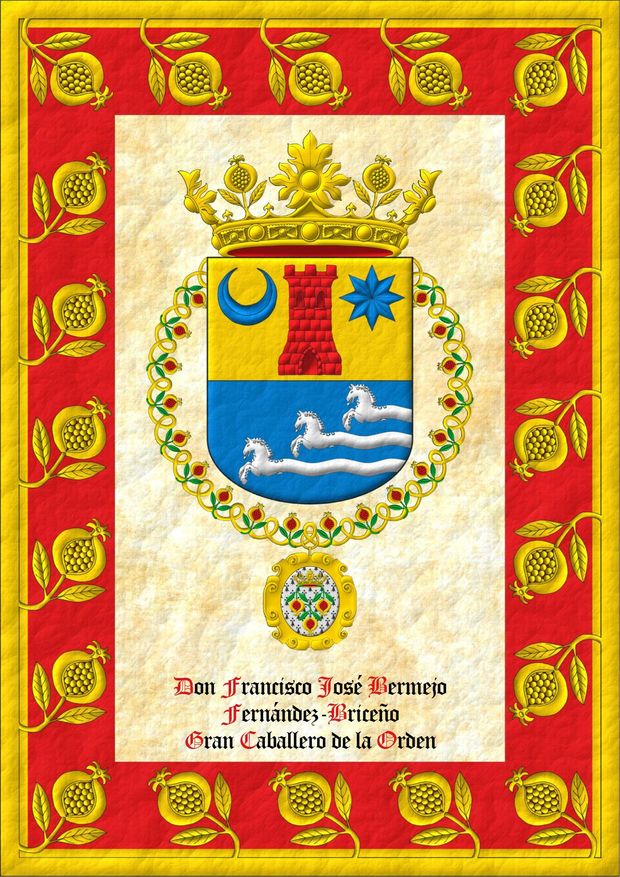
Party per fess: 1 Or, a tower Gules between in chief a crescent and a mullet of eight points Azure; 2 Azure, three demi-horses courant in bend sinister nascent from the ends of three bars wavy issuant from sinister Argent. Crest: A crown of the Soberana y Muy Noble Orden de la Granada. The shield is surrounded by the collar of the Sovereign and Most Noble Order of the Pomegranate.
It has been interpreted by me, highlighted with lights and shadows, contoured in Sable, with a rounded external shape and with a texturized finishing.
This is the coat of arms of Francisco-José Bermejo Fernández-Briceño designed by Ignacio Koblischek and emblazoned by me for the Roll of Arms of the Soberana y Muy Noble Orden de la Granada.
Blazon keywords: Or, Azure, Gules, Argent, One, Three, Party per fess, Tower, Between, In chief, Crescent, Mullet, Demi, Horse, Courant, In bend sinister, Nascent, Bar, Wavy, Issuant, Sinister, Crown of the Sovereign and Most Noble Order of the Pomegranate, Crown, Surrounded and Collar.
Style keywords: Outlined in sable, Illuminated and Rounded.
Classification: Personal, Interpreted, Boa, Armorial roll and Castilian language.
Bearer: Bermejo Fernandez-Briceño, Francisco Jose.


![Ver [Galdiano L.; Century XVII] en referencias bibliográficas. Libro abierto, hojas de plata, filo de oro, guardas de gules, tapas de sable.](../css/Libro.Bibliografia.png)
Galdiano L.; Century XVII
Anonymous, «Arms and Lineages of Spain», Lázaro Galdiano Foundation, call number 405, manuscript, illustrated, 330 pages, 29 x 22 centimeters, century XVII.
Content and notes
This manuscript contains heraldic descriptions and illustrations of coats of arms, with a coat of arms at the end of each lineage. The coats of arms are painted at the end, and the title of the next lineage is written so close, sometimes physically attached, that one might believe that the title under the coat of arms belongs to the lineage of the coat of arms, when it is actually the coat of arms of the previous lineage. The initial index occupies 20 pages, then the folios are numbered r, recto, up to 194, folio 195 is numbered, its title is «of the Medranos» and it contains an unusual coat of arms, by another hand and without tinctures, folio 196 is numbered and blank, and the final 14 folios are written in another style, and they are a small compendium of heraldic concepts. I understand that the Medrano family might have owned this manuscript for a time and added their lineage at the end of this armorial.
Physical condition and binding
Some leaves have been restored and reinforced at the margins, and the manuscript is in good condition. There is an annotation in manuscript on the verso of the first guard leaf: «8, 1500, F».
A dry stamp is present on the second guard leaf: «Obrador De Encuadernaciones De Antonio Menard. 15 Cervantes 15 Madrid». The manuscript is bound in vellum with a gilded top edge.
Manuscript index
- Alphabetical table of lineages.
-
Armorial of kings:
- Of the arms of Prester John.
- Follow the arms and blazon of Jerusalem.
- Of the branches of the Kingdom of Cyprus and its King.
- Arms of the German Empire.
- Of the King of Hungary.
- The arms of Frisia and why it lost the name of Kingdom.
- Bohemia.
- Arms of the King of Poland and León.
- Of the kingdom of Sweden and Gothia.
- Of the kingdom of Norway.
- Of the King of Gelandia.
- Of the King of Scotland.
- Arms of England.
- Of the King of Hibernia.
- Arms of Rome.
- Arms of the King of Naples.
- Of the Duke of Milan.
- Of the King of Sicily.
- Of the King of France.
- Those who populated Spain are written.
- Of the Kings of Navarra.
- Of the King of Aragón.
- Of the King of Portugal.
- How the kings of Castilla began.
-
Armorial of lineages:
- Of the Manuels.
- Of the De la Cerda.
- Of the Enríquez.
- Of the Duke of Va Hermosa Don Alonso de Aragón.
- Of the Castillas.
- Of the Guzmanes.
- Of the Flores.
- Of the Ponces de León.
- Of the Carrillos.
- Of the Manriques.
- Of the De Albornoz.
- Of the Riveras.
- Of the Portugals.
- Of the Haros.
- Of the Lara lineage.
- Of the Guevaras.
- Of the Mendozas.
- From where the Hurtados come.
- Of the foundation and surname of Ayala.
- Of the Velascos.
- Of the De Castros.
- Of the Herreras.
- Of the De la Vegas.
- Of the De Tovars.
- Of the Sarmientos.
- Of the Estunigas.
- Of the Añayas.
- Of the Cerezos.
- Of the Heredias.
- Of the Aguilars.
- Of the Pachecos.
- Of the Osorios lineage.
- Another difference of arms.
- Pimentels.
- Of the Avellanedas.
- Of the Bracamontes.
- Of the Cueva.
- Of the Toledos.
- Another difference of arms of Toledo from the Garcías.
- Of the Barrosos.
- Of the Silvas.
- Of the Palomeques.
- Of the Gaitanes.
- Of the Gudiels.
- Of the Sandovals.
- Of the Niños.
- Of the Cervatos.
- Of the Fonsecas.
- Of the Coroneles.
- Of the Avalos.
- Of the Lunas.
- Of the Torquemadas.
- Of the Carvajales.
- Of the Rivadeneiras.
- Of the Padillas.
- Of the Valderrábanos.
- Of the Aguayos.
- Of the Zapatas.
- Of the Mirandas.
- Of the De Acuñas.
- Of the Arellanos.
- Of the Castañedas.
- Of the Quiñones.
- Of the Cornados.
- Of the Cervantes.
- Of the Loaysas.
- Of the Cisneros.
- Of the Dazas.
- Of the Córdobas.
- Of the Matas.
- Of the Aceves.
- Of the Cuellos.
- Of the Villarrueles.
- Of the De Biveros.
- Of the De Rojas.
- Of the De Orozcos.
- Those called from Bizcaya.
- Of the Sorvas.
- Of the Maldonados.
- Of the Fajardos.
- Of the Contreras.
- Of the Moscosos.
- Of the Mejías.
- Of the Sosas.
- Of the Figueroas.
- Of the Barahonas.
- Of the Montoyas.
- Of the Alarcóns.
- Of the La Torre.
- Of the Ludos.
- Of the Moyas.
- Of the Ángulos.
- Of the Calatayuds.
- Of the Gaonas.
- Of the Mendaños.
- Of the Beneros.
- Of the Londoños.
- Of the Quevedos.
- Of the Ulloas.
- Of the Quirogas.
- Of the Liras.
- Of the Meneses.
- Of the Girones.
- Of the constable Miguel Lucas.
- Of the Prados.
- Of the Salazars.
- Of the Solórzanos.
- Of the Cárdenas.
- Of the Biedmas.
- Of the Obregóns.
- Of the Bustos.
- Of the Almansas.
- Of the Puerto Carreros.
- Of the Sartes.
- Of the Carates.
- Of the Aljofríns.
- Of the Barrientos.
- Of the Reinosos.
- Of the Locanas.
- Of the Chacones.
- Of the Pantojas.
- Of the Carranzas.
- Of the Pereas.
- Of the Vanegas.
- Of the Lujanes.
- Of the Calderones.
- Of the La Cadena.
- Of the Delgadillos.
- Of the Clavijos.
- Of the Grajedas.
- Of the Ávila.
- Of the Lisones.
- Of the De Mesas.
- Of the Las Ruelas.
- Of the Rapados.
- Of the Villandrandos.
- Of the Luzones.
- Of the Torres.
- Of the De Soliez.
- Of the Herrezuelos.
- Of the Pavía.
- Of the Berrios.
- Of the Baruas.
- Of the Benavides.
- Two differences of arms.
- Of the Narváez.
- Of the Robles.
- Of the De Ñero.
- Of the Mojicas.
- Of the Bacanes.
- Of the Bastoncillos.
- Of the Bocanegras.
- Of the Castillos.
- Of the De Cañizares.
- Of the Cerezuela.
- Of the Dorantes.
- Of the De Estrada.
- Of the Escobares.
- Of the Salcedos.
- Of the De Inestrosa.
- Of the De Isla.
- Of the Illanes.
- Of the Jaravas.
- Of the Oñez.
- Of the Cuadrados.
- Of the Pardos.
- Of the Penalosas.
- Of the Porras.
- Of the Muñizes.
- Of the Ruecos.
- Of the Sotos.
- Of the Romos.
- Of the Salcedos.
- Of the Tenorios.
- Of the Valdeses.
- Of the Vallejos.
- Of the Villagómez.
- Of the Bargas.
- Of the Verdejos.
- Of the Marinos.
- Of the Morales.
-
Added lineage and coat of arms:
- Of the Medranos.
-
Compendium of heraldic concepts:
- First preamble.
- The rule of heraldry follows.
- Second preamble.
- Third preamble.
- Final fourth preamble.
- The meaning of gold.
- The meaning of silver.
- The meaning of blue.
- The meaning of gules, which is red.
- Sable, which is black.
- The meaning of vert, which is green.
- The meaning of purpure, which is purple.
Bibliographical reference of century XVII.
Classification: Manuscript, Armorial roll, Castilian language and In color.
The author is unknown.
Bibliographical reference mentioned in the following article:
Internal resources: GaldianoLXVII.ArmasLinajesEspaña.pdf PDF format.


![Ver [Gamonal; Century XVI] en referencias bibliográficas. Libro abierto, hojas de plata, filo de oro, guardas de gules, tapas de sable.](../css/Libro.Bibliografia.png)
Gamonal; Century XVI
Anonymous, «Libro en que se pintan los cavalleros cofrades de la Cofradía de Nuestra Señora de Gamonal», National Library of Spain, call number Mss/22258, manuscript, illustrated, 4+((28-3)*2+1)+2 = 57 pages, 27 folios, 30 x 23 centimeters, Burgos, 1575-1600.
Content and notes
This manuscript contains 46 full-page, mannerist-style portraits of equestrian knights, members of the Cofradía de Nuestra Señora de Gamonal, with their coats of arms, painted in color and illuminated with gold and silver, though some remain unfinished. Below some of the images, the name of the knight is inscribed. An annotation on the cover reads: «Jusepe de Aiala pintose en [B]urgos» indicating the possible artist. The manuscript has been foliated in ink at the lower right corner and in pencil at the upper right, modernized. Some notes in 19th-century handwriting are also present.
Bibliographical reference of century XVI.
Classification: Manuscript, Armorial roll, Castilian language and In color.
Author: unknown.
External resource:
Internal resources: GamonalXVI.Armorial.Ecuestre.pdf PDF format.


![Ver [Garaycoa Raffo, L.; 2011] en referencias bibliográficas. Libro abierto, hojas de plata, filo de oro, guardas de gules, tapas de sable.](../css/Libro.Bibliografia.png)
Garaycoa Raffo, L.; 2011
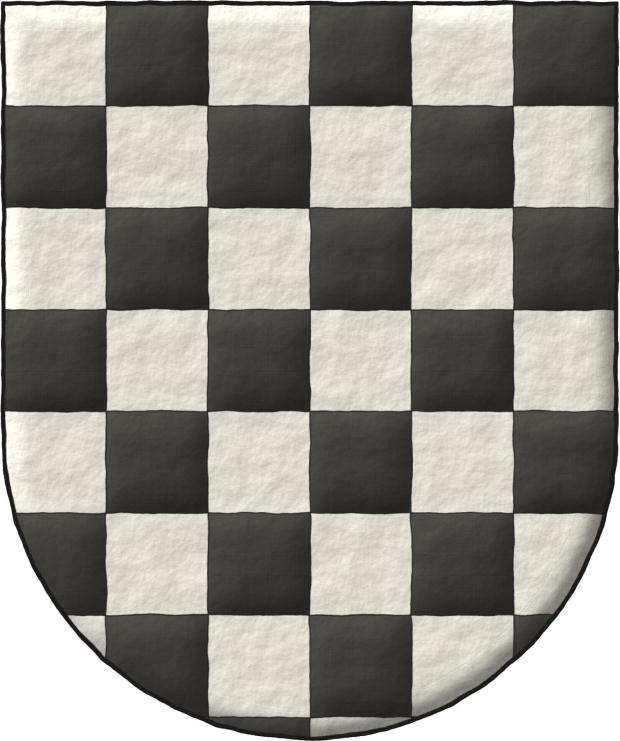
Lorenzo Garaycoa Raffo, Doctor, «Contribución Heraldica para el Estudio de la Sociedad Colonial de Guayaquil», pending to publish, graphic designer Lorenzo Garaycoa Taylor, with 320 surnames and 500 coat of arms, mainly of colonial coats of arms, main index on page 98, alphabetical index on page 99, 117 pages, Guayaquil, 11th of February of 2011.
Bibliographical reference of century XXI.
Classification: Castilian language and Black and white and color illustrations.
The author is Garaycoa Raffo, Lorenzo.
The following article cites this bibliographic reference:
Internal resources: GaraycoaRaffoL2011.pdf.


![Ver [García Carraffa, A.; García Carraffa, A.; 1920] en referencias bibliográficas. Libro abierto, hojas de plata, filo de oro, guardas de gules, tapas de sable.](../css/Libro.Bibliografia.png)
García Carraffa, A.; García Carraffa, A.; 1920
Alberto García Carraffa y Arturo García Carraffa, «Heraldic and Genealogical Dictionary of Spanish and American Surnames», 88 volumes, printed by Antonio Marzo, Madrid, 1920.
Contents of the 88 volumes
- Volume I. The science of heraldry or blazon.
- Volume II. Dictionary of blazonry terms; Methods of blazoning; Index of heraldic.
- Volume III. Aanda - Adan de Yarza.
- Volume IV. Adana - Aich.
- Volume V. Aichiaivoli - Alcocer.
- Volume VI. Alcoces - Almuzara.
- Volume VII. Aloi - Alzuru.
- Volume VIII. Allado - Anés.
- Volume IX. Anescar - Aragón.
- Volume X. Aragonés - Arecha.
- Volume XI. Aréchaga - Aronal.
- Volume XII. Aronsena - Azzia.
- Volume XIII. Baana - Barbena.
- Volume XIV. Barbens - Basani.
- Volume XV. Basanta - Benavides.
- Volume XVI. Bencarza - Blancazo.
- Volume XVII. Blanco - Bolet.
- Volume XVIII. Boliaga - Brañas.
- Volume XIX. Braramuño - Buzón.
- Volume XX. Caamaño - Cadelo.
- Volume XXI. Cadena - Campani.
- Volume XXII. Campano - Cañellas.
- Volume XXIII. Cañete - Caroli.
- Volume XXIV. Carondelet - Cassador.
- Volume XXV. Castant - Celaeta.
- Volume XXVI. Celain - Claver.
- Volume XXVII. Claveria - Cutuneguieta.
- Volume XXVIII. Chavelas - Desportell.
- Volume XXIX. Despou - Duzay.
- Volume XXX. Ebazquin - Ellauri.
- Volume XXXI. Ellul - Escolonea.
- Volume XXXII. Escorcia - Ezterripa.
- Volume XXXIII. Fabalis - Fernández de Espinosa.
- Volume XXXIV. Fernández de Estenoz - Figuereido.
- Volume XXXV. Figuera - Franco.
- Volume XXXVI. Francoli - Gamboa.
- Volume XXXVII. Gambacorta - García de la Plata.
- Volume XXXVIII. García y Portilla - Gil de Zúñiga.
- Volume XXXIX. Gilabert - Gómez de la Serna.
- Volume XL. Gómez de Silva - Gorriti.
- Volume XLI. Górriz - Guil.
- Volume XLII. Guilisagasti - Haro.
- Volume XLIII. Hartos - Hilera.
- Volume XLIV. Hilgueros - Ibarrundia.
- Volume XLV. Ibars de Povil - Irazusta.
- Volume XLVI. Irgas - Izurzu.
- Volume XLVII. Jabaloyas - Juyá.
- Volume XLVIII. Labaca - Larburu.
- Volume XLIX. Lardíes - Lazcamburu.
- Volume L. Lazcano - Lizárraga.
- Volume LI. Lizarralde - Luzuriaga.
- Volume LII. Llabiá - Malda.
- Volume LIII. Maldonado - Marín.
- Volume LIV. Marina - Marroquin.
- Volume LV. Marrubiza - Mendibure.
- Volume LVI. Mendicoa - Mesares.
- Volume LVII. Mescua - Moncayo.
- Volume LVIII. Monclares - Moradell.
- Volume LIX. Moraga - Mozo.
- Volume LX. Mozo de la Torre - Muzúa.
- Volume LXI. Naarruza - Nelia.
- Volume LXII. Neira - Ocaranza.
- Volume LXIII. Ocariz - Olcina.
- Volume LXIV. Olcinellas - Ordines.
- Volume LXV. Ordonias - Oruna.
- Volume LXVI. Oruña - Ozticain.
- Volume LXVII. Pablo or de Pablo - Palandegui or Palantegui.
- Volume LXVIII. Palafurgell - Parro.
- Volume LXIX. Parrondo - Pellón.
- Volume LXX. Pemán - Pérez de Arramendia.
- Volume LXXI. Pérez de Arroyo - Pillado.
- Volume LXXII. Pimentel - Poli.
- Volume LXXIII. Polo - Portero.
- Volume LXXIV. Portes - Puig - Gat.
- Volume LXXV. Puigbaco - Quincoces.
- Volume LXXVI. Quinquer - Rami.
- Volume LXXVII. Ramírez - Rezusta.
- Volume LXXVIII. Riabeyo - Rizo.
- Volume LXXIX. Roa - Romaza.
- Volume LXXX. Romero or Romeo, O Romeu - Ruy de Peras.
- Volume LXXXI. Sáa - Salinas.
- Volume LXXXII. Sall - Santángel or Sant Angel.
- Volume LXXXIII. Santaolaria or Santolaria - Sayola.
- Volume LXXXIV. Sebastián - Sirtema.
- Volume LXXXV. Sirvent or Sirvente - Susunaga.
- Volume LXXXVI. Tabar or Tavar - Tolosans.
- Volume LXXXVII. Tolrá - Tutor.
- Volume LXXXVIII. Uacué - Urriza.
Bibliographical reference of century XX.
Classification: Castilian language and Black and white with color plates.
The 2 authors are García Carraffa, Alberto and García Carraffa, Arturo.
External links:
Internal resources: GarciaCarrafiaAyA1920.Tomo.01.pdf PDF format, GarciaCarrafiaAyA1920.Tomo.04.pdf PDF format and GarciaCarrafiaAyA1920.Tomo.08.pdf PDF format.


![Ver [García Carraffa, A.; García Carraffa, A.; 1968] en referencias bibliográficas. Libro abierto, hojas de plata, filo de oro, guardas de gules, tapas de sable.](../css/Libro.Bibliografia.png)
García Carraffa, A.; García Carraffa, A.; 1968
Alberto García Carraffa y Arturo García Carraffa, with the colaboration of Armando de Fluviá y Escorsa, «El Solar Catalán, Valenciano y Balear», 4 volumes, Volume I Abad-Cebrián, 443 pages, Volume II Celma-Malda, 449 pages, Volume III Malendric-Quirant, 425 pages, Volume IV Rabasa-Zenarbe y apéndice, 516 pages, 1st edition, Heraldic Collection, edited by Librería Internacional, San Sebastián, 1968.
Bibliographical reference of century XX.
Classification: Castilian language and Black and white with color plates.
The 2 authors are García Carraffa, Alberto and García Carraffa, Arturo.
The following articles cite this bibliographic reference:
Internal resources: Paper book.


![Ver [González Echegaray, M. C.; 1969] en referencias bibliográficas. Libro abierto, hojas de plata, filo de oro, guardas de gules, tapas de sable.](../css/Libro.Bibliografia.png)
González Echegaray, M. C.; 1969
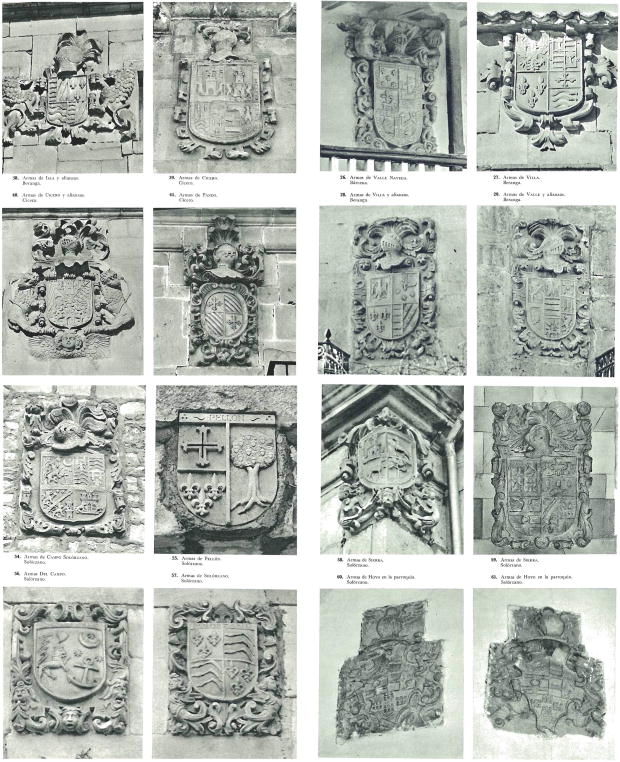
Maria del Carmen González Echegaray, «Escudos de Cantabria», 5 volumes, Volume I Merindad de Trasmiera, 376 pages, Volume II, Asturias de Santillana I, 474 pages, Volume III, Asturias de Santillana II, 388 pages, Volume IV, Asturias de Santillana y Bajo Asón, 434 pages, y Volume V, Valle de Sobra, Ruesga, Pas, Liendo, Guriezo y Provincia de Liébana, 314 pages, Legal deposit: Vi. 514-1969, edited by Joaquin Bedia Cano, Santander, printed by H. Fournier, Vitoria, 1969.
Bibliographical reference of century XX.
Classification: Castilian language and In black and white.
Author: González Echegaray, Maria del Carmen..
External links:
- Centro de Estudios Montañeses, Volume I Merindad de Trasmiera.
- Centro de Estudios Montañeses, Volume II, Asturias de Santillana I.
- Centro de Estudios Montañeses, Volume III, Asturias de Santillana II.
- Centro de Estudios Montañeses, Volume IV, Asturias de Santillana y Bajo Ason.
- Centro de Estudios Montañeses, Volume V, Valle de Sobra, Ruesga, Pas, Liendo, Guriezo y Provincia de Liebana.
Internal resources: GonzalezEchegarayMC1969.11.EscudosCantabria, Volume I Merindad de Trasmiera, 34 Mbytes, GonzalezEchegarayMC1969.12.EscudosCantabria, Volume II, Asturias de Santillana I, 31 Mbytes, GonzalezEchegarayMC1969.13.EscudosCantabria, Volume III, Asturias de Santillana II, 26 Mbytes, GonzalezEchegarayMC1969.14.EscudosCantabria, Volume IV, Asturias de Santillana y Bajo Ason, 22 Mbytes and and GonzalezEchegarayMC1969.15.EscudosCantabria, Volume V, Valle de Sobra, Ruesga, Pas, Liendo, Guriezo y Provincia de Liebana, 18 Mbytes.


Heraldic document for Nick Allen Rica II
Escudo de oro, un cabrio de gules, cargado de tres crecientes de plata, acompañado de tres cruces flordelisadas de gules. Crest: Upon a helm, with a wreath Or and Gules, a pomegranate Proper, seeded Gules, slipped and leaved Vert. Mantling: Gules doubled Or. Motto: «Fides et pietas».
2 pages of the heraldic document of Nick Allen Rica II with his coat of arms emblazoned by me. The pages have a heraldic frame with the elements of his coat of arms.
Style keywords: Outlined in sable.
Classification: Personal, Created, Catalogue, Heraldic document, English language and Castilian language.
Bearer: Rica II, Nick Allen.


![Ver [Herrera Casado, A.; 1993] en referencias bibliográficas. Libro abierto, hojas de plata, filo de oro, guardas de gules, tapas de sable.](../css/Libro.Bibliografia.png)
Herrera Casado, A.; 1993
Antonio Herrera Casado, «The Armorial of Aragon», Annals of the Royal Matritense Academy of Heraldry and Genealogy, pages 137-220, Madrid, 1992-1993.


![Ver [Huidobro Moya, J. M.; 2024] en referencias bibliográficas. Libro abierto, hojas de plata, filo de oro, guardas de gules, tapas de sable.](../css/Libro.Bibliografia.png)
Huidobro Moya, J. M.; 2024
José Manuel Huidobro Moya, «La Heráldica Desconocida», 332 pages, Vision Libros, ISBN-13 978-8410039704, Madrid, May 9, 2024.
I’m currently enjoying reading «La Heráldica Desconocida» by José Manuel Huidobro Moya. It’s a remarkable exploration of how heraldry, far from being outdated, remains a relevant and dynamic art form today. The author masterfully delves into the unexpected uses of heraldry in modern society, from luxury brands to institutions, proving that heraldry is still very much alive and ever-evolving. Highly recommended for anyone passionate about history, design, and the lasting significance of heraldry.
I am honored that my interpretation of the coat of arms of the Universidad de Politécnica de Madrid has been included on page 231 of this book. It is a privilege to have made my small contribution to this a meaningful work.
Bibliographical reference of century XXI.
Classification: De bibliotheca, Castilian language and In color.
The author is Huidobro Moya, José Manuel.
Internal resources: Physical book on paper.


![Ver [Iguiniz, J. B.; 1920] en referencias bibliográficas. Libro abierto, hojas de plata, filo de oro, guardas de gules, tapas de sable.](../css/Libro.Bibliografia.png)
Iguiniz, J. B.; 1920
Juan B. Iguiniz, «The National Coat of Arms: A Documented and Illustrated Historical Monograph», Member of the Royal Academy of History, 37 pages, Bouret Widow's Bookstore, Rue Visconti 53, Paris 23, Avenida Cinco de Mayo 45, Mexico 45, printed by Franco-Mexican Printing Company, S.A., calle de la Academia 10, Mexico, 1920.
A work focusing on the national arms of Mexico.
Bibliographical reference of century XX.
Classification: Castilian language and In black and white.
The author is Iguiniz, Juan B..
Internal resources: IguinizJB1920.Mexico.pdf PDF format.


Jonathan Pons Paneque, page of armorial
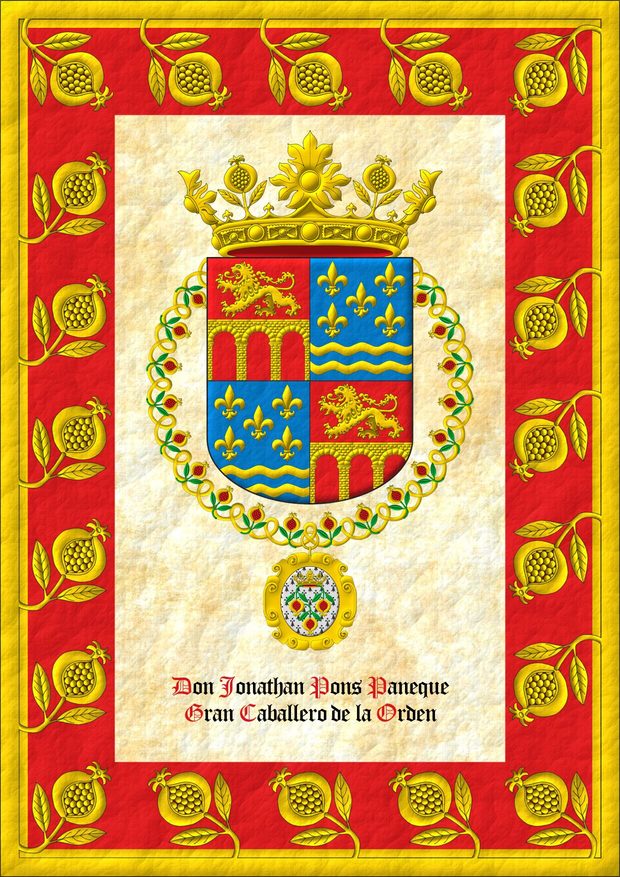
Quarterly: 1 and 4 Gules, a three arch bridge issuant from base and throughout Or; 2 and 3 Azure, five fleurs de lis, in base two bars wavy Or. Crest: A crown of the Sovereign and Most Noble Order of the Pomegranate. The shield is surrounded by the Grand Collar of the Sovereign and Most Noble Order of the Pomegranate.
This is his coat of arms of emblazoned by me for the Roll of Arms of the Sovereign and Most Noble Order of the Pomegranate.
Blazon keywords: Quarterly, Gules, One, Bridge, Issuant from base, Throughout, Or, Azure, Five, Fleur de lis, In base, Two, Fess, Wavy, Crest and mantling, Crown, Pomegranate, Surrounded and Grand collar.
Style keywords: Pointed, Outlined in sable, Illuminated and Leather.
Classification: Personal, Interpreted, Coat of arms, Armorial roll and Castilian language.
Bearer: Pons Paneque, Jonathan.


Knights Templar, Grand Master number 02
Lozengy Or and Gules. Behind the shield a cross patty Gules.
Classification: Religious, Military, Knights Templar, Interpreted, Doctor, Article, Castilian language and Black and white and color illustrations.
Bearer: Craon, Robert de.


Knights Templar, Grand Master number 04
Or, a chief Gules. Behind the shield a cross patty Gules.
Classification: Religious, Military, Knights Templar, Interpreted, Doctor, Article, Castilian language and Black and white and color illustrations.
Bearer: Tremelay, Bernard de.


Knights Templar, Grand Master number 05
Azure, two barbels addorsed Argent. Behind the shield an eight-pointed cross patty Gules.
I have had the honour of writing this article about André de Montbard and its coat of arms within a series of 23 articles about the heraldry of the Grand Masters of the Temple.Classification: Religious, Military, Knights Templar, Interpreted, Doctor, Article, Castilian language and Black and white and color illustrations.
Bearer: Montbard, André de.


Knights Templar, Grand Master number 12
Argent, a cross Azure. Behind the shield a cross patty Gules.
Classification: Religious, Military, Knights Templar, Interpreted, Doctor, Article, Castilian language and Black and white and color illustrations.
Bearer: Hérail, Gilbert.


Knights Templar, Grand Master number 19
Vair. Behind the shield an eight-pointed cross patty Gules.
Classification: Religious, Military, Knights Templar, Interpreted, Doctor, Article, Castilian language and Black and white and color illustrations.
Bearer: Vichiers, Renaud de.

![Ver [Labandeira Fernández, A.; 1977] en referencias bibliográficas. Libro abierto, hojas de plata, filo de oro, guardas de gules, tapas de sable.](../css/Libro.Bibliografia.png)
Labandeira Fernández, A.; 1977
Amancio Labandeira Fernández, «The Passo Honroso of Suero de Quiñones. Introduction and edition by Amancio Labandeira Fernández», 438 pages, 24 plates, 8 genealogical trees, Fundación Universitaria Española, Collection Clásicos Olvidados of Espasa-Calpe, Madrid, 1977.
This edition, written by Clemente Bravo Guarida, provides an updated account of the famous «Passo Honroso», based on [Rodríguez de Lena, P.; Century XVI], undertaken by the renowned knight Suero de Quiñones and his 9 companions against 68 knights in 1434 at the bridge of Órbigo.
Bibliographical reference of century XX.
Classification: Castilian language.
Author: Labandeira Fernández, Amancio.


![Ver [Labara Ballestar, V. C.; 2019] en referencias bibliográficas. Libro abierto, hojas de plata, filo de oro, guardas de gules, tapas de sable.](../css/Libro.Bibliografia.png)
Labara Ballestar, V. C.; 2019
Valeriano C. Labara Ballestar, «The municipal symbols of Candasnos (Huesca)» [Emblemata; 2019; Volumen XXV, page 341-368], Emblemata Aragonese Magazine about Emblems (E. R. A. E.), Baron of Valdeolivos Emblematic Chair, of the Fernando el Catolico Institution, of the Centre of Scientific Research (C. S. I. C.) and of the Government of Zaragoza, ISSN 1137-1056, Legal deposit Z.3.937 1996, printed by Copy Center Digital, Zaragoza, 2019
Bibliographical reference of century XXI.
Classification: Magazine and Castilian language.
The author is Labara Ballestar, Valeriano C..
Here are the articles quoting this reference:
- Candasnos, municipality of
- Crown of the municipality of Candasnos
- Hatching technique for the arms and crown of the Municipality of Candasnos
- Hatching technique for the arms of the Municipality of Candasnos
- Municipality of Candasnos, outlined
- Municipality of Candasnos, plain tincture
- Municipality of Candasnos, schema 1x3
- Plain tincture for the arms and crown of the Municipality of Candasnos


![Ver [Liñán y Eguizábal, J. de; 1911] en referencias bibliográficas. Libro abierto, hojas de plata, filo de oro, guardas de gules, tapas de sable.](../css/Libro.Bibliografia.png)
Liñán y Eguizábal, J. de; 1911
José de Liñán y Eguizábal, Count of Doña Marina, «Armorial of Aragon», printed by Establecimiento Tipográfico de L. Pérez, Huesca, 1911.
This book is part of a collection that also includes: «Heraldic Mottos» and «Heraldic Dictionary».
A facsimile edition exists, edited by Guillermo Redondo Veintemillas and Alberto Montaner Frutos, published by Institución Fernando el Católico, Zaragoza, 1994.
Bibliographical reference of century XX.
Classification: De bibliotheca, Armorial roll, Dictionary, In black and white and Castilian language.
Author: Liñán y Eguizábal, José de.
External resource:
Internal resources: LinanEguizabalJ1911.ArmorialDeAragon.Color.pdf PDF version scanned in color, although the book is in black and white, it looks more natural, LinanEguizabalJ1911.ArmorialDeAragon.BN.pdf PDF version scanned in black and white, it looks less natural and Facsimile edition in physical paper format.


Lorena Correa, page of armorial
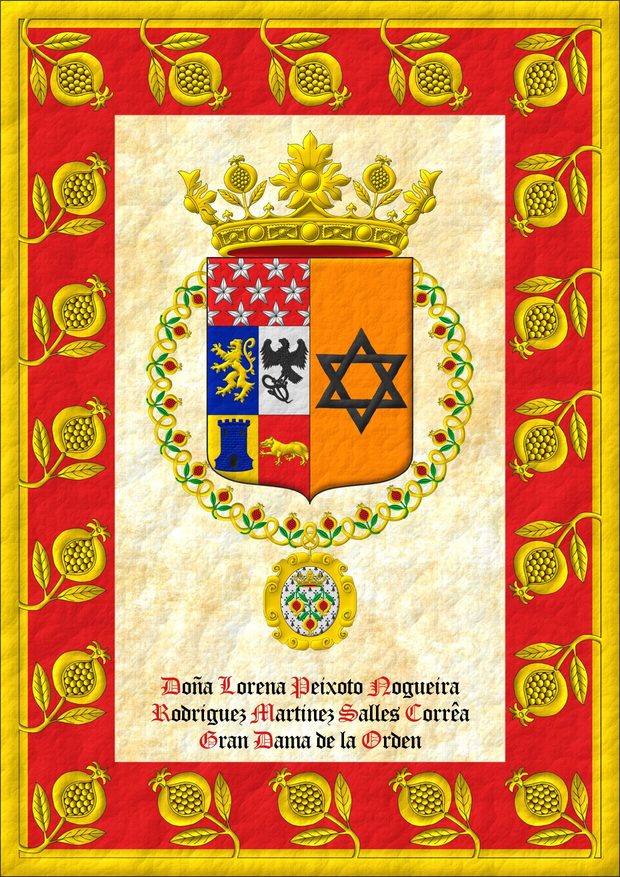
Party per pale: 1 quarterly: 1 Azure, a lion rampant Or, 2 Argent, a falcon rising, grasping in its paws a serpent Sable, 3 Or, a tower Azure, port, windows, and masoned Sable, 4 Gules, a fox passant Or, a chief Gules semé of mullets Argent; 2 Orange, a mullet of six points voided, interlaced Sable. Crest: A crown of the Sovereign and Most Noble Order of the Pomegranate. The shield is surrounded by the Grand Collar of the Sovereign and Most Noble Order of the Pomegranate.
This is her coat of arms of emblazoned by me for the Roll of Arms of the Sovereign and Most Noble Order of the Pomegranate.
Blazon keywords: Party per pale, Quarterly, Azure, One, Lion, Rampant, Or, Argent, Falcon, Rising, Grasping, Claw, Serpent, Sable, Tower, Port and windows, Masoned, Gules, Fox, Passant, Chief, Semé, Mullet, Five, Base (lower 1/3), Orange, Six, Voided, Interlaced, Crest and mantling, Crown, Pomegranate, Surrounded and Grand collar.
Style keywords: Ogee, Outlined in sable, Illuminated and Leather.
Classification: Personal, Interpreted, Coat of arms, Armorial roll and Castilian language.
Bearer: Correa, Lorena.


Malka Gittel Bas Reuven, page of armorial
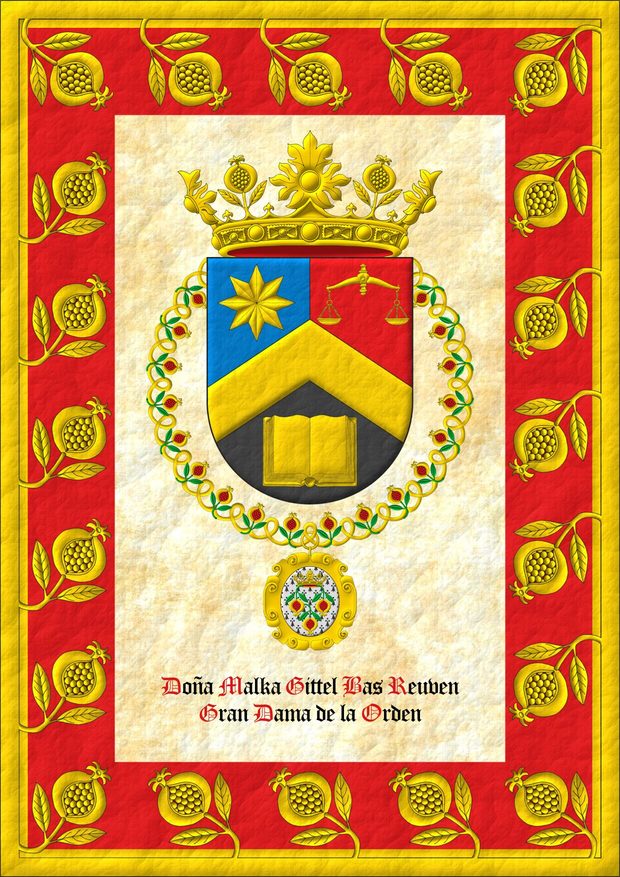
Tierced pallwise inverted Azure, Gules, and Sable; overall a chevron between, in the dexter of the chief, a mullet of six points, in the sinister of the chief a pair of scales, and in base an open book Or.
It has been painted by me, illuminated with lights and shadows, contoured in Sable, with a semi-circular outer contour and with a texturized finish.
Coat of arms of Her Excellency Ratu Muda Malka Bas Reuven emblazoned by me with for the Roll of Arms of the Soberana y Muy Noble Orden de la Granada.
Blazon keywords: Azure, Gules, Sable, Or, One, Six, Tierced pallwise inverted, Overall, Chevron, Between, Dexter, Chief, Mullet, Sinister, Pair of scales, In base, Open book, Book, Crown of the Sovereign and Most Noble Order of the Pomegranate, Crown, Surrounded and Collar.
Style keywords: Outlined in sable, Illuminated and Semi-circular.
Classification: Personal, Interpreted, Boa, Armorial roll and Castilian language.
Bearer: Gittel Bas Reuven, Malka.


Manuel Beninger, page of armorial
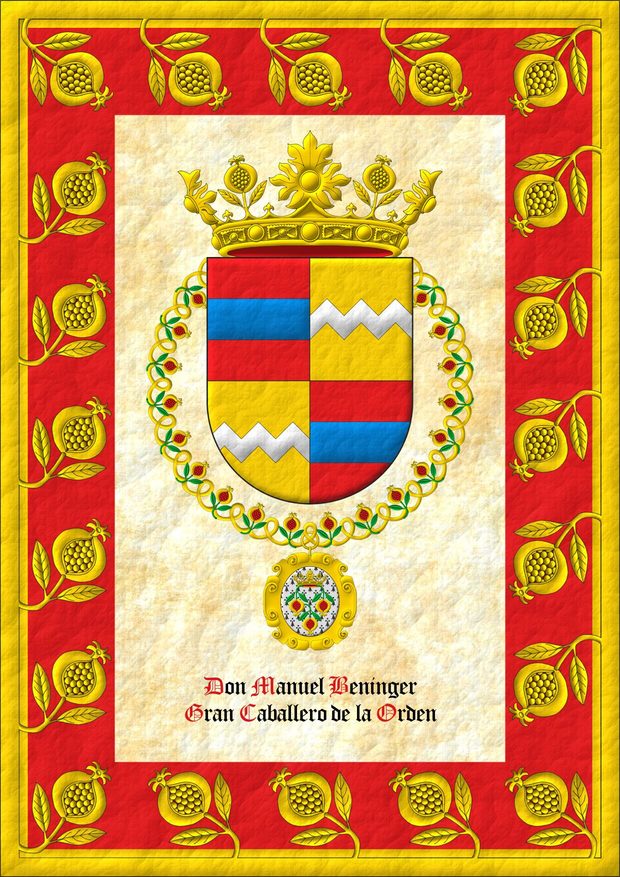
Quarterly: 1 and 4 Gules, a fess Azure; 2 and 3 Or, a fess dancetty Argent. Crest: A crown of the Sovereign and Most Noble Order of the Pomegranate. The shield is surrounded by the Grand Collar of the Sovereign and Most Noble Order of the Pomegranate.
This is his coat of arms of emblazoned by me for the Roll of Arms of the Sovereign and Most Noble Order of the Pomegranate.
Blazon keywords: Quarterly, Gules, One, Fess, Azure, Or, Dancetty, Argent, Crest and mantling, Crown, Pomegranate, Surrounded and Grand collar.
Style keywords: Colour on colour, Metal on metal, Semi-circular, Outlined in sable, Illuminated and Leather.
Classification: Personal, Interpreted, Coat of arms, Armorial roll and Castilian language.
Bearer: Beninger, Manuel.


![Ver [Menéndez Pidal de Navascués, F.; 1982] en referencias bibliográficas. Libro abierto, hojas de plata, filo de oro, guardas de gules, tapas de sable.](../css/Libro.Bibliografia.png)
Menéndez Pidal de Navascués, F.; 1982
Faustino Menéndez Pidal de Navascués, «Medieval Spanish Heraldry I: The Royal House of Leon and Castile», illustrations by Jaime Bugallal y Vela, edited by the Salazar and Castro Institute, (C. S. I. C. Higher Center for Scientific Research), published by Hidalguía, 271 pages, size 24 x 17 cm, includes color plates, Legal deposit M. 22.165-1982, ISBN 84-00-05150-5, printed by Imprenta Sáez, Madrid, 1982.
Index
- Introduction, page 11.
- Abbreviations, page 22.
- Alfonso VII, page 23.
- Fernando II, page 39.
- Alfonso VIII, page 47.
- The spread of the arms of Castile, schema between pages 48 and 47.
- Alfonso IX, page 71.
- Fernando III, page 87.
- Alfonso X, page 109.
- Origins of differentiated arms, schema between pages 48 and 47.
- Sancho IV, page 129.
- Fernando IV, page 139.
- Alfonso XI, page 141.
- Pedro I, page 157.
- Henry II, page 165.
- John I, page 177.
- Henry III, page 185.
- John II, page 189.
- Henry IV, page 195.
- Isabella and Ferdinand, page 199.
- Children of the Catholic Monarchs, page 207.
- Evolution of the arms of Spain, page 213.
- The House of Austria, page 239.
- The Houses of Two Sicilies and Parma, page 241.
- Arms of Castile and Leon outside the Royal House, page 243.
- Index nominum, page 265.
- Index rerum, page 271.
Bibliographical reference of century XX.
Classification: Black and white with color plates and Castilian language.
Author: Menéndez Pidal de Navascués, Faustino.
Bibliographical reference mentioned in the following article:
Internal resources: Physical book in paper.


![Ver [Menéndez Pidal de Navascués, F.; 2014a] en referencias bibliográficas. Libro abierto, hojas de plata, filo de oro, guardas de gules, tapas de sable.](../css/Libro.Bibliografia.png)
Menéndez Pidal de Navascués, F.; 2014a
Faustino Menéndez Pidal de Navascués, «Los emblemas heráldicos: novecientos años de historia», Royal Cavalry Armory of Seville, Culture and Nobility Collection, 508 pages, ISBN.13 9788494139208, Seville, 2014.
Bibliographical reference of century XXI.
Classification: In color and Castilian language.
Author: Menéndez Pidal de Navascués, Faustino.
Internal resources: Physical book.


![Ver [Menéndez Pidal de Navascués, F.; 2018] en referencias bibliográficas. Libro abierto, hojas de plata, filo de oro, guardas de gules, tapas de sable.](../css/Libro.Bibliografia.png)
Menéndez Pidal de Navascués, F.; 2018
Faustino Menéndez Pidal de Navascués, «Los sellos en nuestra Historia», published by the Royal Academy of History and the Official State Gazette, 478 pages, ISBN.10 8434024683, ISBN.13 9788434024687, Madrid, 2018.
This work is a contribution to the studies on sigillography in Spain. It compiles the experience of the author, whose initial research on this subject was published in the 1980s. After an overview of the earliest evidence of seals in the world, the book presents a comprehensive collection of the types used in Spain, from pre-Roman times to the present day, including those of Muslims and Jews. The seals are not merely juxtaposed, but their mutual relationships and the human causes of their existence and graphic content are explained. The text is complemented by a photographic repertoire that facilitates better understanding.
Table of contents
- 1. The study of seals.
- 2. A human invention.
- 3. Historical testimonies, origins, and early diffusion.
- 4. Pre-Roman and Roman Spain.
- 5. Early medieval seals.
- 6. Subscription seals.
- 7. Subscription seals and their derivatives I.
- 8. Subscription seals and their derivatives II.
- 9. Subscription seals and their derivatives III.
- 10. Subscription seals and their derivatives IV.
- 11. Forged matrices.
- 12. New sealing techniques.
- 13. Non-diplomatic seals.
Bibliographical reference of century XXI.
Classification: Castilian language and In color.
The author is Menéndez Pidal de Navascués, Faustino.
Internal resources: MenendezPidalDeNavascuesF2018Sellos.pdf PDF format.


![Ver [Messía de la Cerda y Pita, L.; 1990] en referencias bibliográficas. Libro abierto, hojas de plata, filo de oro, guardas de gules, tapas de sable.](../css/Libro.Bibliografia.png)
Messía de la Cerda y Pita, L.; 1990
Luis Messía de la Cerda y Pita, «Heráldica española, el diseño heráldico», illustrated in color by Calusa y Tete Messia de la Cerda y Gabeiras, edited by Aldaba Ediciones SA Madrid, 1990.
Bibliographical reference of century XX.
Classification: Castilian language and Black and white and color illustrations.
The author is Messía de la Cerda y Pita, Luis.
The following articles cite this bibliographic reference:
- Baztanes of Navarre
- Philip of Castile, Infante
- Pile issuant from the base in the Dictionary of the Spanish Language
Internal resources: Paper book.


![Ver [Mogrobejo Zabala, E. de; 1991] en referencias bibliográficas. Libro abierto, hojas de plata, filo de oro, guardas de gules, tapas de sable.](../css/Libro.Bibliografia.png)
Mogrobejo Zabala, E. de; 1991
Endika de Mogrobejo Zabala, «Blasones y Linajes de Euskalerria», 10 volumes, Volume I A-Alcerreca, Volume II Alciba-Angui, Volume III Angulo-Astu, Volume IV Astun-Bun, Volume V Busta-Elua, Volume VI Elus-Gorniz, Volume VII Gordu-Laca, Volume VIII Lacar-Merca, Volume IX Mere-Salez, Volume X Salinas-Z, edited by Editorial Amigos del Libro Vasco, printed by Grafo SA, ISBN of the complete work 84-7886-026-6, legal Deposit BI-469-1991, Bilbao, 1991.
Bibliographical reference of century XX.
Classification: De bibliotheca, Black and white with color plates and Castilian language.
Author: Mogrobejo Zabala, Endika de.


![Ver [Mogrovejo de la Cerda, J.; 1636] en referencias bibliográficas. Libro abierto, hojas de plata, filo de oro, guardas de gules, tapas de sable.](../css/Libro.Bibliografia.png)
Mogrovejo de la Cerda, J.; 1636
Juan Mogrovejo de la Cerda, «Árbol de los Veras compuesto por Alonso López de Haro, Criado de Su Majestad y Ministro de su Real Consejo de las Órdenes y Cronista de los Reinos de Castilla y León», bound in original parchment, Milan, 1636.
Contents
The book contains a total of 66 main genealogical trees, each with an average of 28 nodes/persons, totaling over 1700 nodes. Additionally, it includes 41 lines of descent with approximately 1150 individuals. The content is composed of:
- Title page with the coat of arms of the Veras.
- Errata and additions.
- Dedication.
- Warnings and introduction by Juan Mogrovejo de la Cerda, folios 1 to 4.
- Tree of the Veras, folios 6 to 66, with 61 genealogical trees.
- Eulogies of five Christian princes known for their virtue and valor, with trees of their descendants up to the Count of La Roca, folios 67 to 72.
- Linear trees of descent from Don Fernando Carlos Antonio de Vera, Doña María Antonia de Vera y Tovar, and Doña Catalina de Vera, folios 73 to 114, with 41 trees.
- Limitations of the work on folio 115.
- Indexes with handwritten corrections, folios 116 to 122.
- Additions to the edition, including a genealogical tree of Don Luis Francisco de la Cerda Sandobal y Rojas, Marqués de Alcalá.
- Additional handwritten documents attached but not bound.
In the previous image, The canting arms of Juan Antonio de Vera y Zúñiga, Count of La Roca, in this book about his genealogy, are canting because «vair~veros~Vera».
The motto in the beak of his sable eagle is «Veritas Vincit», although some authors claim that not all his trees honor this motto [Vera-Ortiz, J.A.; 2009].
The colored version of the coat of arms in this image was painted by me. Blazon: Vair ancient, a bordure gules charged with eight saltires couped Or.
Bibliographical reference of century XVII.
Classification: De bibliotheca, In black and white and Castilian language.
The author is Mogrovejo de la Cerda, Juan.
Here are the articles quoting this reference:
External link:
Internal resources: Physical book..


![Ver [Moreno de Vargas, B.; 1795] en referencias bibliográficas. Libro abierto, hojas de plata, filo de oro, guardas de gules, tapas de sable.](../css/Libro.Bibliografia.png)
Moreno de Vargas, B.; 1795
Bernabé Moreno de Vargas, Perpetual councilor of the City of Mérida, «Discourse on the Nobility of Spain», corrected and added by the same author, A.E., Madrid, printed in the printing house of Antonio Espinosa, year of M. DCC. XCV. 1795. available at Escribano's Bookstore, Carretas street, Madrid, 1795
Bibliographical reference of century XVIII.
Classification: Castilian language and In black and white.
Author: Moreno de Vargas, Bernabé.
Internal resources: MorenoDeVargasB1795.DiscursosDeLaNobleza.pdf.


Moritz Hunzinger, page of armorial
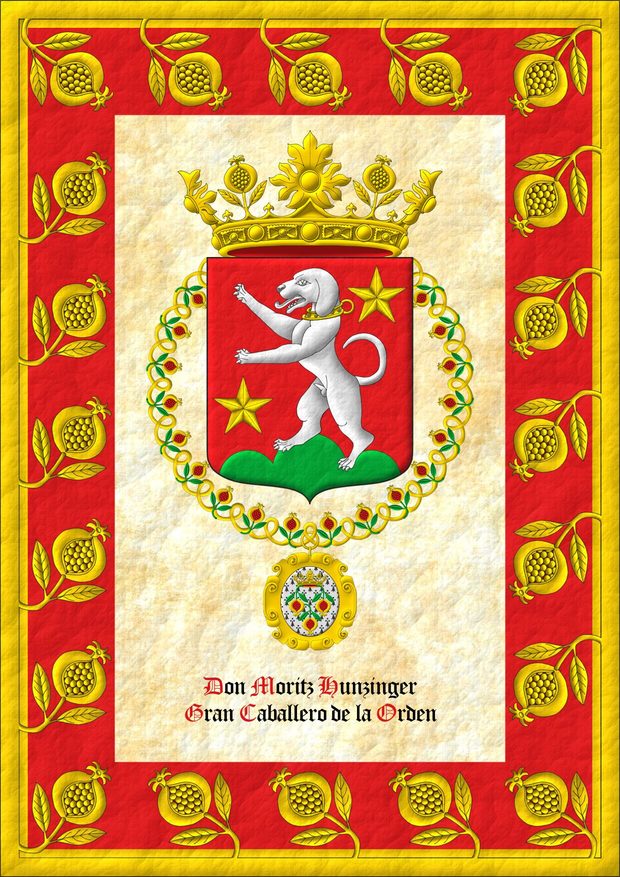
Gules, on a trimount issuant from the base Vert, a talbot rampant Argent, collared Or, between two mullets in bend sinister Or. Crest: A crown of the Soberana y Muy Noble Orden de la Granada. The shield is surrounded by the collar of the Sovereign and Most Noble Order of the Pomegranate.
It has been emblazoned by me, illuminated with lights and shadows, outlined in Sable, with an ogee external shape and with a texturized finishing.
This is the coat of arms of Moritz Hunzinger emblazoned by me for the Roll of Arms of the Soberana y Muy Noble Orden de la Granada.
Blazon keywords: Gules, Vert, Argent, Or, One, Three, Two, On, Trimount, Talbot, Rampant, Collared, Between, Mullet, In bend sinister, Crest, Crown of the Sovereign and Most Noble Order of the Pomegranate, Crown, Surrounded and Collar.
Style keywords: Outlined in sable, Illuminated and Ogee.
Classification: Personal, Interpreted, Boa, Armorial roll and Castilian language.
Bearer: Hunzinger, Moritz.


Nathaniel Bendel, page of armorial
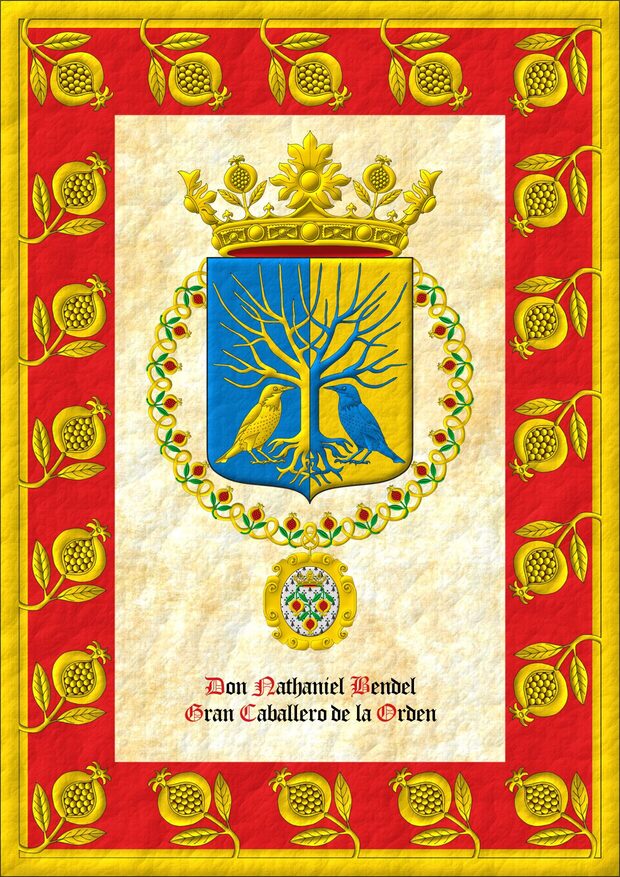
Party per pale Azure and Or, a tree eradicated and blasted between two starlings respectant all counterchanged. Crest: A crown of the Sovereign and Most Noble Order of the Pomegranate. The shield is surrounded by the Grand Collar of the Sovereign and Most Noble Order of the Pomegranate.
This is his coat of arms of emblazoned by me for the Roll of Arms of the Sovereign and Most Noble Order of the Pomegranate.
Blazon keywords: Party per pale, Azure, Or, One, Tree, Erased, Blasted, Counterchanged, Between, Two, Starling, Respectant, Counterchanged (side-by-side), Crest and mantling, Crown, Pomegranate, Surrounded and Grand collar.
Style keywords: Ogee, Outlined in sable and Leather.
Classification: Personal, Interpreted, Coat of arms, Armorial roll and Castilian language.
Bearer: Bendel, Nathaniel.


![Ver [Nieto y Cortadellas, R.; 1957a] en referencias bibliográficas. Libro abierto, hojas de plata, filo de oro, guardas de gules, tapas de sable.](../css/Libro.Bibliografia.png)
Nieto y Cortadellas, R.; 1957a
Rafael Nieto y Cortadellas, «La Generala Santander y sus parientes habaneros los Pontón», 35 pages, 25 centimeters, about the family Sáenz del Pontón, National Archive of Cuba, reprinted edition by the National Archive Bulletin, volume LVI, 1957.
Bibliographical reference of century XX.
Classification: Castilian language.
Author: Nieto y Cortadellas, Rafael.
Bibliographical reference mentioned in the following article:
External resources:


![Ver [Pérez de Vargas, J.; XVI] en referencias bibliográficas. Libro abierto, hojas de plata, filo de oro, guardas de gules, tapas de sable.](../css/Libro.Bibliografia.png)
Pérez de Vargas, J.; XVI
Juan Pérez de Vargas, «Nobiliario», 228 pages with 2 columns, index between pages 224 and 228 ordered by initial but unordered within each initial, 31 x 23 centímeters, kept in the National Library of Spain, signature Mss/3061, it is estimated from the XVI century.
Structure
It follows a fixed structure for each entry: the name of the lineage or person, a horizontal line of separation, a explanatory text, a horizontal line of separation, coat of arms with the with of the column and full-color, a horizontal final line. All of this within the columns, only coming out for some exterior decorations, which I especially like.
My collaboration with the National Library of Spain
I have collaborated with the Department of Manuscripts, Incunabula, and Rare Books of the National Library of Spain to correctly attribute the authorship of this 16th century manuscript armorial titled «Nobiliario», signature Mss/3061, to Juan Pérez de Vargas. It has been quite an honor.
Bibliographical reference of century XVI.
Classification: Manuscript, Armorial roll, In color and Castilian language.
The author is Pérez de Vargas, Juan.
External resources:
- Detail of this armorial in the National Library of Spain.
- Bibliographic record of the National Library of Spain.
- Scanned Armorial in the National Library of Spain.
Internal resources: Pages from 1 to 117 PerezDeVargasJXVI.11.Paginas.001.117.pdf and Pages from 118 to 235 PerezDeVargasJXVI.12.Paginas.118.235.pdf.
Credits: This book belongs to the Biblioteca Nacional de España. License Creative Commons CC-BY. You may share, transform and create from images in the public domain that are accessible in the Hispanic Digital Library.


Peter Ferdinand Gummersbach, page of armorial
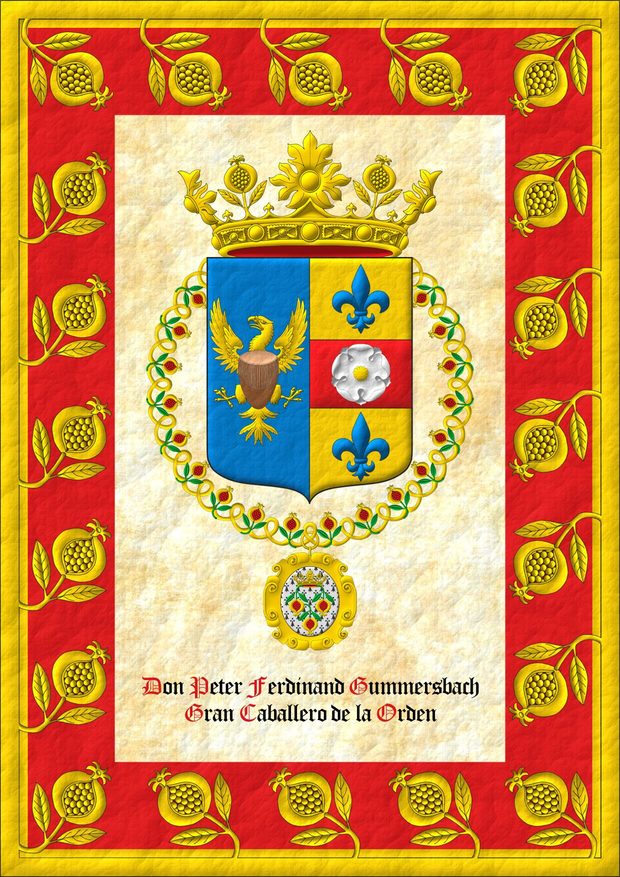
Party per pale: 1 Azure, an eagle displayed Or, charged on the chest with a Royal drum of Bunyoro-Kitara Kingdom proper; 2 Or, on a fess Gules between two fleur de lis Azure, a rose Argent, seeded Or. Crest: A crown of the Sovereign and Most Noble Order of the Pomegranate. The shield is surrounded by the Grand Collar of the Sovereign and Most Noble Order of the Pomegranate.
This is his coat of arms of emblazoned by me for the Roll of Arms of the Sovereign and Most Noble Order of the Pomegranate.
Blazon keywords: Party per pale, Azure, One, Eagle, Or, Charged, Chest, Drum, Royal, Proper, Fess, Gules, Rose, Argent, Seeded, Between, Two, Fleur de lis, In chief, In base, Crest and mantling, Crown, Pomegranate, Surrounded and Grand collar.
Style keywords: Ogee, Outlined in sable, Illuminated and Leather.
Classification: Personal, Interpreted, Coat of arms, Armorial roll and Castilian language.
Bearer: Gummersbach, Peter Ferdinand.


![Ver [Piferrer, F.; 1858] en referencias bibliográficas. Libro abierto, hojas de plata, filo de oro, guardas de gules, tapas de sable.](../css/Libro.Bibliografia.png)
Piferrer, F.; 1858
Francisco Piferrer, «Treatise on Heraldry and Blazonry», illustrated by José Asensio y Torres, 292 pages, revised, corrected, and expanded by the same author, printed by Antonio Espinosa, Madrid, 1858.
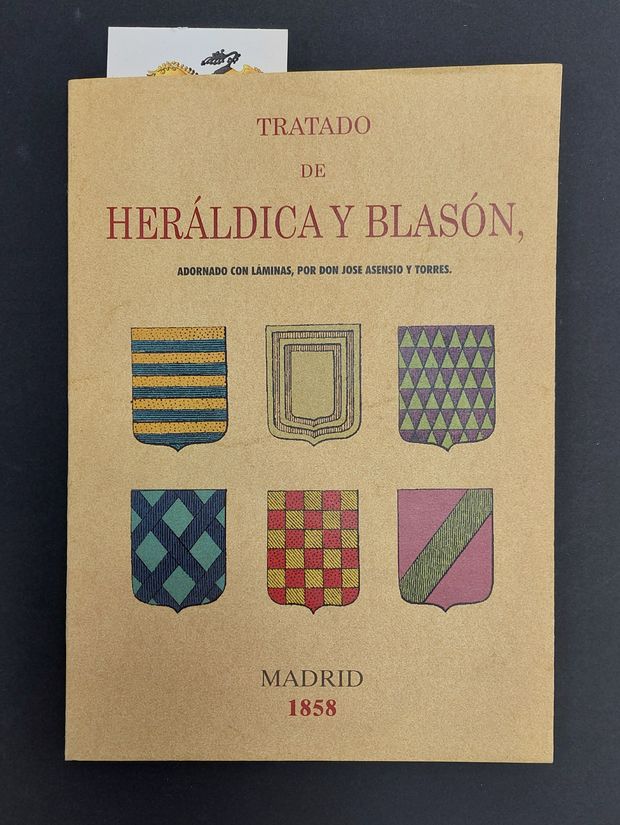
Francisco Piferrer was a 19th-century Spanish writer and historian, specialized in heraldry and genealogy. He was a prominent figure in the dissemination of nobiliary and heraldic history in Spain. Among his most notable works is this «Treatise on Heraldry and Blazon» published in 1858, a fundamental work that is still considered a reference in the field today. His work is valued for its meticulous documentation and for laying the foundations for other heraldic studies in Spain.
Bibliographical reference of century XIX.
Classification: De bibliotheca, Castilian language and In black and white.
The author is Piferrer, Francisco.
External resources:
- University of Granada, book record.
- University of Granada, original scanned PDF, under a Creative Commons Attribution-NonCommercial-NoDerivs 3.0 License.
Internal resources: PiferrerF1858.22.TratadoHeraldicaBlason.UGr.B-014-074_2.pdf is the 1858 edition scanned into a digital PDF format by the University of Granada and A facsimile edition as a physical book on paper.


![Ver [Pineda, Juan d.; 1783] en referencias bibliográficas. Libro abierto, hojas de plata, filo de oro, guardas de gules, tapas de sable.](../css/Libro.Bibliografia.png)
Pineda, Juan d.; 1783
Fray Juan de Pineda, «Libro del Passo Honroso, defendido por el excelente caballero Suero de Quiñones», compiled from an old handwritten book, second edition, 68 pages. printed by Antonio de Sancha, Madrid, 1783.
Fray Juan de Pineda, a Franciscan monk, compiled and abbreviated the original work by [Rodríguez de Lena, P.; Century XVI], in this edition, which is printed in a double-column format.
The book begins with the title «Comiénzase el libro del Passo Honroso: abreviado por fr. Juan de Pineda», which refers to the original work by Rodríguez de Lena. The main text recounts the heroic acts of Suero de Quiñones and his companions, detailing their 30-day defense of the Órbigo bridge against all challengers.
The book includes the full list of the 10 defenders, or maintainers, on page 67, and the 68 conquerors, or adventurers, on pages 67 and 68, and reports the results of the jousts for all of them.
Bibliographical reference of century XVIII.
Classification: Castilian language and In black and white.
The author is Pineda, Juan de.
Bibliographical reference mentioned in the following article:
External resource:
Internal resources: PinedaJ1783.PassoHonroso.pdf PDF Format.


![Ver [Rodríguez de la Vega, A.; XVI] en referencias bibliográficas. Libro abierto, hojas de plata, filo de oro, guardas de gules, tapas de sable.](../css/Libro.Bibliografia.png)
Rodríguez de la Vega, A.; XVI
Alonso Rodríguez de la Vega, «Roll of arms of Spain», 377 hand-numbered pages in Arabic numerals, all coat of arms illustrations are only partially outlined and without tinctures, written according to the title page in the time of Emperor Charles V, in the National Library of Spain, signatures Mss/3330, it is estimated from the XVI century.
Bibliographical reference of century XVI.
Classification: Manuscript, Armorial roll, In black and white and Castilian language.
The author is Rodríguez de la Vega, Alonso.
External resources:
- Detail of this armorial in the National Library of Spain.
- Bibliographic record of the National Library of Spain.
- Scanned Armorial in the National Library of Spain.
Internal resources: RodriguezDeLaVegaAXVI.11.Paginas.001.129, RodriguezDeLaVegaAXVI.12.Paginas.130.258.pdf and RodriguezDeLaVegaAXVI.13.Paginas.259.387.pdf.
Credits: This book belongs to the Biblioteca Nacional de España. License Creative Commons CC-BY. You may share, transform and create from images in the public domain that are accessible in the Hispanic Digital Library.


![Ver [Rodríguez de Lena, P.; Century XVI] en referencias bibliográficas. Libro abierto, hojas de plata, filo de oro, guardas de gules, tapas de sable.](../css/Libro.Bibliografia.png)
Rodríguez de Lena, P.; Century XVI
Rodríguez de Lena, Pero, «Libro del passo honroso defendido por el excelente cavaliero Suero de Quiñones», chronicle, 26 centimeters, Leon, 1434.
Introduction
It is a medieval chronicle written by the notary and chronicler Pero Rodríguez de Lena, documenting the chivalric deeds of Suero de Quiñones and his ten companions during the famous «Passo Honroso» at the bridge of Órbigo, León, in 1434.
From July 10 to August 9, 1434, Suero de Quiñones and 9 knights, the defenders, challenged any knight, the challengers, who wished to cross the bridge to a joust, an event that drew the attention of pilgrims traveling to the shrine of Santiago de Compostela.
The challenge of breaking 300 lances
Suero describes himself as being in prison for this virtuous lady, and he wore an iron collar every Thursday as a sign of this prison. His pledge to break 300 lances or defend the bridge, against all knights in the world who wished to cross it, for thirty days was a way to fulfill the conditions of this metaphorical imprisonment.
To fulfill his vow and prove his honor, Suero set the price for his rescue as the breaking of 300 lances in combat, each with a Milanese iron tip.
Nine other knights joined him in this noble defense at the Passo Honroso.Contents
The original chronicle contains the full account of the 30 days of jousting, during which 164 jousts were held, along with the 22 rules governing the competition.
Suero and his companions vowed to break 300 lances in this chivalric endeavor but were forced to stop after 164 jousts, having fulfilled their oath to defend the bridge.
The chronicle also includes details of the knights who participated and the outcomes of each joust.
The 10 defenders
- Suero de Quinones, broke 10 defenders' lances.
- Lope de Estuñiga, broke 17 defenders' lances.
- Diego de Bazan, broke 16 defenders' lances.
- Pedro de Nava, broke 10 defenders' lances.
- Aluaro, or Suero son of Alvar Gomez, broke 14 defenders' lances.
- Sancho de Ravanal, broke 33 defenders' lances.
- Lope de Aller, broke 12 defenders' lances.
- Diego de Benavides, broke 10 defenders' lances.
- Pedro de los Rios, broke 18 defenders' lances.
- Gomez de Villacorta, broke 24 defenders' lances.
The 68 conquerors
The phrase «had his lance broken» indicates the number of times the conqueror's lance was broken during the jousts by Suero and his companions, the defenders.
- Micer Arnaldo de la Floresta Bermeja, from Germany, rode in 6 courses and had his lance broken 2 times.
- Mosen Juan Fabla, from Valencia, rode in 19 courses and had his lance broken 3 times.
- Mosen Pero Fabla, from Valencia, rode in 5 courses and had his lance broken 3 times.
- Rodrigo de Zayas, from Aragon, rode in 23 courses and had his lance broken 3 times.
- Antón de Funes, aragonés, rode in 15 courses, had his lance broken 3 times.
- Sancho Zapata, aragonés, rode in 19 courses, had his lance broken 3 times.
- Fernando de Liñán, aragonés, rode in 14 courses, had his lance broken 1 time.
- Francisco Muñoz, aragonés, rode in 16 courses, had his lance broken 2 times.
- Mosen Gonzalo de Leori, aragonés, rode in 18 courses, had his lance broken 4 times.
- Juan de Estamari, aragonés, rode in 8 courses, had his lance broken 3 times.
- Jofre Jardín, aragonés, rode in 3 courses, had his lance broken 3 times.
- Francisco de Faces, aragonés, rode in 27 courses, had his lance broken 3 times.
- Mosen Per Davio, aragonés, rode in 23 courses, had his lance broken 2 times.
- Mosen Francés Davio, aragonés, rode in 23 courses, had his lance broken 2 times.
- Vasco de Varrionuevo, rode in 7 courses, had his lance broken 3 times.
- Juan de Soto, rode in 24 courses, had his lance broken 3 times.
- Diego de Mancilla, rode in 1 course, had his lance broken 1 time.
- Rodrigo de Ulloa, rode in 7 courses, had his lance broken 3 times.
- Juan Freyre de Andrada, rode in 3 courses, had his lance broken 3 times.
- Lope de Mendoza, rode in 6 courses, had his lance broken 3 times.
- Juan de Gamoz, catalán, rode in 9 courses, had his lance broken 3 times.
- Mosen Bernal de Requesenes, catalán, rode in 8 courses, had his lance broken 3 times.
- Pedro de Vesga, rode in 21 courses, had his lance broken 3 times.
- Juan de Villalobos, rode in 8 courses, had his lance broken 3 times.
- Gonzalo de Castañeda, rode in 5 courses, had his lance broken 2 times.
- Alonso Quijada, rode in 12 courses, had his lance broken 3 times.
- Bueso de Solís, rode in 11 courses, had his lance broken 3 times.
- Juan de Castellanos, rode in 5 courses, had his lance broken 3 times.
- Gutierre Quijada, rode in 4 courses, had his lance broken 3 times.
- Rodrigo de Quijada, rode in 2 courses, had his lance broken 2 times.
- García Osorio, rode in 8 courses, had his lance broken 3 times.
- Diego Zapata, rode in 20 courses, had his lance broken 3 times.
- Alonso de Cavedo, rode in 19 courses, had his lance broken 3 times.
- Arnoa de Novalles, aragonés, rode in 20 courses, had his lance broken 3 times.
- Ordeño de Valencia, rode in 10 courses.
- Rodrigo de Xuara, rode in 17 courses, had his lance broken 2 times.
- Juan de Merlo, rode in 3 courses, had his lance broken 2 times.
- Alonso Deza, rode in 13 courses, had his lance broken 6 times.
- Galaor Mosquera, rode in 4 courses, had his lance broken 3 times.
- Pero Vázquez de Castilblanco, rode in 22 courses, had his lance broken 3 times.
- Loque de la Torre, rode in 6 courses, had his lance broken 4 times.
- Martín de Arneyda, rode in 14 courses, had his lance broken 3 times.
- Gonzalo de León, rode in 18 courses, had his lance broken 2 times.
- Juan de Soto, rode in 14 courses, had his lance broken 3 times.
- Juan Vázquez de Olivera, rode in 19 courses, had his lance broken 3 times.
- Pedro de Linares, rode in 16 courses, had his lance broken 1 time.
- Antón Deza, rode in 5 courses, had his lance broken 3 times.
- Juan de Carvallo, rode in 20 courses, had his lance broken 2 times.
- Pedro Carnero, rode in 8 courses, had his lance broken 3 times.
- Pedro de Torrecilla, rode in 4 courses.
- Diego de San Román, rode in 9 courses, had his lance broken 2 times.
- Pedro de Negrete, rode in 5 courses, had his lance broken 3 times.
- Alvaro Cubel, rode in 5 courses, had his lance broken 3 times.
- Pedro de Silva, rode in 12 courses, had his lance broken 3 times.
- Juan de Quintanilla, rode in 4 courses, had his lance broken 3 times.
- Gonzalo de Barros, rode in 4 courses, had his lance broken 2 times.
- Martín de Guzmán, rode in 15 courses, had his lance broken 3 times.
- Mosen Riembao de Cervera, catalán, rode in 1 course, had his lance broken 1 time.
- Mosen Franci de Valle, catalán, rode in 1 course, had his lance broken 1 time.
- Esberto de Claramonte, aragonés, the only one who died, rode in 9 courses, had his lance broken 1 time.
- Micer Luis de Aversa, italiano, rode in 5 courses, had his lance broken 1 time.
- Pero Gil de Abreo, portugués, rode in 4 courses, had his lance broken 1 time.
- Arnao Bojué, bretón, rode in 2 courses, had his lance broken 2 times.
- Sancho de Perrera, rode in 2 courses, had his lance broken 2 times.
- Lope de Perrera, rode in 6 courses, had his lance broken 1 time.
- Mosen Francés Perobaste, rode in 12 courses.
- Don Juan de Portugal, rode in 2 courses, had his lance broken 1 time.
- Fernando de Cardón, rode in 15 courses, had his lance broken 3 times.
The results
After 30 days, when the time limit was reached, the tournament of the «Passo Honroso» came to an end, which was recognized throughout Europe.
The defenders broke 166 lances against the conquerors, falling short of the established 300, but the judges counted the remaining 134 as broken, as the feat had been unparalleled. In 30 days, against 68 conquerors, the 10 defenders participated in 725 jousts, more than 70 per defender, more than 2 per day.
According to the numbers I provided earlier, it appears from the list of defenders that they broke 164 lances against the conquerors, and from the list of conquerors that they broke 166 lances. [Bravo Guarida, C.; 1934; page 50] reports similar numbers: 166 lances broken in 727 jousts. [Pineda, Juan d.; 1783; page 50] reports more than 166 lances broken and 727 jousts. In any case, all these numbers are fabulous.
The happy end
«...And to the sound of clarions and drums», Suero de Quiñones, «without his collar, surrenders before his lady, who says to him with a blushing face: Rise, noble Quiñones, you are my husband!» [Bravo Guarida, C.; 1934; page 49].
Bibliographical reference of century XVI.
Classification: Manuscript and Castilian language.
Author: Rodríguez de Lena, Pero.
Here are the articles quoting this reference:


![Ver [Royal Spanish Academy; 1992] en referencias bibliográficas. Libro abierto, hojas de plata, filo de oro, guardas de gules, tapas de sable.](../css/Libro.Bibliografia.png)
Royal Spanish Academy; 1992
Real Academia Española, «Diccionario de la lengua española», known as DRAE, acronym for Diccionario de la Real Academia Española, 83,000 entries, 21st edition, Espasa Calpe, Madrid, 1992.
Bibliographical reference of century XX.
Classification: Dictionary and Castilian language.
Author: Royal Spanish Academy.
External link:


![Ver [Royal Spanish Academy; 2001] en referencias bibliográficas. Libro abierto, hojas de plata, filo de oro, guardas de gules, tapas de sable.](../css/Libro.Bibliografia.png)
Royal Spanish Academy; 2001

Real Academia Española, «Diccionario de la lengua española», known as DRAE, acronym for Diccionario de la Real Academia Española, 22nd edition, Espasa Calpe, Madrid, 2001.
The DRAE's latest edition, the 23rd, is from October 2014, but the current online version corresponds to the 22nd edition with amendments incorporated until 2012.
This bibliographic reference is illustrated with one of my interpretations of the emblem of the Real Academia Española, with its crucible over a bonfire and its motto around it.
Bibliographical reference of century XXI.
Classification: Dictionary and Castilian language.
The author is Royal Spanish Academy.
Bibliographical reference mentioned in the following article:
External resource:


![Ver [Royal Spanish Academy; 2014] en referencias bibliográficas. Libro abierto, hojas de plata, filo de oro, guardas de gules, tapas de sable.](../css/Libro.Bibliografia.png)
Royal Spanish Academy; 2014
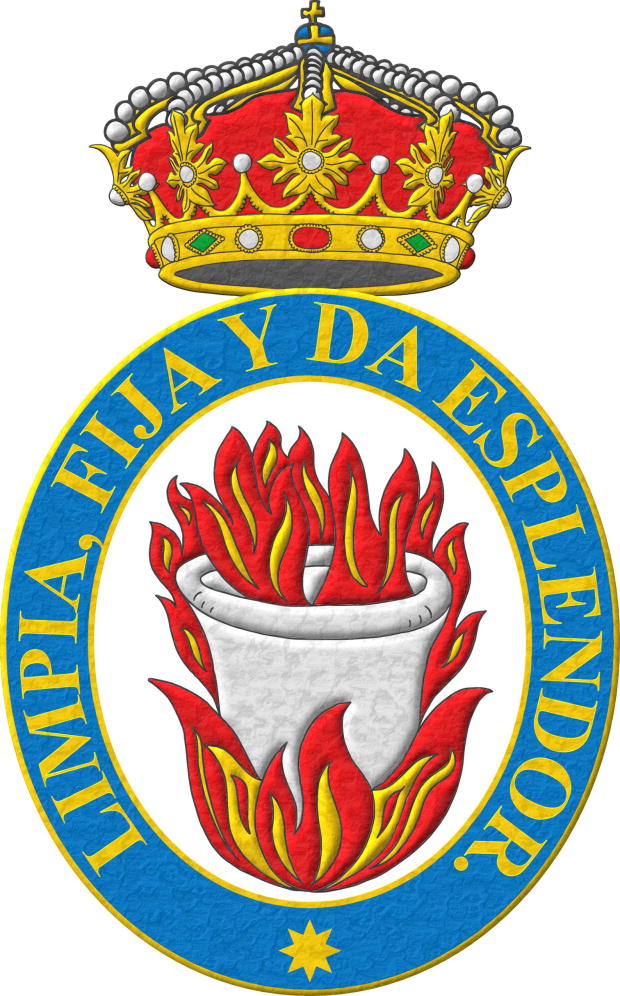
Real Academia Española, «Diccionario de la lengua española», known as DRAE, acronym for Diccionario de la Real Academia Española, 23rd edition, Espasa Calpe, Madrid, 2014.
This bibliographic reference of the DRAE is illustrated with one of my interpretations of the emblem of the Real Academia Española. Oval emblem with its crucible over a bonfire, surmounted by a closed Royal crown and its motto «Limpia, fija y da esplendor», around the emblem in letters of Or on Azure.
Bibliographical reference of century XXI.
Classification: Dictionary and Castilian language.
The author is Royal Spanish Academy.
Bibliographical reference mentioned in the following article:
External resource:


Rubén Arjona Berrocal, page of armorial
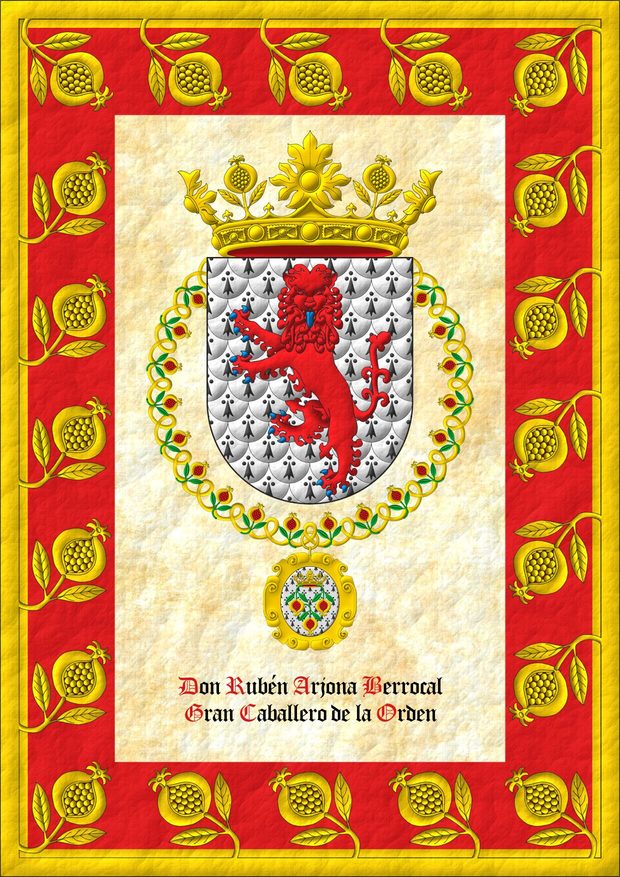
Ermine papelonny, a lion rampant guardant Gules, armed and langued Azure. Crest: A crown of the Sovereign and Most Noble Order of the Pomegranate. The shield is surrounded by the Grand Collar of the Sovereign and Most Noble Order of the Pomegranate.
This is his coat of arms of emblazoned by me for the Roll of Arms of the Sovereign and Most Noble Order of the Pomegranate.
Blazon keywords: Without divisions, Ermine, Papelonny, One, Lion rampant guardant, Gules, Armed, Langued, Azure, Crest and mantling, Crown, Pomegranate, Surrounded and Grand collar.
Style keywords: Semi-circular, Outlined in sable, Illuminated and Leather.
Classification: Personal, Interpreted, Coat of arms, Armorial roll and Castilian language.
Bearer: Arjona Berrocal, Rubén.


Rubén González Lara, page of armorial
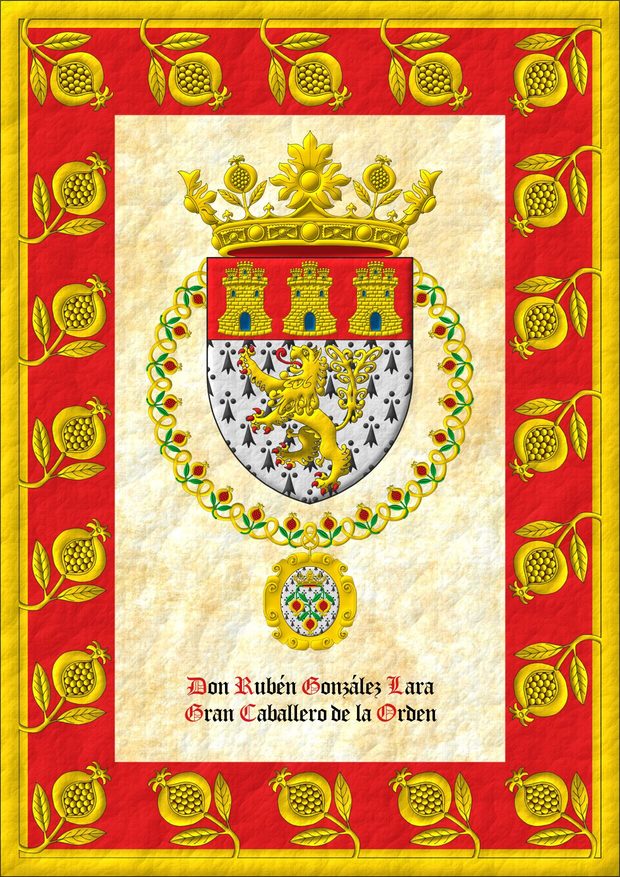
Ermine, a lion rampant double queued Or, armed and langued Gules; a chief Gules, three castles triple-towered Or, port and windows Azure, masoned Sable. Crest: A crown of the Sovereign and Most Noble Order of the Pomegranate. The shield is surrounded by the Grand Collar of the Sovereign and Most Noble Order of the Pomegranate.
This is his coat of arms of emblazoned by me for the Roll of Arms of the Sovereign and Most Noble Order of the Pomegranate.
Blazon keywords: Without divisions, Ermine, One, Lion, Rampant, Tail, Double queued, Or, Armed, Langued, Gules, Chief, Three, Castle, Port and windows, Azure, Masoned, Sable, Crest and mantling, Crown, Pomegranate, Surrounded and Grand collar.
Style keywords: Pointed, Outlined in sable, Illuminated and Leather.
Classification: Personal, Interpreted, Coat of arms, Armorial roll and Castilian language.
Bearer: González Lara, Rubén.


![Ver [Salazar y Mendoza, M. de; 1640] en referencias bibliográficas. Libro abierto, hojas de plata, filo de oro, guardas de gules, tapas de sable.](../css/Libro.Bibliografia.png)
Salazar y Mendoza, M. de; 1640
Miguel de Salazar y Mendoza, chronicler and chaplain of honor to Philip IV, «Formulario de armas», copied by Manuel Antonio Brochero in 1730, manuscript in the National Library of Spain, 11 volumes, volume 1 with 876 pages, call number MSS/11442, volume 2 with 378 pages, call number MSS/11443, volume 3 with 455 pages, call number MSS/11444, volume 4 with 392 pages, call number MSS/11445, volume 5 with 543 pages, call number MSS/11446, volume 6 with 455 pages, call number MSS/11447, volume 7 with 484 pages, call number MSS/11448, volume 8 with 309 pages, call number MSS/11449, volume 9 with 325 pages, call number MSS/11450, volume 10 with 302 pages, call number MSS/11451, volume 11 with 467 pages, call number MSS/11452, totaling approximately 5986 pages, 31 x 21 centimeters, circa 1640.
Dates of the original and copies
In Una Modesta Aportación Española, Juan Cartaya Baños writes that the original «Formulario de Armería» by Miguel de Salazar y Mendoza can be dated to around 1640, and that is the year I use to catalog it. He mentions that there is a 1739 copy that belonged to the King of Arms Zazo y Rosillo. In the National Library of Spain, there are three copies: this copy made by Manuel Antonio Brochero, titled «Formulario de Armería», in 11 volumes, dated by the BNE to the year 1730; another smaller copy made by Tomás Francisco Monleón y Ramiro, titled «Nobiliario o Formulario de Armería», with 980 pages, dated by the BNE to the year 1739; and another even smaller copy, titled «Formulario de Armería», with 404 pages, dated by the BNE to the 18th century.
Indexes and searches
There are indexes in all the volumes, these indexes are alphabetically ordered by the initial letter of the lineage name, but within each letter, the lineages are not strictly ordered, that is, they attempt to follow the order but there are some discrepancies, so you have to go through the entire letter to find the sought lineage. Next to the lineage name on the right, a number appears to locate it within that volume. Therefore, to ensure a thorough search, you need to review the indexes of all 11 volumes. For example, the Salazar lineage can be found in volume 1, in volume 2, in volume 4, etc. This mechanism, though somewhat challenging, allows for searches.
In the 2 images above, which are at the beginning of this section, you can see an example of a search, first, a page from the index of volume 3, dedicated to the letter S, where at the beginning of its second column, you can see the name of the Salmerón lineage, with the number 313 to its right. In the second image, you can see, from volume 3, the page with the number 313 at the top left, with the coat of arms of the Salmerón lineage described but not painted, which is similar to the one that appears in [Salazar y Mendoza, M. de; 1654; volume 5, page 196].
Coat of arms drawings
This armorial contains in volume 1, after the index, an introduction to the organization of coats of arms in quarters, spanning 12 pages and 7 black and white drawings.
Among the lineage descriptions, blank spaces are left, seemingly intended for drawing the coat of arms, many of these spaces are only outlined with the outer edge of a shield ending in a semicircular arch. The most complete coats of arms are those smaller ones that illustrate some lineages in black and white, mainly in the margins, as shown in the previous images. The spaces seem to be more systematically placed in the first volumes, with an average of 2 spaces per page, than in the later volumes.
Bibliographical reference of century XVII.
Classification: Manuscript, Armorial roll, Castilian language and In black and white.
Author: Salazar y Mendoza, Miguel de.
The following article cites this bibliographic reference:
External resources:
- National Library of Spain, Formulario de Armeria, 11 volumes, copy from 1730.
- National Library of Spain, Nobiliario o Formulario de Armeria, 980 pages, copy from 1739.
- National Library of Spain, Formulario de Armeria, 404 pages, copy from the 18th century.
Internal resources: SalazarMendozaM1640.Tomo.01.pdf volume 1 in PDF format, SalazarMendozaM1640.Tomo.02.pdf volume 2 in PDF format, SalazarMendozaM1640.Tomo.03.pdf volume 3 in PDF format, SalazarMendozaM1640.Tomo.04.pdf volume 4 in PDF format, SalazarMendozaM1640.Tomo.05.pdf volume 5 in PDF format, SalazarMendozaM1640.Tomo.06.pdf volume 6 in PDF format, SalazarMendozaM1640.Tomo.07.pdf volume 7 in PDF format, SalazarMendozaM1640.Tomo.08.pdf volume 8 in PDF format, SalazarMendozaM1640.Tomo.09.pdf volume 9 in PDF format, SalazarMendozaM1640.Tomo.10.pdf volume 10 in PDF format and SalazarMendozaM1640.Tomo.11.pdf volume 11 in PDF format.


![Ver [Salazar y Mendoza, M. de; 1654] en referencias bibliográficas. Libro abierto, hojas de plata, filo de oro, guardas de gules, tapas de sable.](../css/Libro.Bibliografia.png)
Salazar y Mendoza, M. de; 1654
Miguel de Salazar y Mendoza, chronicler and chaplain of honor to Philip IV, «Nobiliario de armas», with contributions from Lázaro Díez del Valle and others, manuscript in the National Library of Spain, 7 volumes, volume 1 with 1084 pages, call number MSS/12599, volume 2 with 926 pages, call number MSS/12600, volume 3 with 762 pages, call number MSS/12601, volume 4 with 614 pages, call number MSS/12602, volume 5 with 784 pages, call number MSS/12603, volume 6 with 1106 pages, call number MSS/12604, and volume 7 with 998 pages, call number MSS/12605, total approximately 6274 pages, 22 x 16 centimeters, by various authors with handwriting from different hands, 1654.
Dates and years
In volume 1, page 66, the year 1498 appears first, there are many years written on many pages, often related to events or positions held by the bearers of the described coats of arms. These are years from the 14th century onward. In the different volumes, there are also, though much less frequently, some dates with day, month, and year.
It is notable that, on that same page 66 of volume 1, on the last written line on the right, there appears what seems to be a signature, followed by the preposition «a» which is used in a formal sense to indicate the date on which a document is drafted or signed, and a specific date. It can be seen in the first image at the beginning of this section where « = Silva y Salazar. a 27 de abril de 1654 = » is highlighted in larger and darker font. However, only the second surname in «Silva y Salazar» matches that of the author «Miguel de Salazar y Mendoza», so it would be the signature of a different person or possibly a relative who worked for the author.
As I have mentioned, throughout this volume and the entire armorial, there are other years, generally earlier and some later than 1654. For example, in the 17th century, and specifically in this volume 1, on page 222, midway down on the right, the years 1697 and 1698 appear; on page 334, at the bottom right, I believe the year 1644 can be seen; on page 343, at the bottom right, the year 1638 appears.
To establish a reference year, I set it as 1654, only to have a temporal reference, even though this date appears signed by someone other than the author, on a note of paper smaller in size than the rest of the pages, this note talks about Ariño and is inserted just before the page dedicated to the coat of arms of the Ariño lineage. In any case, as can be observed and given the large number of pages, its writing must have extended over decades, and by several hands and authors, hence the appearance of later annotations such as 1697 and 1698.
The National Library of Spain dates it between 1601 and 1800, which is a very broad range of years.
Miguel de Salazar y Mendoza, was a chronicler and chaplain of honor to Philip IV who reigned from 1621 to 1665, he was the author of the «Formulario de Armeria» which some date to circa 1640, and of which there is a copy from 1739 that belonged to the King of Arms Zazo y Rosillo, also in the National Library of Spain.
Indexes and searches
There is a deteriorated index of all volumes at the beginning of volume 1, this index is alphabetically ordered by the initial letter of the lineage, but within each letter, the lineages are not strictly ordered, so one must read through the entire letter to find the sought lineage. Within each letter, there is an organization by volumes from 1 to 7, next to the name of the lineage on the right appears a number, and with that volume and number, the written coat of arms can be located. This mechanism, with some difficulty, allows for searches.
For example, in the 2 previous images, which are at the beginning of this section, you can see, first, a page from the index which is one of the pages dedicated to the letter S, in its section dedicated to volume 5, at the end of the 3rd column, you can see the name of the Salmerón lineage, with the number 196 to its right. In the second image, you can see, from volume 5, the page with the number 196 at the top right, with the coat of arms of the Salmerón lineage described, but not painted, and is similar to the description in [Salazar y Mendoza, M. de; 1640; volume 3, page 313].
Drawings of coats of arms
This armorial contains, in the first 43% of volume 1, coats of arms with a crest, helmet, mantling, and plume, in the final 57% of volume 1 and in the rest of the volumes from 2 to 7, only the coats of arms without a crest.
The drawn coats of arms are always finished with a rounded arch. The coats of arms without a crest are always in a vertical position. The coats of arms with a crest are tilted toward the dexter (heraldic right), which is the left from the observer’s point of view, and both the coat of arms and the helmet, the mantling, and the plume, these arms with its crest are pre-printed, for this, 2 different plates were used, which can be distinguished because one has a plume of 4 feathers and the other has a plume of 5 feathers, as can be seen in the 2 first images before this section.
The external shape of the arms without a crest and the interior of all the coat of arms arms in this armorial, are drawn in pen. As illustrated in the third image before this section: most of the coats of arms drawings are blank; some are only sketched; others have incomplete quarters; and some are more advanced; but none have tinctures. Only the tree in the Aznar lineage coat of arms in volume 1, page 66, is painted in vert (green), so I categorize this armorial as created in black and white. At the beginning of volume 1, it is noteworthy that among the initiated arms, there frequently appears a tree as the main charge.
Bibliographical reference of century XVII.
Classification: Manuscript, Armorial roll, Castilian language and In black and white.
The author is Salazar y Mendoza, Miguel de.
Bibliographical reference mentioned in the following article:
External resource:
Internal resources: 7 volumes in PDF format. SalazarMendozaM1654.Tomo.1.pdf tomo 1 in PDF format, SalazarMendozaM1654.Tomo.2.pdf tomo 2 in PDF format, SalazarMendozaM1654.Tomo.3.pdf tomo 3 in PDF format, SalazarMendozaM1654.Tomo.4.pdf tomo 4 in PDF format, SalazarMendozaM1654.Tomo.5.pdf tomo 5 in PDF format, SalazarMendozaM1654.Tomo.6.pdf tomo 6 in PDF format and SalazarMendozaM1654.Tomo.7.pdf tomo 7 in PDF format.


Salmerón Cabañas, A.; 2020j
Antonio Salmerón Cabañas, «Heraldry of all Grand Masters», Templar Circle Digital Magazine of the O.T.H. of the Kingdom of Spain, pages 14 and 15, year 2, number 26, Cordoba, October of 2020.
Or, six annulets Gules, 3, 2, and 1. Behind the shield an eight-pointed cross patty Gules.
Knights Templar, Grand Master number 17
I have had the honour of writing this article about Richard de Bures and his coat of arms within a series of 23 articles about the heraldry of the Grand Masters of the Temple.
Bibliographical reference of century XXI.
Classification: Article, Castilian language and Black and white and color illustrations.
Author: Salmerón Cabañas, Antonio.
Internal resources: 20201031.CirculoTemplarioRevista.26.Asc.pdf edition in PDF format.
Classification: Religious, Military, Knights Templar, Interpreted, Doctor, Article, Castilian language and Black and white and color illustrations.
Bearer: Richard, Richard.


Salmerón Cabañas, A.; 2021a
Antonio Salmerón Cabañas, «Heraldry of all Grand Masters», Templar Circle Digital Magazine of the O.T.H. of the Kingdom of Spain, pages 27 and 28, year 2, number 29, Cordoba, February of 2020.
Barry of four per pale counterchanged Or and Gules. Behind the shield a cross patty Gules.
Knights Templar, Grand Master number 06
I have had the honour of writing this article about Bertrand de Blanchefort and his coat of arms within a series of 23 articles about the heraldry of the Grand Masters of the Temple.
Bibliographical reference of century XXI.
Classification: Article, Castilian language and Black and white and color illustrations.
Author: Salmerón Cabañas, Antonio.
Internal resources: 20210214.CirculoTemplarioRevista.29.pdf edition in PDF format.
Classification: Religious, Military, Knights Templar, Interpreted, Doctor, Article, Castilian language and Black and white and color illustrations.
Bearer: Blanchefort, Bertrand de.


![Ver [Salmerón Cabañas, A.; 2024b] en referencias bibliográficas. Libro abierto, hojas de plata, filo de oro, guardas de gules, tapas de sable.](../css/Libro.Bibliografia.png)
Salmerón Cabañas, A.; 2024b
Antonio Salmerón Cabañas, «Interpretation of Six Family Coats of Arms from the Southern Indies Granted between 1538 and 1540», with the original coats of arms from the armorial grants, illustrated shields and step-by-step explanations of the interpretation process following the rules of heraldry, published by Ediciones aContracorriente, aFondo Collection, legal deposit M-23997-2024, ISBN 978-84-941511-7-0, Madrid, 2024.
Contents
- Prologue: Six coats of arms, page 9.
- Peru: New Castile, page 11.
- Geometry: Classical, page 13.
- Blazon i: Alonso Sánchez, conquistador in the province of Peru, coat of arms granted in 1538, page 19.
- Blazon ii: Juan de Argüello, alderman of Popayán and conquistador in Quito, coat of arms granted in 1538, page 29.
- Blazon iii: Juan Barbarán, commander and lieutenant of Pizarro, coat of arms granted in 1539, page 41.
- Blazon iv: Cristóbal Bernal, for his services aiding Pizarro, coat of arms granted in 1539, page 49.
- Blazon v: Diego Rodríguez de Figueroa, conquistador and pacifier of Cuzco, coat of arms granted in 1540, page 57.
- Blazon vi: Baltasar García, pacifier of Puerto Viejo in Peru, coat of arms granted in 1540, page 65.
- Appendix i: Bibliography, page 77.
- Appendix ii: Illustrations, page 83.
- Appendix iii: Vocabulary, page 93.
Bibliographical reference of century XXI.
Classification: Armorial roll, In color and Castilian language.
Author: Salmerón Cabañas, Antonio.
The following article cites this bibliographic reference:
Internal resources: IndiasCyA.20241108.pdf PDF Format and Physical book on paper.


![Ver [Sanz Lacorte, J.; 2007] en referencias bibliográficas. Libro abierto, hojas de plata, filo de oro, guardas de gules, tapas de sable.](../css/Libro.Bibliografia.png)
Sanz Lacorte, J.; 2007
Jesús Sanz Lacorte, «Glosario Heráldico», on-line publication, in the domine armoria.info registered on July of 2004, about 2,650 heraldic terms, more than 2,350 illustrations, 288 pages, estimated size, designed by Bcdreams.com, Barcelona, 28th of May of 2007.
Release date
The release date is taken from Archive.org, checking when this «Heraldic Glossary» appeared for the first time in the record log series.
Illustrations
It contains more than 2,350 illustrations, in color and in black and white, outlined drawings, color shields and photographs. Some of the shields outlined in black and white belong to [Académie internationale d'héraldique; 1952], for example the following pictures:
- picture 86, pointed at each end;
- picture 90, voided;
- picture 272, lion sejant;
- picture 291, combatant;
- picture 292, addorsed or back-to-back;
- picture 297, eagle crowned;
- picture 304, a qualifier for eagle not translated into English, in French «aigle entravaillé»;
- picture 305, osprey a diurnal fish-eating eagle,
- picture 311, two wings addorsed,
- picture 341, trunk,
- picture 360, edged,
- picture 373, hazel nuts,
- picture 378, raguly or ragged,
- picture 395, hemp-bray,
- picture 410, hunting horn or bugle horn,
- picture 434, caltrap,
- picture 464, between,
- picture 466, a qualifier for water and sea not translated into English, in French «afitée»,
- picture 475, aquilon,
- picture 494, diapered,
- picture 504, port and windows Azure, or Gules, or Sinople, or Sable, or Purple, or Or, or Argent;
- ...
Bibliographical reference of century XXI.
Classification: Dictionary and Castilian language.
The author is Sanz Lacorte, Jesús.
External links:
Internal resources: SanzLacorteJ2007.ArmoriaGlosario.pdf.


![Ver [Sarandeses Pérez, F.; 1966] en referencias bibliográficas. Libro abierto, hojas de plata, filo de oro, guardas de gules, tapas de sable.](../css/Libro.Bibliografia.png)
Sarandeses Pérez, F.; 1966
Francisco Sarandeses Pérez, of the Institute of Asturian Studies and of the International Institute of Genealogy and Heraldry, «Heraldry of Asturian Surnames», 408 pages, black and white illustrations, 27 centimeters, includes bibliography and indexes, foreword by H.R.H. The Duke of Calabria, prologue by The Hon. Mr. Julio de Atienza, Baron of Cobos de Belchite, photographs by Mr. Jesús González-Galatea, published by the Asturian Studies Institute of the José María Quadrado Trust, Superior Center for Scientific Research, Provincial Council of Oviedo, printed by Gráficas Europa. Legal Deposit S. 137-1966, Oviedo, 1966.
Cover of the original 1966 edition reproduced in the second facsimile edition of 1994.
Bibliographical reference of century XX.
Classification: Castilian language and In black and white.
Author: Sarandeses Pérez, Francisco.
Bibliographical reference mentioned in the following article:

![Ver [Sarandeses Pérez, F.; 1994] en referencias bibliográficas. Libro abierto, hojas de plata, filo de oro, guardas de gules, tapas de sable.](../css/Libro.Bibliografia.png)
Sarandeses Pérez, F.; 1994
Francisco Sarandeses Pérez, of the Institute of Asturian Studies and of the International Institute of Genealogy and Heraldry, «Heraldry of Asturian Surnames», 408 pages, 89 color plates, black and white illustrations, 27 centimeters, includes bibliography and indexes. prologue to the facsimile edition by Dolores Duque de Estrada Castañeda and Fernando Alós Merry del Val, facsimile edition published by the Royal Institute of Asturian Studies of the José María Quadrado Trust, Superior Center for Scientific Research, printed by Eujoa Artes Gráficas, ISBN 84-87212-26-3, Legal Deposit AS.-1.309/94, Oviedo, 1994.
Reference to the original edition of 1966
The facsimile edition faithfully reproduces the original 1966, [Sarandeses Pérez, F.; 1966], published by the Provincial Council of Oviedo, with a foreword by H.R.H. The Duke of Calabria, prologue by The Hon. Mr. Julio de Atienza, Baron of Cobos de Belchite, and photographs by Mr. Jesús González-Galatea.
Bibliographical reference of century XX.
Classification: De bibliotheca, Castilian language and Black and white with color plates.
The author is Sarandeses Pérez, Francisco.
Internal resources: A facsimile edition as a physical book on paper.


![Ver [Serra i Rosell, P.; 2016] en referencias bibliográficas. Libro abierto, hojas de plata, filo de oro, guardas de gules, tapas de sable.](../css/Libro.Bibliografia.png)
Serra i Rosell, P.; 2016
Pedro Serra i Rosell, architect and Vice President of the SCGHSVN, «Transmission of armorial bearings in the Kingdom of Castile in the 13th century. The arms of Don Enrique de Castilla, son of Fernando III the Saint.», published in Paratge, quaderns d'estudis de genealogia, heràldica, sigil·lografia i nobiliària, published by the Societat Catalana de Genealogia, Heràldica, Sigil·lografia, Vexil·lologia i Nobiliària, SCGHSVN, pages 187-192, issue 29, ISSN 1130-3395, Sant Cugat del Vallès, 2016,
Bibliographical reference of century XXI.
Classification: Article, Castilian language and Black and white and color illustrations.
The author is Serra i Rosell, Pedro.
Internal resources: SerraiRosellP2016.TransmisionCastilla.pdf PDF Format.


Sovereign and Most Noble Order of the Pomegranate, page of armorial
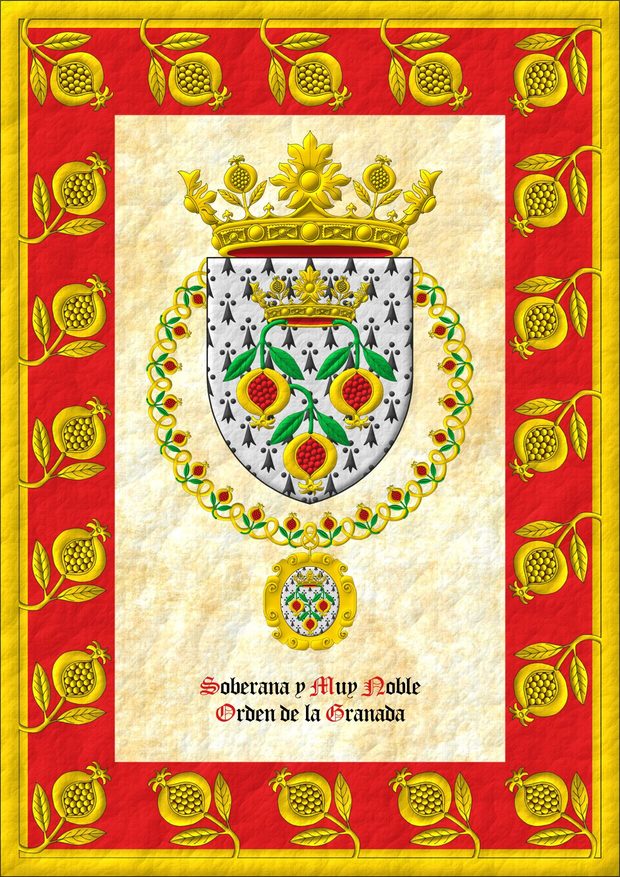
Ermine, three pomegranates inverted Or, seeded Gules, slipped and leaved Vert, ensigned with an open crown, alternating four rosettes of acanthus leaves, visible three, and four pomegranates Or, visible two, lined Gules. Crest: A crown of the Sovereign and Most Noble Order of the Pomegranate. The shield is surrounded by the Grand Collar of the Sovereign and Most Noble Order of the Pomegranate.
Blazon keywords: Without divisions, Ermine, Three, Pomegranate, Reversed, Or, Seeded (pomegranate), Gules, Slipped, Leaved, Vert, On, One, Crown, Alternately, Four, Rosette of acanthus leaves, Visible, Two, Lined, Crest and mantling, Surrounded and Grand collar.
Style keywords: Outlined in sable, Leather and Pointed.
Classification: Socioeconomic, Interpreted, Coat of arms, Armorial roll and Castilian language.
Bearer: Granada, Soberana y Muy Noble Orden de la.


![Ver [Tejero de Rojas y Sandoval, J. F.; XVII] en referencias bibliográficas. Libro abierto, hojas de plata, filo de oro, guardas de gules, tapas de sable.](../css/Libro.Bibliografia.png)
Tejero de Rojas y Sandoval, J. F.; XVII
Juan Francisco Tejero de Rojas y Sandoval, «Linajes de Aragón, Castilla, León, Galicia, Cataluña, Navarra y Vizcaya», 198 hand-numbered pages, each 2, in Arabic numerals, with numerous blank pages not numbered at the beginning and end, hand index on the back of the last page before the back cover, 22 x 17 centimeters, illustrations in the pages 26-29, in the National Library of Spain, signatures Mss/12617, it is estimated from the XVII century.
Unfinished
Although the last page 198 is signed on the back, the book seems unfinished because at the end of the last page there is a last line with a few loose words «Duke of...» which are a sign that it continues on the next page, but the next page is blank.
Bibliographical reference of century XVII.
Classification: Manuscript, In black and white and Castilian language.
The author is Tejero de Rojas y Sandoval, Juan Francisco.
External links:
- Detail of this manuscript in the National Library of Spain.
- Bibliographic record of the National Library of Spain.
- Scanned manuscript in the National Library of Spain.
Internal resources: TejeroRojasSandovalJFXVII.Pagina.11.Linajes.pdf.
Credits: This book belongs to the Biblioteca Nacional de España. License Creative Commons CC-BY. You may share, transform and create from images in the public domain that are accessible in the Hispanic Digital Library.


The arms of Felipe VI of Spain published in La Mesa de los Notables
I am author of the article «Coat of arms of His Majesty King Felipe VI, heraldic interpretation based on the golden ratio» published in La Mesa de los Notables, Principality of Asturias. This article can be accessed and read at the following link: lamesadelosnotables.blogspot.com/2018/03/escudo-de-armas-de-su-majestad-el-rey.html. It is an honour for me to have published in this prestigious blog, and I would like to express my gratitude to you for this opportunity.
Blazon keywords: Gules, Azure, Purpure, Vert, Or, Argent, One, Three, Four, Quarterly, Castle, Triple-towered, Port and windows, Masoned, Lion, Rampant, Crowned, Pallet, Chain, Orlewise, Crosswise, Saltirewise, Charged, In the fess point, Emerald, Enté en point, Pomegranate, Proper, Slipped, Leaved, Inescutcheon, Fleur de lis, Ordered, Bordure, Closed royal crown, Crown, Surrounded and Collar.
Style keywords: Ratio, Outlined, Outlined in sable, Illuminated and Semi-circular.
Classification: Personal, Kingdom of Spain, Article, In color, Castilian language, Interpreted, Schema, Boa, Collage and Photographic.
Bearer: Felipe VI of Spain.


![Ver [Toral y Fernández de Peñaranda, E.; 1970] en referencias bibliográficas. Libro abierto, hojas de plata, filo de oro, guardas de gules, tapas de sable.](../css/Libro.Bibliografia.png)
Toral y Fernández de Peñaranda, E.; 1970
Enrique de Toral y Fernández de Peñaranda, «The Coat of Arms of the City of Úbeda: Notes for a Historical Study», Boletín del Instituto de Estudios Giennenses, pages 33-38 plus 10 illustrations, total 22 pages, number 66, ISSN 0561-3590, Jaen, 1970.
Bibliographical reference of century XX.
Classification: Article, Castilian language and In black and white.
The author is Toral y Fernández de Peñaranda, Enrique.
Internal resources: Provincial Council of Jaén https://www.dipujaen.es/boletinieg/pdf.raw?query=id:0000443974&page=38&lang=es&view=bieg and Rioja University https://dialnet.unirioja.es/descarga/articulo/2070193.pdf.


![Ver [Tosta, M. L.; 2021] en referencias bibliográficas. Libro abierto, hojas de plata, filo de oro, guardas de gules, tapas de sable.](../css/Libro.Bibliografia.png)
Tosta, M. L.; 2021
María Luisa Tosta, «Los Tosta en Venezuela y en el mundo», researchers María Luisa Tosta y Milhone Tosta, 618 pages, includes numerous illustrations, with several on each page, graphic design and layout by María Elena Ayala, printed at Gráficas Lauki, ISBN 978-980-18-2181-6, Legal Deposit MI2021000502, Caracas, 2021.
Through the first five chapters, the authors explore the etymology of the Tosta surname, its historical presence in different parts of the world, and its establishment in Venezuela in the 18th century.
In the intermediate chapters, the book delves into the various branches of the Tosta family, tracing their connections and the genealogical links that span multiple generations.
The final chapters focus on the individual stories of the most prominent members of the Venezuelan branch of the family, revealing intriguing aspects such as their significant contributions to the country's history and other unique characteristics.
With an approach that goes beyond genealogy, the author and the researchers contextualize the lives of the Tosta family within the social, political, and economic frameworks of their times, offering a complete and enriching portrait of this fascinating family.
I am honored to be mentioned in the acknowledgments. It is a privilege to have made my small contribution to this a meaningful work.
Bibliographical reference of century XXI.
Classification: Castilian language and In color.
The author is Tosta, María Luisa.
Internal resources: Galley proofs, private copy, sent by one of the researchers.


![Ver [Uhagón y Guardamino, F. R.; 1904] en referencias bibliográficas. Libro abierto, hojas de plata, filo de oro, guardas de gules, tapas de sable.](../css/Libro.Bibliografia.png)
Uhagón y Guardamino, F. R.; 1904
Francisco Rafael Uhagón y Guardamino, I Marqués de Laurencín, Director de la Real Academia de la Historia, Caballero de la Orden de Calatrava, «Libro de la Cofradía de Caballeros de Santiago de la Fuente, Fundada por los Burgaleses en Tiempo de Don Alfonso XI» noticia bibliográfica, publicada en la Revista de Archivos, Bibliotecas y Museos, impresa por la Tipográfica de la Revista de Archivos, Bibliotecas y Museos, calle de Olid 8, Madrid, 1904.
This article provides a bibliographical account of the illuminated manuscript [Cofradía de Santiago; Century XIV].
Bibliographical reference of century XX.
Classification: Article, Castilian language and In black and white.
Author: Uhagón y Guardamino, Francisco Rafael.
External link:


![Ver [Vera-Ortiz, J.A.; 2009] en referencias bibliográficas. Libro abierto, hojas de plata, filo de oro, guardas de gules, tapas de sable.](../css/Libro.Bibliografia.png)
Vera-Ortiz, J.A.; 2009
Jorge A. Vera-Ortiz, «Linaje emeritense de don Juan Antonio de Vera y Zúñiga, un pícaro conde genealogista y una creencia muy arraigada», Bulletin No. 257 of the Argentine Institute of Genealogical Sciences, pages 27 to 50, Buenos Aires, November-December 2009.
This article examines the lineage of Don Juan Antonio de Vera y Zúñiga, a count whose life and genealogical work are marked by both wit and controversy. The author, Jorge A. Vera-Ortiz, analyzes how deeply rooted beliefs about the lineage of this figure have influenced the historical perception of his legacy. In this way, from 1617 to 1635, the accumulation of studies that appeared exalting the lineage of the Count of La Roca is astonishing. These works were sometimes published under the names of well-known authors and genealogists, and sometimes under less familiar names, but many authors assume that these works were part of the fertile imagination of Juan Antonio de Vera y Zúñiga himself, who published them under pseudonyms to give them greater authority. The book [Mogrovejo de la Cerda, J.; 1636] would be an example of this practice.
Bibliographical reference of century XXI.
Classification: Article and Castilian language.
The author is Vera-Ortiz, Jorge A..
The following article cites this bibliographic reference:
External link:
Internal resources: A digital and partial transcription of this article..


![Ver [Vivar del Riego, J. A.; 2014] en referencias bibliográficas. Libro abierto, hojas de plata, filo de oro, guardas de gules, tapas de sable.](../css/Libro.Bibliografia.png)
Vivar del Riego, J. A.; 2014
José Antonio Vivar del Riego, Graduate in Heraldic Genealogy and Nobility, «Taller de Heráldica: Cómo diseñar y describir un escudo», April of 2012.
Bibliographical reference of century XXI.
Classification: Black and white and color illustrations and Castilian language.
The author is Vivar del Riego, José Antonio.
External link:
Internal resources: VivarDelRiegoJA2014.Documento36925.pdf.


![Ver [Zamora Vicente, A.; 1999] en referencias bibliográficas. Libro abierto, hojas de plata, filo de oro, guardas de gules, tapas de sable.](../css/Libro.Bibliografia.png)
Zamora Vicente, A.; 1999
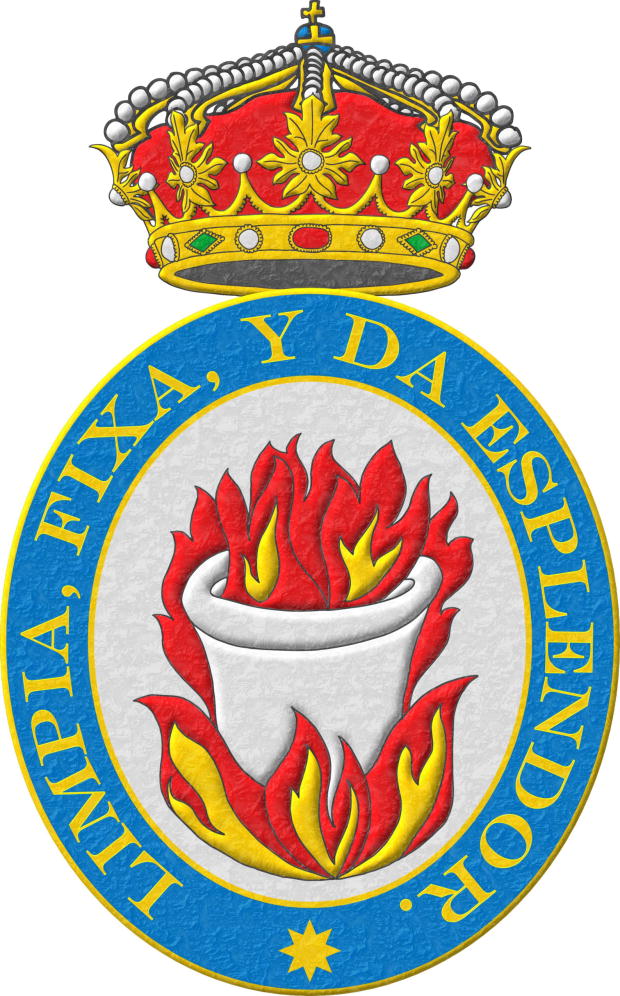
Alonso Zamora Vicente, «Historia de la Real Academia Española», Real Academia Española, Espasa Calpe, Madrid, 1999.
This bibliographic reference is illustrated with one of my interpretations of the emblem of the Real Academia Española. It is an oval emblem in Argent, with its crucible, also in Argent, over a bonfire of Gules and Or and surrounded by its flames, surmounted by a closed Royal crown with 8 arches, 5 of which are visible, and its motto, as originally written «Limpia, fixa, y da esplendor», around it.
Bibliographical reference of century XX.
Classification: Castilian language.
The author is Zamora Vicente, Alonso.
Bibliographical reference mentioned in the following article:
External link:
-
Language
-
Categories of heraldry
-
Divisions of the field
- Without divisions
- Party per pale
- Party per fess
- Party per bend
- Party per bend sinister
- Tierce
- Tierce sinister
- Tierced per pale
- Tierced per fess
- Tierced per bend
- Tierced pallwise inverted
- Quarterly
- Quarterly per saltire
- Gyronny
- Party per fess, the chief per pale
- Party per pale, the sinister per fess
- Party per fess, the base per pale
- Party per pale, the dexter per fess
- Chapé
- Chaussé
- Embrassé
- Contre-embrassé
- Party per chevron
- Enté
- Enté en point
- Flanched
-
Metals
-
Colours
-
Furs
-
Other tinctures
-
Ordinaries and sub-ordinaries
-
Diminutives of the ordinaries
-
Geometric charges
-
Composite ordinaries
-
Inanimate charges from Nature
Atom, Crescent, Diamond, Emerald, Estoile, Increscent, Lightning flash, Moon, Mount, Mullet, Mullet of four points, Orbital, Plough of Ursa Major, Rainbow, Ray of the sun, River, Sea, Snowflake, Sun, Sun in splendour, Sun of May, Trimount, Water and Wave.
-
Vegetal charges from Nature
Acorn, Apple, Apple tree, Ash, Bluebonnet, Camellia, Chrysanthemum, Cinquefoil, Cornflower, Dogwood flower, Double rose, Elm, Fleur de lis, Flower, Gourd, Holm oak, Hop cone, Kapok tree, Laurel, Lily, Linden, Lotus flower, Madonna lily, Mexican cedar tree, Oak, Olive tree, Palm tree, Plantain plant, Pomegranate, Poplar leaf, Rose, Shamrock, Sunflower, Thistle, Tree, Tulip, Vine and Wheat.
-
Animal charges from Nature
Badger, Bald eagle, Barbel, Barn owl, Bear, Beaver, Beetle, Bighorn sheep, Blackbird, Boar, Brach hound, Bull, Doe, Dog, Dolphin, Dove, Eagle, Elephant, Falcon, Female figure, Fish, Flame, Fly, Fox, Frog, Goat, Goldfinch, Goose, Heron, Horse, Hummingbird, Jaguar, Lark, Leopard, Lion, Lion passant, Lion rampant guardant, Lioness, Lynx, Male figure, Martlet, Merino ram, Owl, Panther, Parrot, Peacock, Pelican, Pelican in her piety, Puffin, Quetzal, Raven, Roe deer, Rooster, Savage, Seagull, Serpent, She-wolf, Stag, Starling, Talbot, Tyger, Vulture, Warren hound and Wolf.
-
Parts of natural charges
Arm, Beak, Branch, Caboshed, Chest, Claw, Covert, Dorsal fin, Eagle claw, Ermine spot, Escallop, Feather, Foot (palmiped), Foreleg, Forepaw, Hand, Head, Heart, Hoof, Leaf, Neck, Ostrich feather, Palm frond, Paw, Roe deers' attires, Shoulder, Sprig, Stags' attires, Stem, Swallow-tail, Tail, Tail addorsed, Tail fin, Talon, Tooth, Trunk, Trunk (elephant), Two hands clasped, Two wings in vol, Udder, Wheat spike, Wing and Wrist.
-
Artificial charges
Ace of spades, Anchor, Anvil, Arch, Arm vambraced, Armillary sphere, Arrow, Axe, Bell, Bell tower, Beret, Bonfire, Book, Bookmark, Bow, Branding iron, Bridge, Broken, Buckle, Cannon, Cannon dismounted, Cannon port, Canopy roof, Carbuncle, Castle, Celtic Trinity knot, Chain, Chess rooks, Church, Clarion, Clay pot, Closed book, Club, Column, Comb, Compass rose, Conductor's baton, Cord, Covered cup, Crozier, Crucible, Cuffed, Cup, Cyclamor, Dagger, Double vajra, Drum, Ecclesiastical cap, Fanon, Federschwert, Fleam, Four crescents joined millsailwise, Galician granary, Garb, Gauntlet, Geometric solid, Grenade, Halberd, Hammer, Harp, Host, Hourglass, Key, Key ward, Knight, Knot, Lantern, Letter, Line, Loincloth, Menorah, Millrind, Millstone, Millwheel, Monstrance, Mortar, Mullet of six points pierced, Nail, Non-classic artifact, Norman ship, Number, Oar, Oil lamp, Open book, Page, Pair of scales, Parchment, Pestle, Piano, Pilgrim's staff, Plough share, Polish winged hussar, Port, Portcullis, Potent, Quill, Ribbon, Rosette of acanthus leaves, Sabre, Sackbut, Sail, Scroll, Scythe, Sheaf of tobacco, Ship, Skirt, Spear, Spear's head, Stairway, Star of David, Step, Sword, Symbol, Tetrahedron, Torch, Tower, Trident, Trumpet, Turret, Two-handed sword, Wagon-wheel, Water-bouget, Wheel, Winnowing fan and With a turret.
-
Immaterial charges
Angel, Archangel, Basilisk, Dragon, Dragon's head, Garuda, Golden fleece, Griffin, Heart enflamed, Justice, Mermaid, Our Lady of Mercy, Ouroboros, Paschal lamb, Pegasus, Phoenix, Sacred Heart of Jesus, Saint George, Sea-griffin, Trinity, Triton, Unicorn, Winged hand and Wyvern.
-
External elements
-
Heraldic creations
-
References
-
Formats
-
Keywords on this page
Between, Armorial roll, Article, Azure, Bibliography, Ogee, Crown, Quarterly, De bibliotheca, Outlined in sable, Dictionary, Doctor, Two, In black and white, Black and white with color plates, Black and white and color illustrations, In color, Coat of arms, Schema, Mullet, Personal, Grand collar, Pomegranate, Gules, Illuminated, Interpreted, Motto, Castilian language, Lineage, Manuscript, Military, Knights Templar, Or, Leather, Argent, Without divisions, Religious, Magazine, Surrounded, Sable, Century XVI, Century XVII, Century XVIII, Century XX, Century XXI, Vert, Crest and mantling, Three and One.

